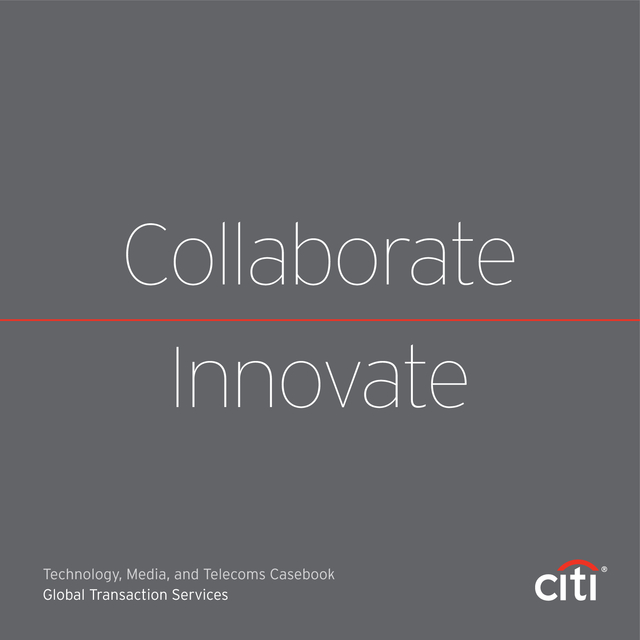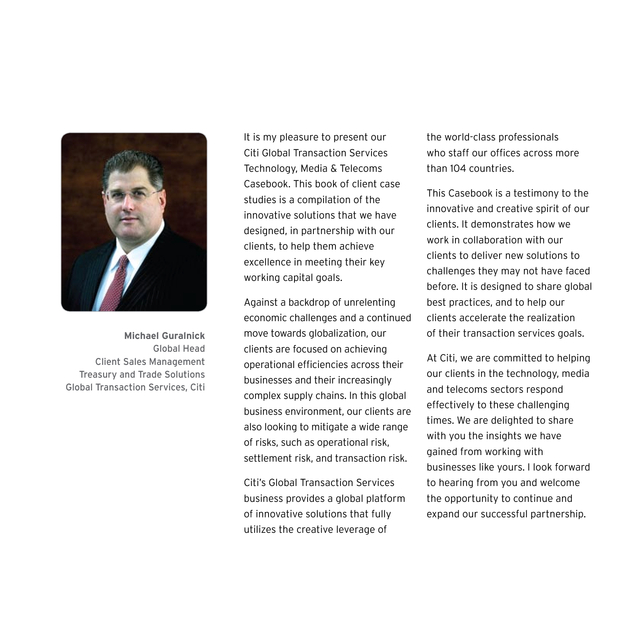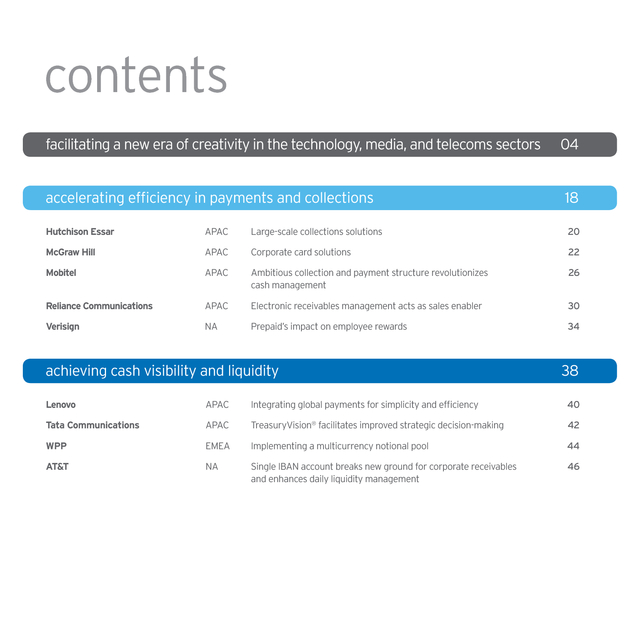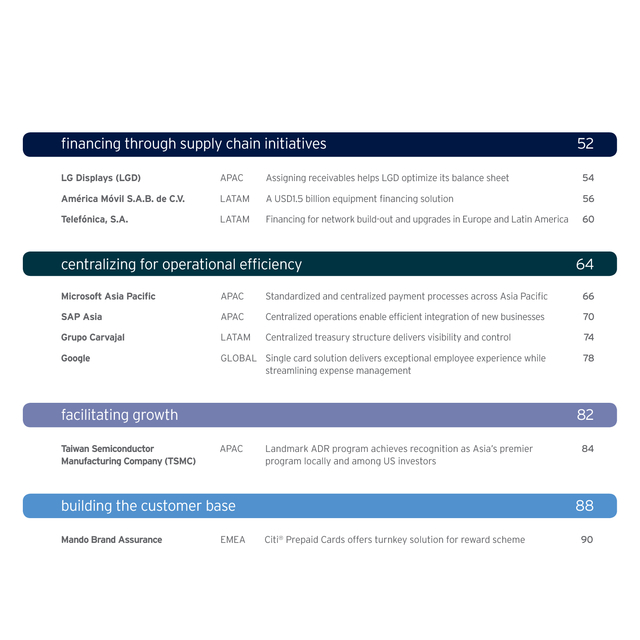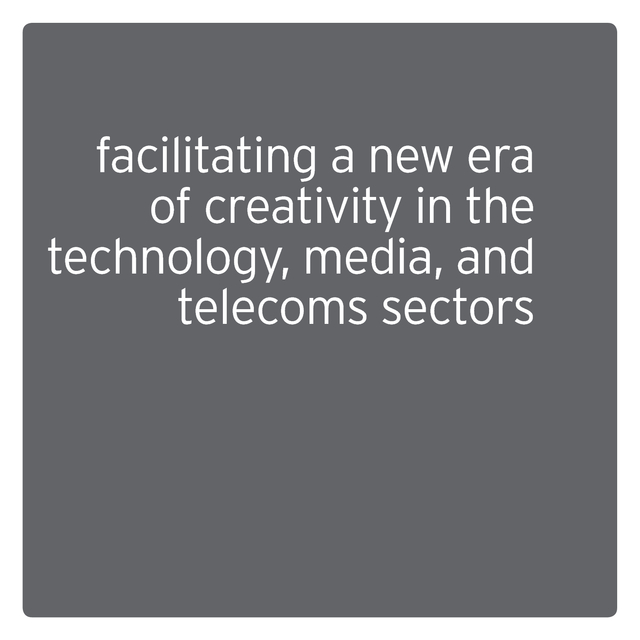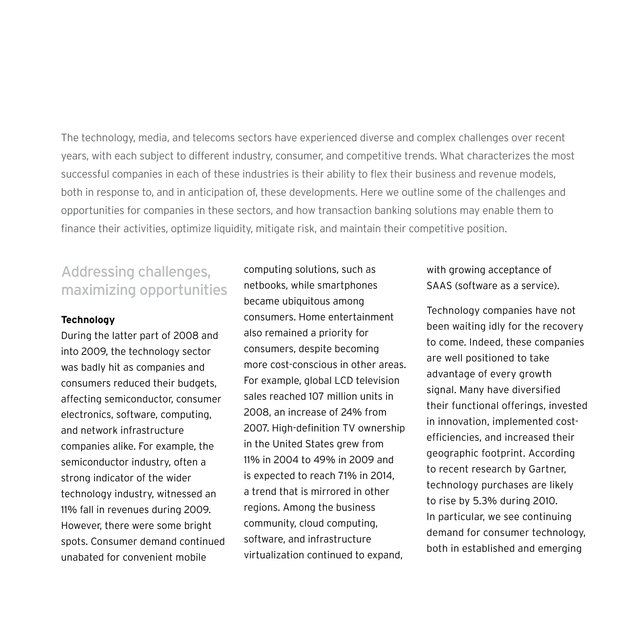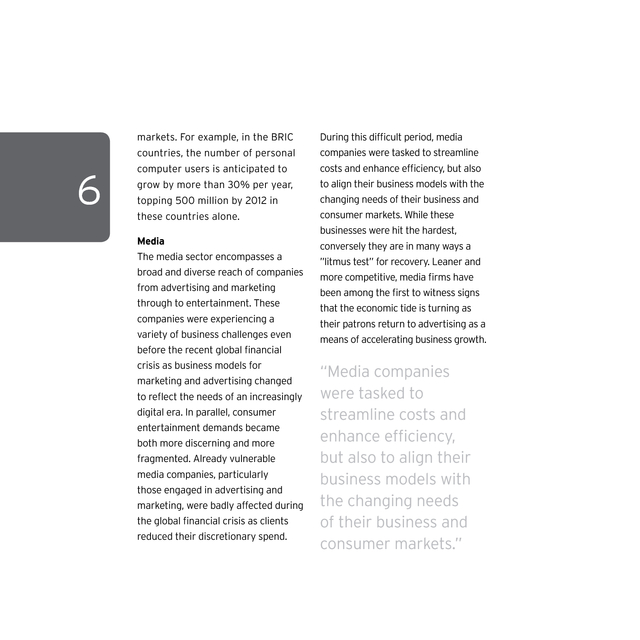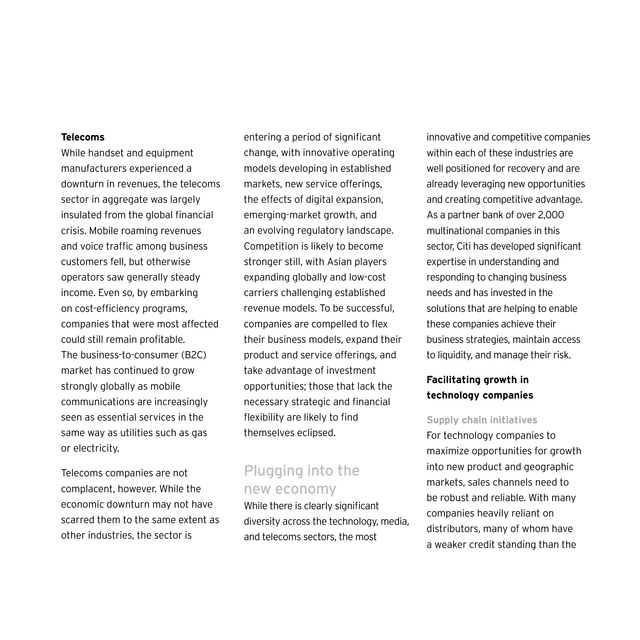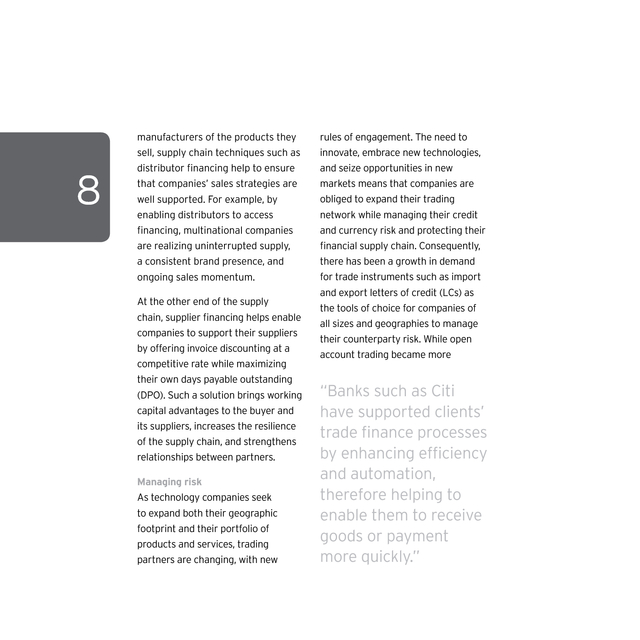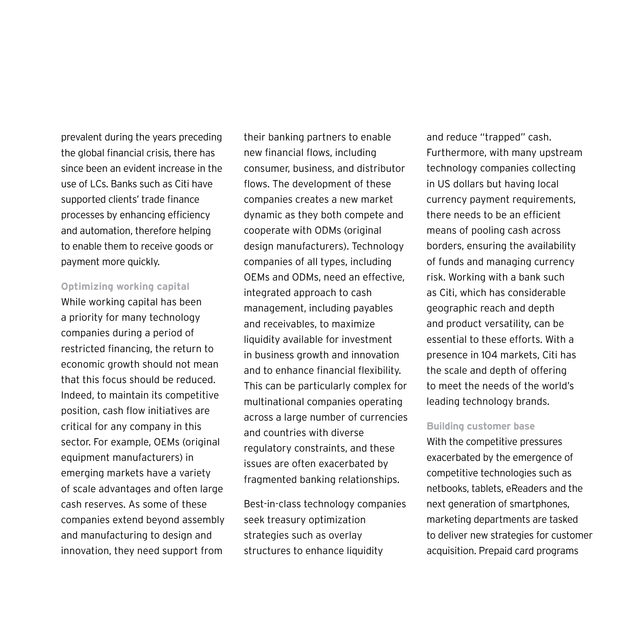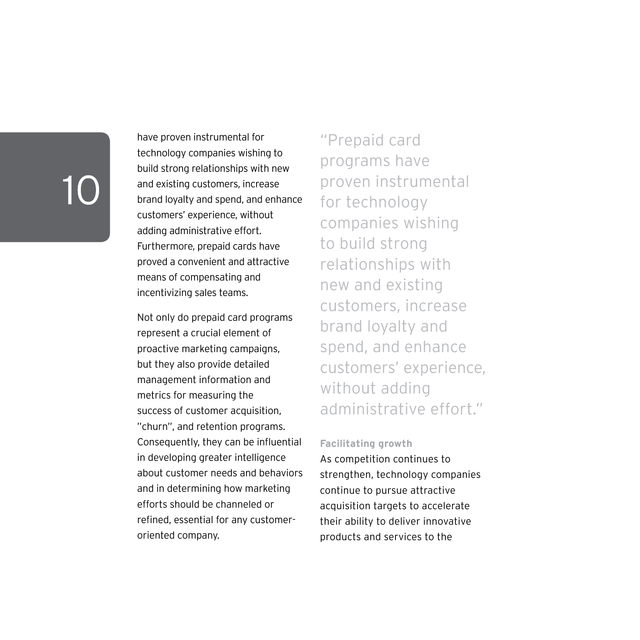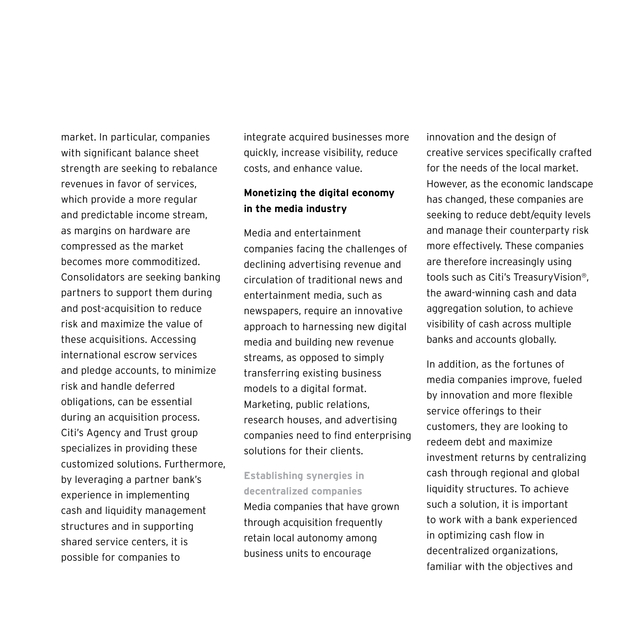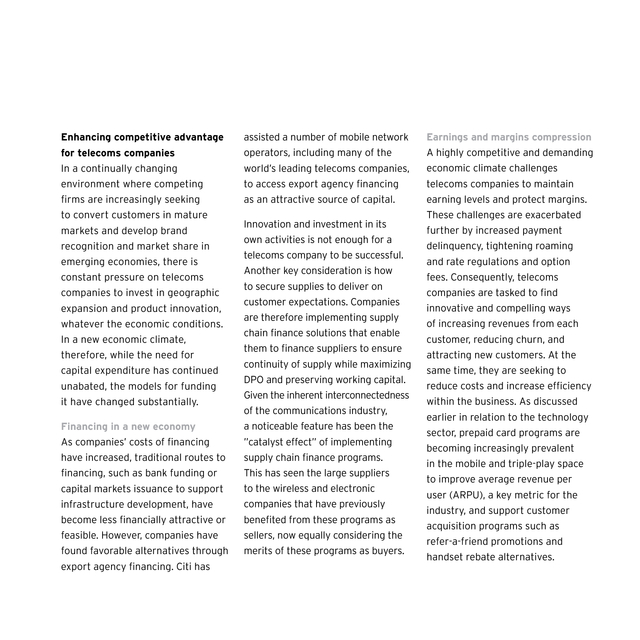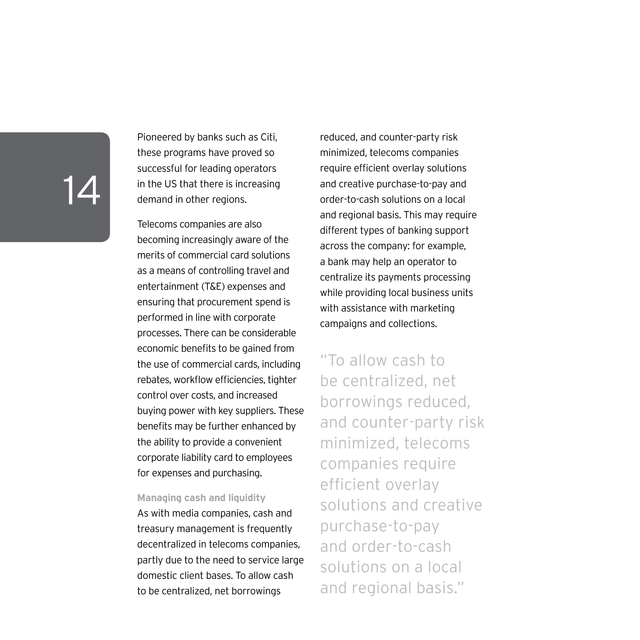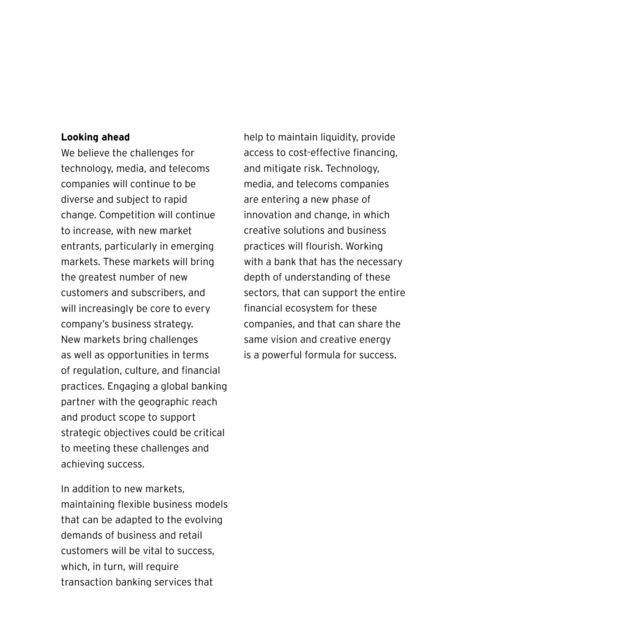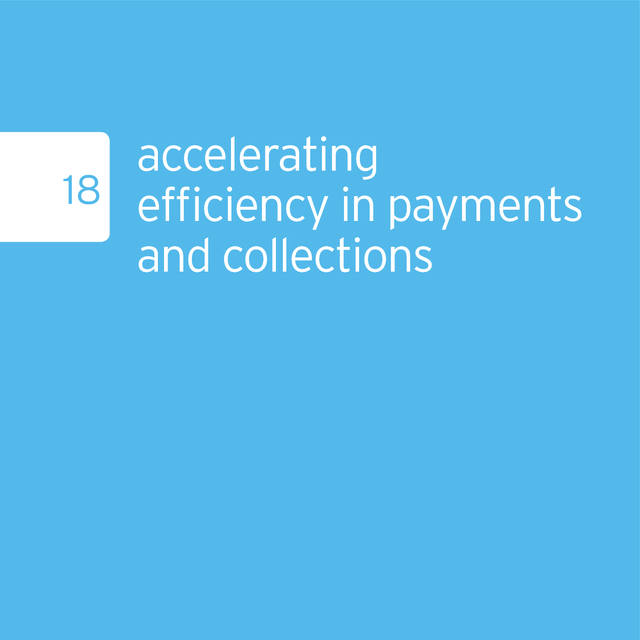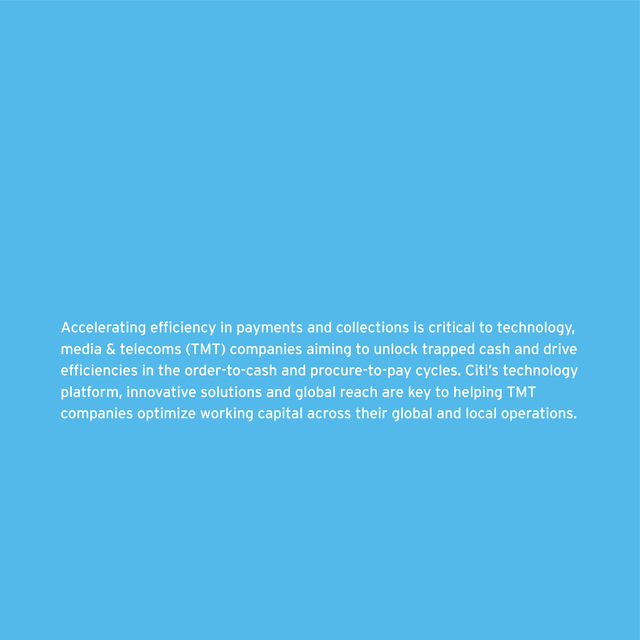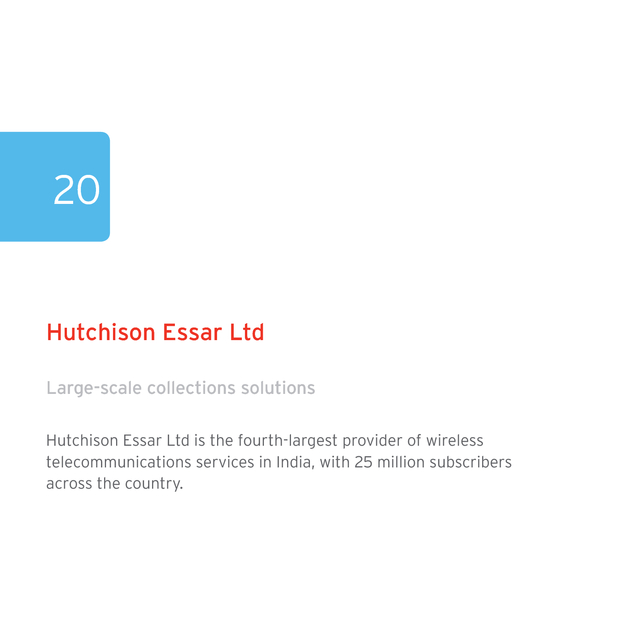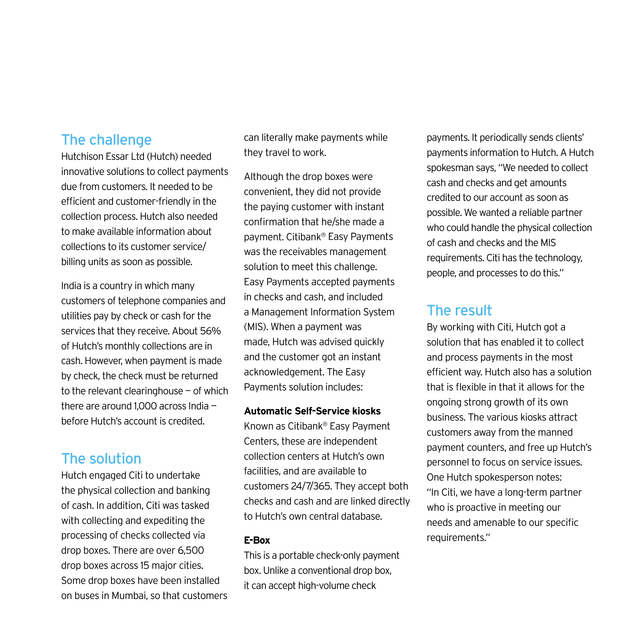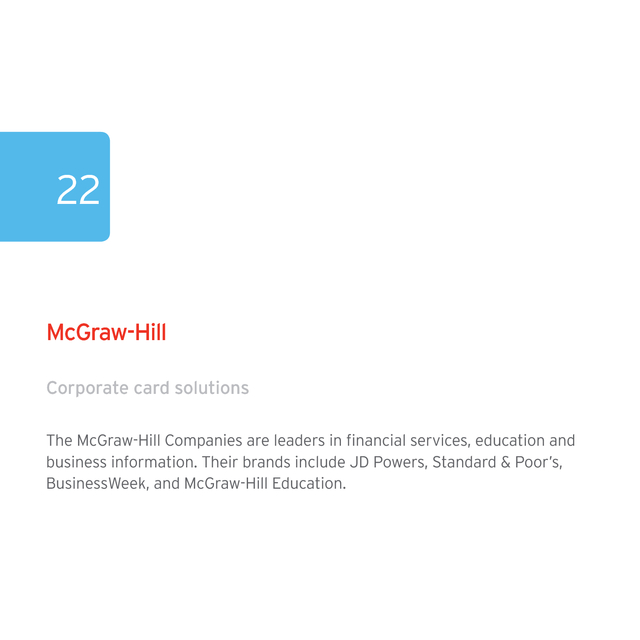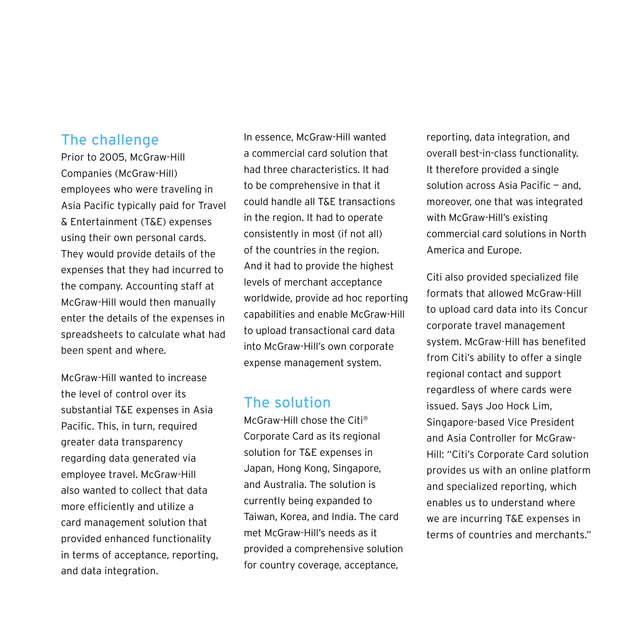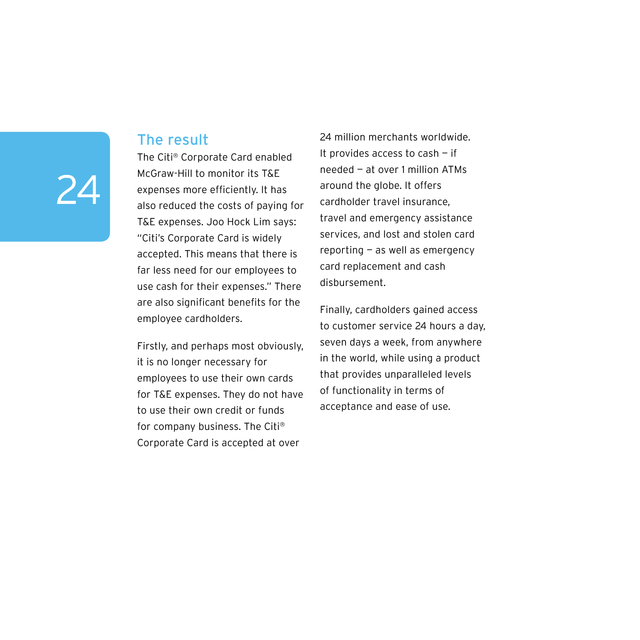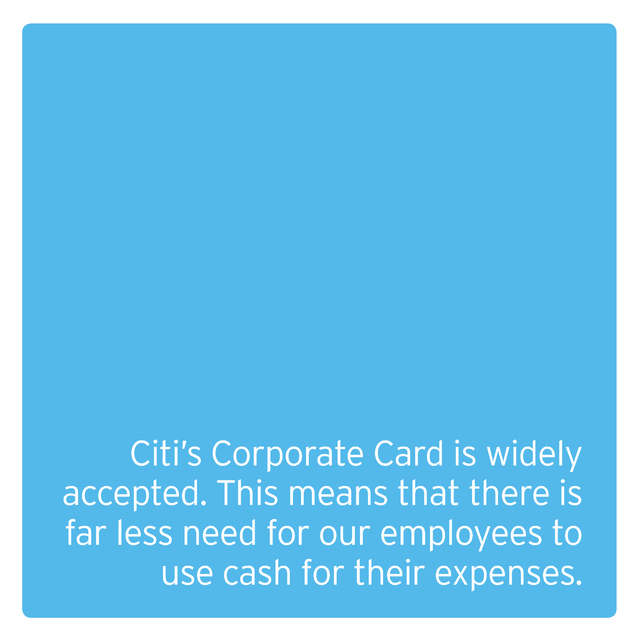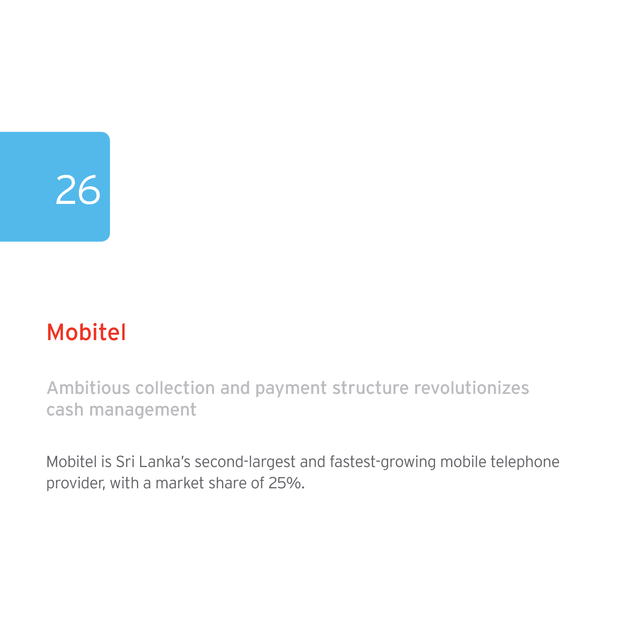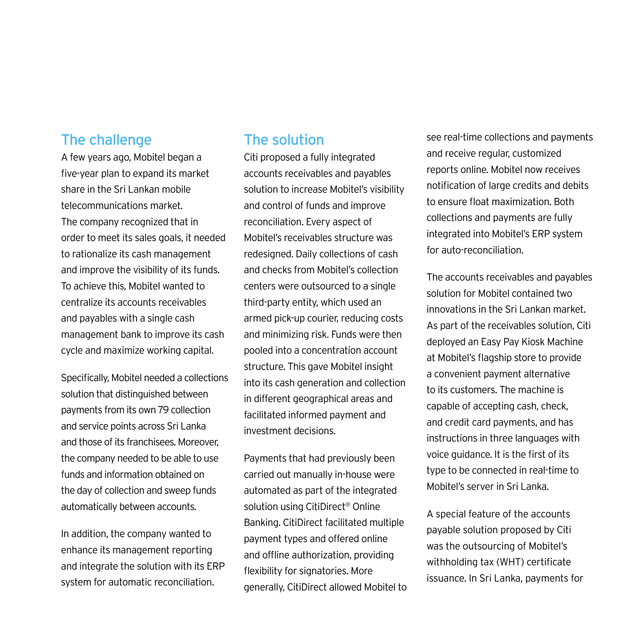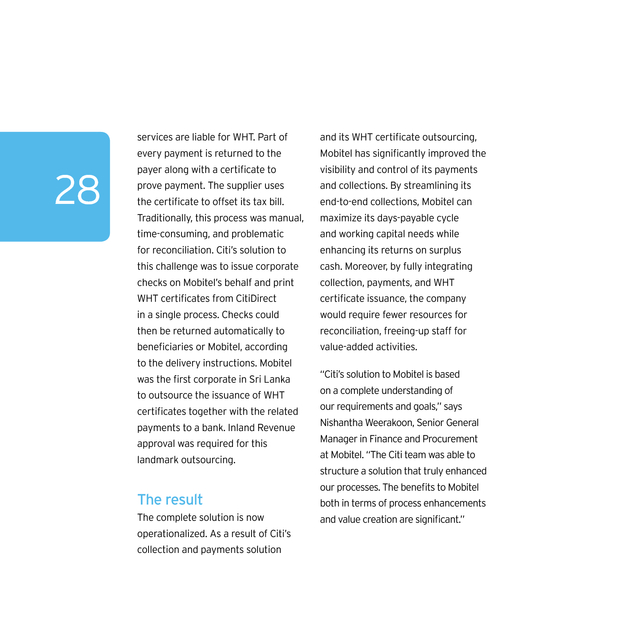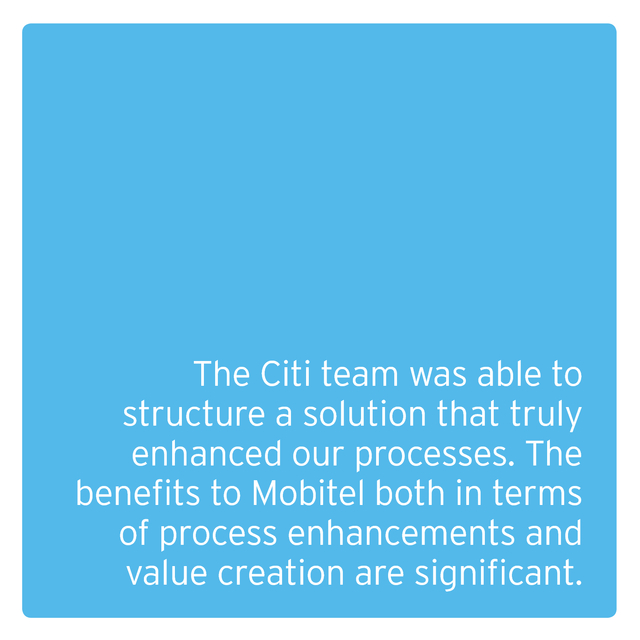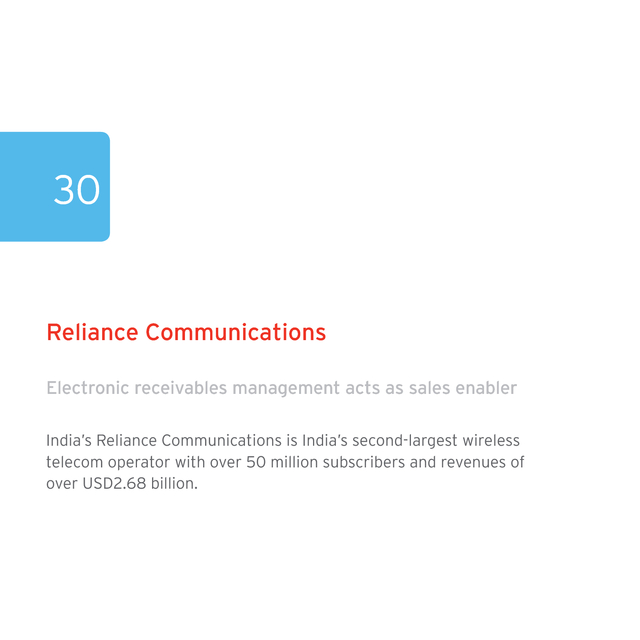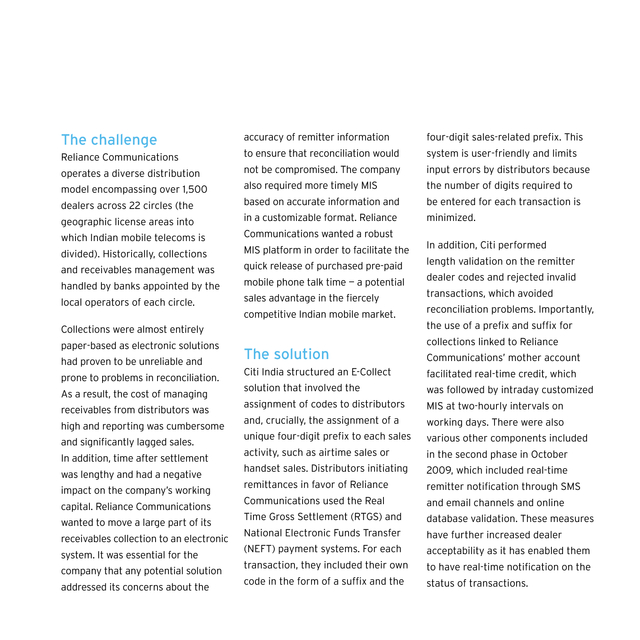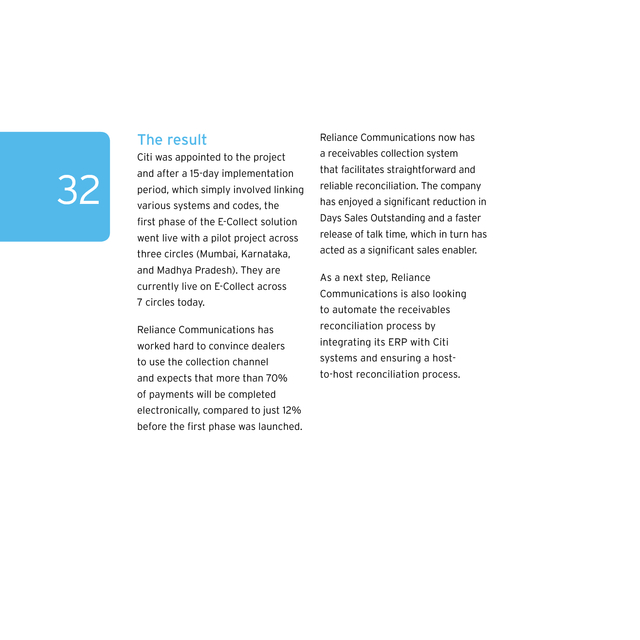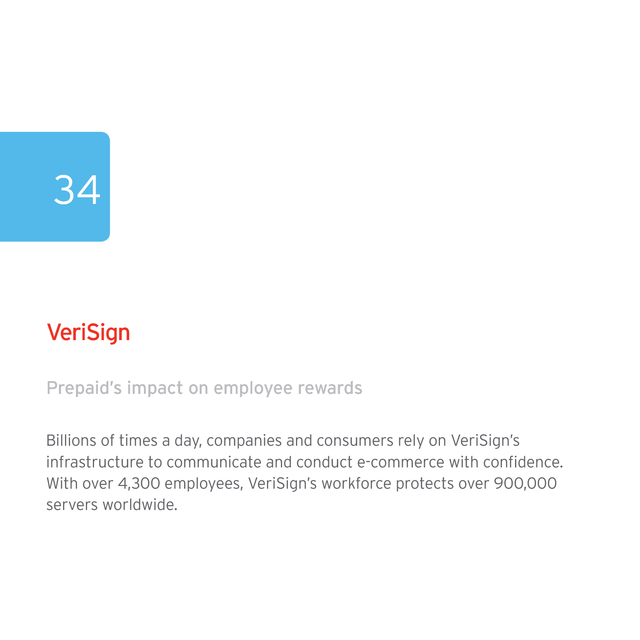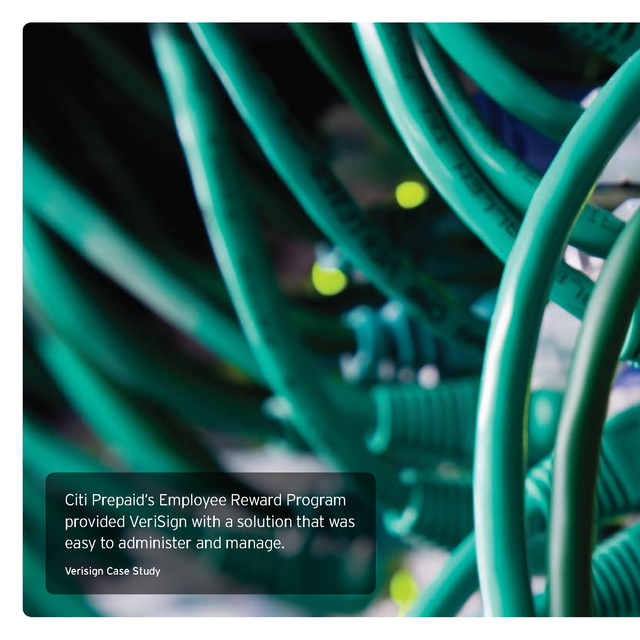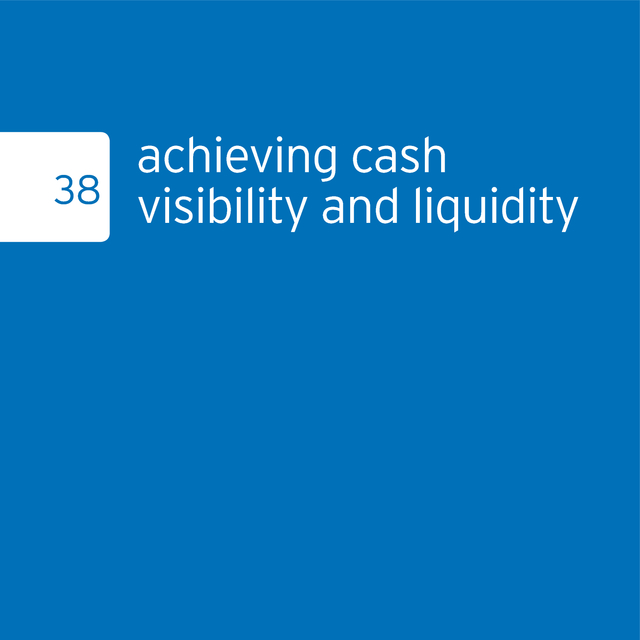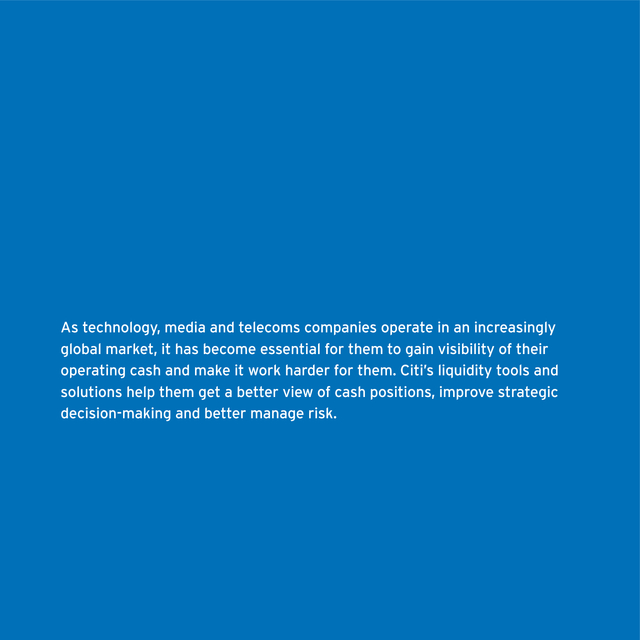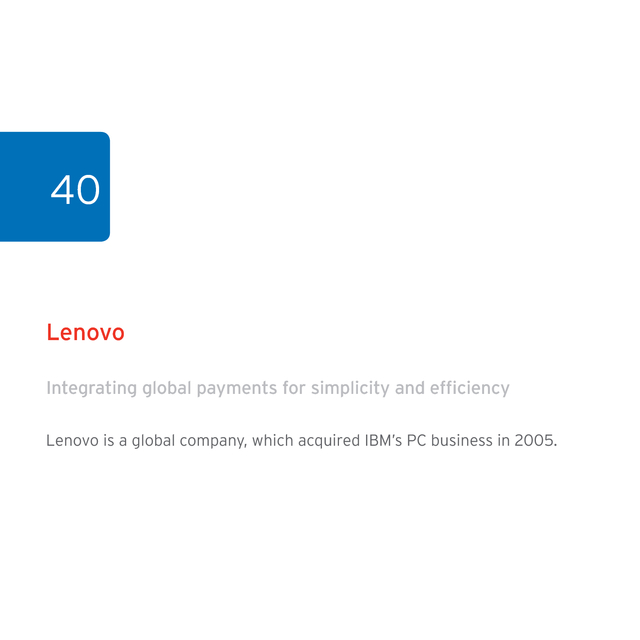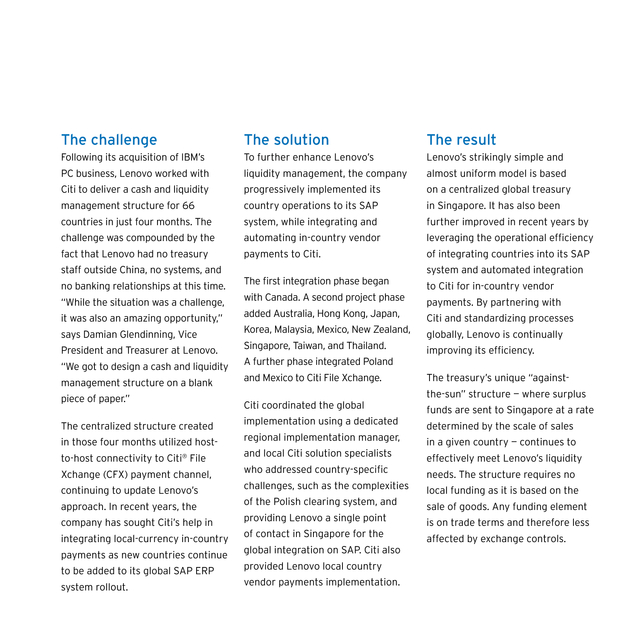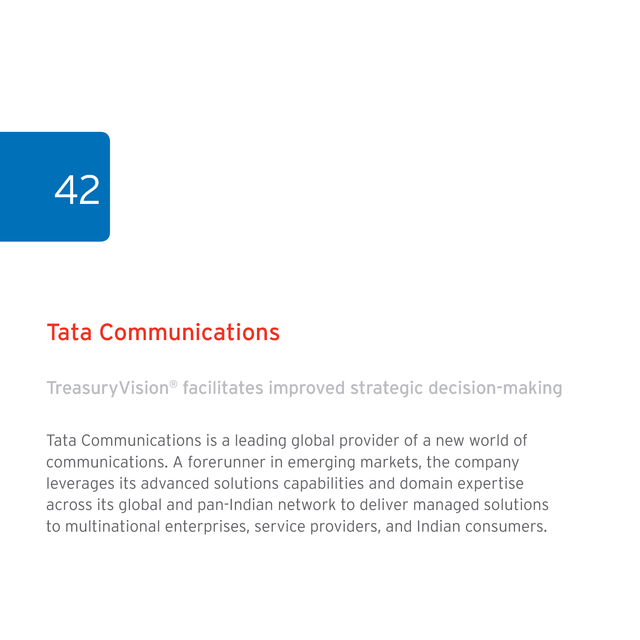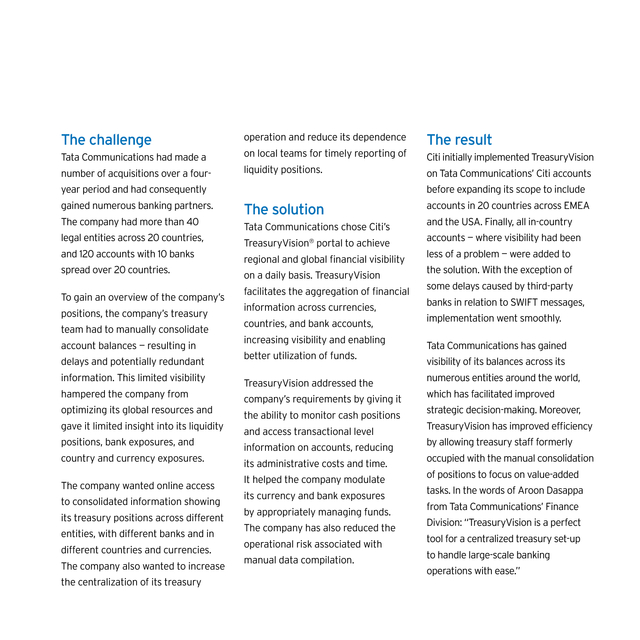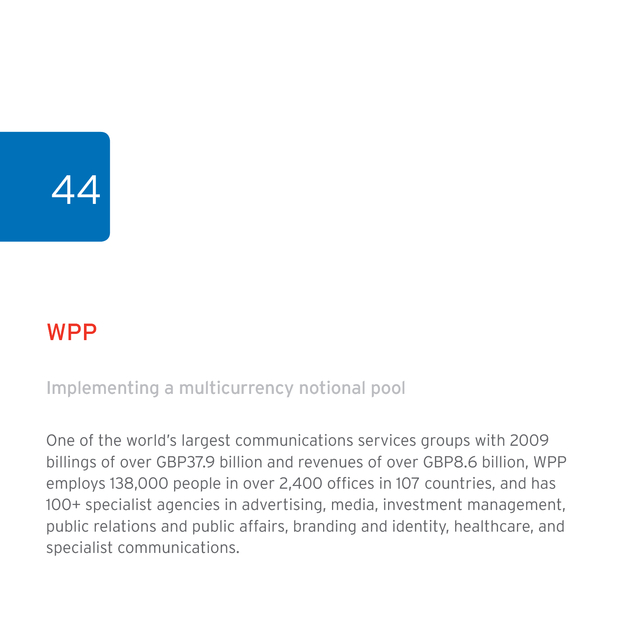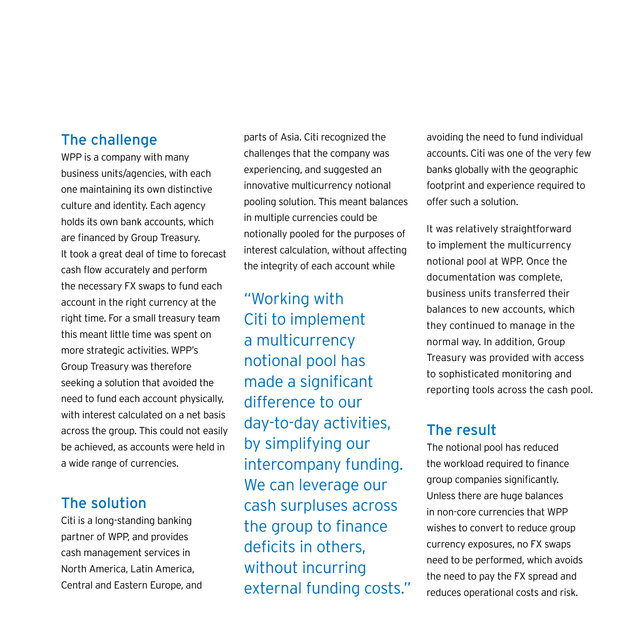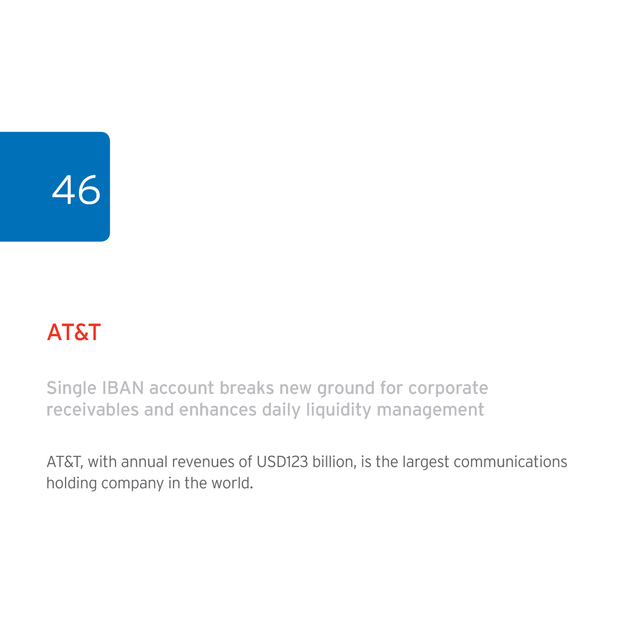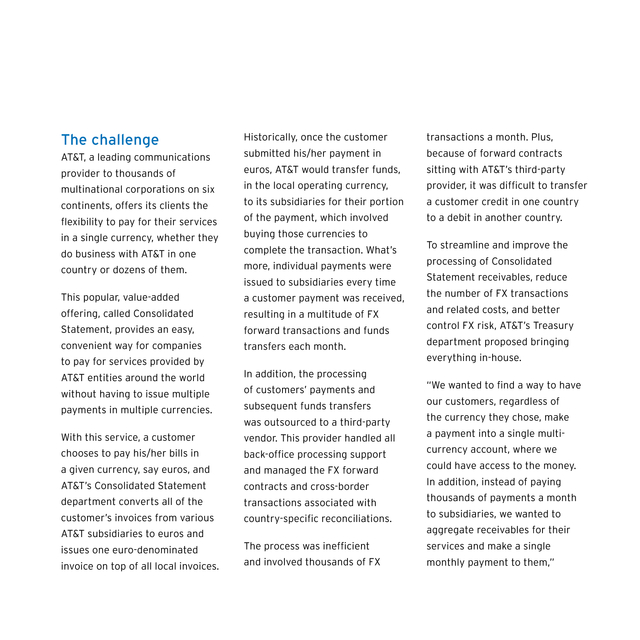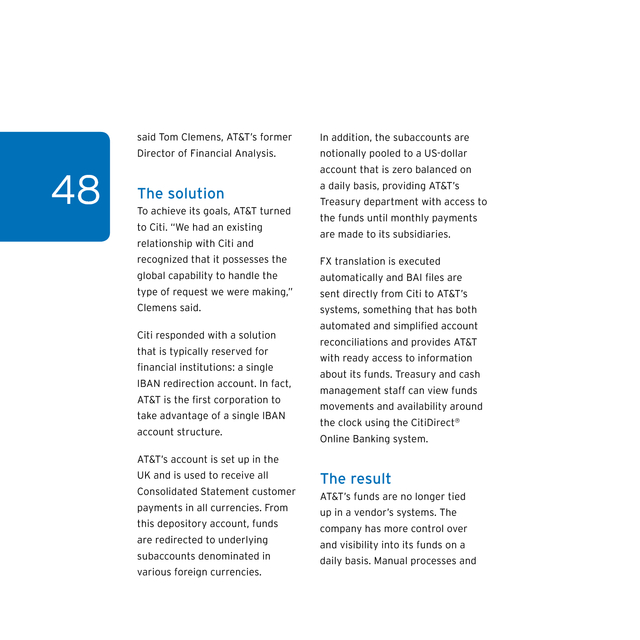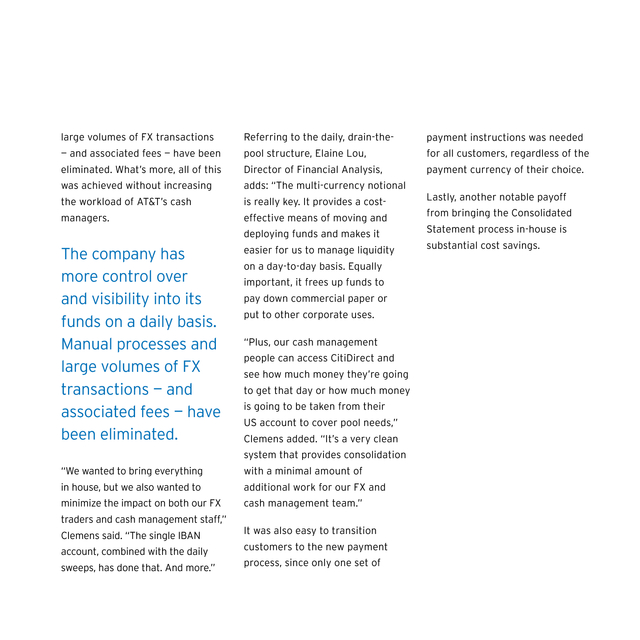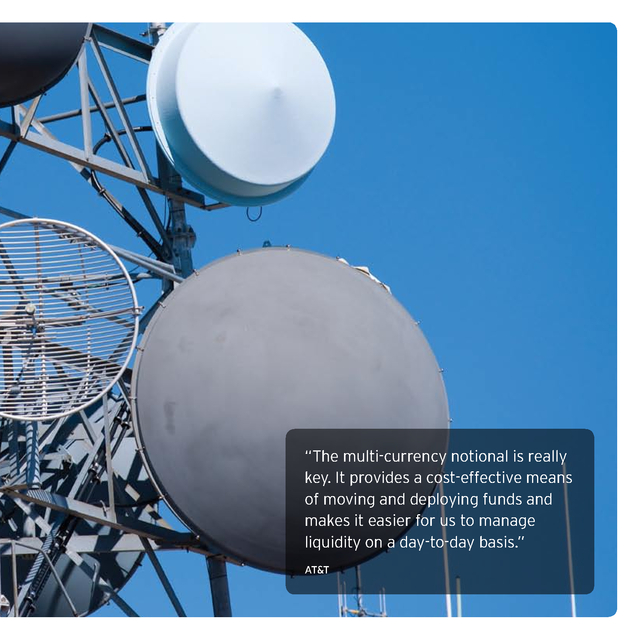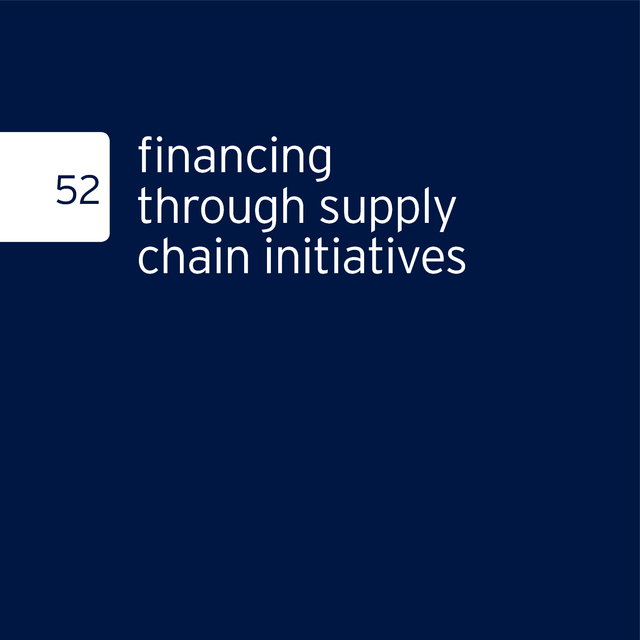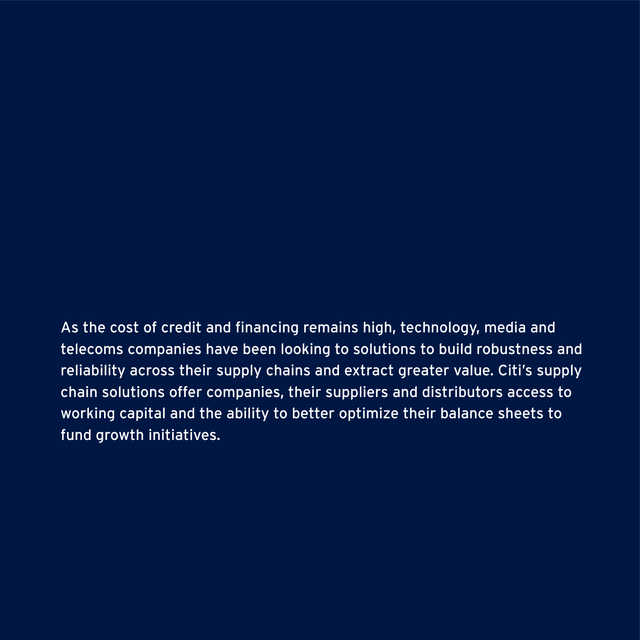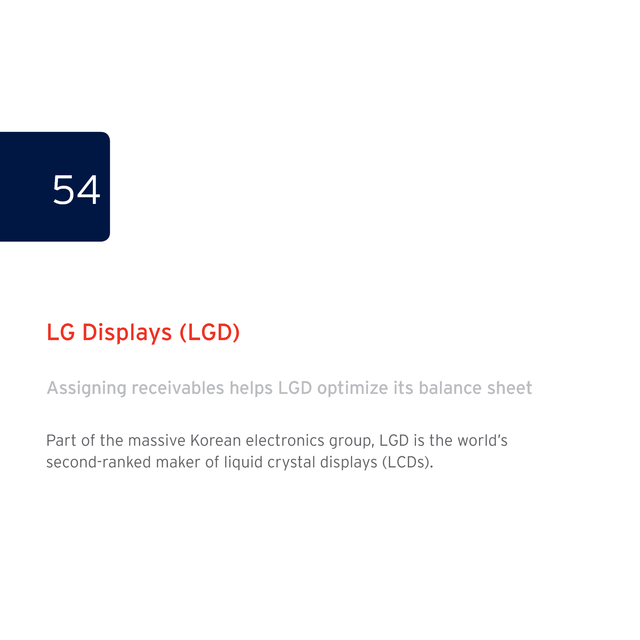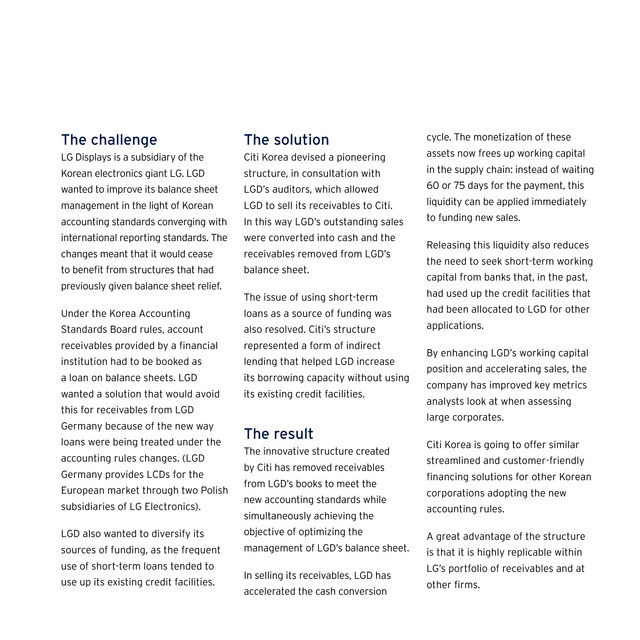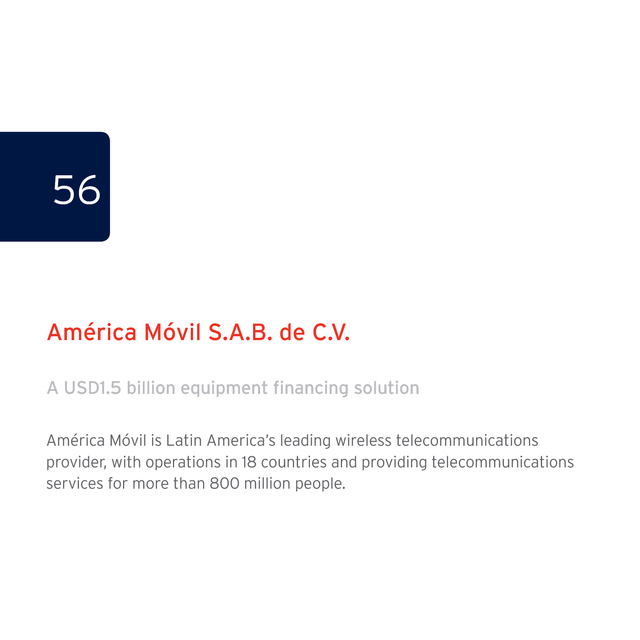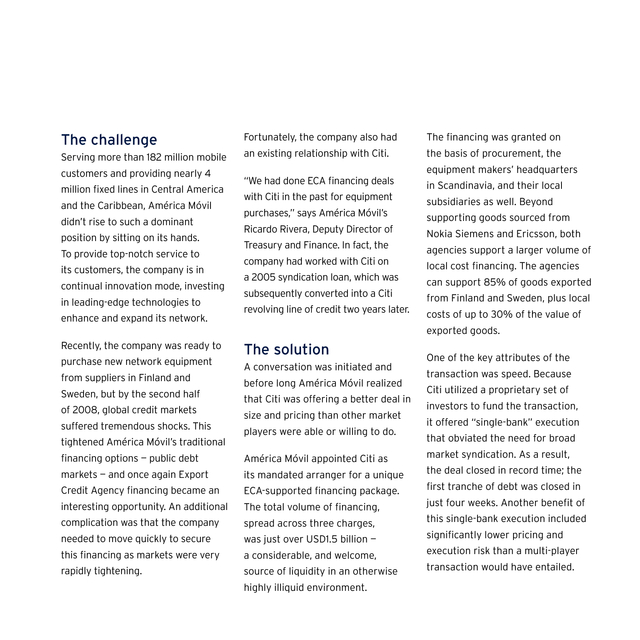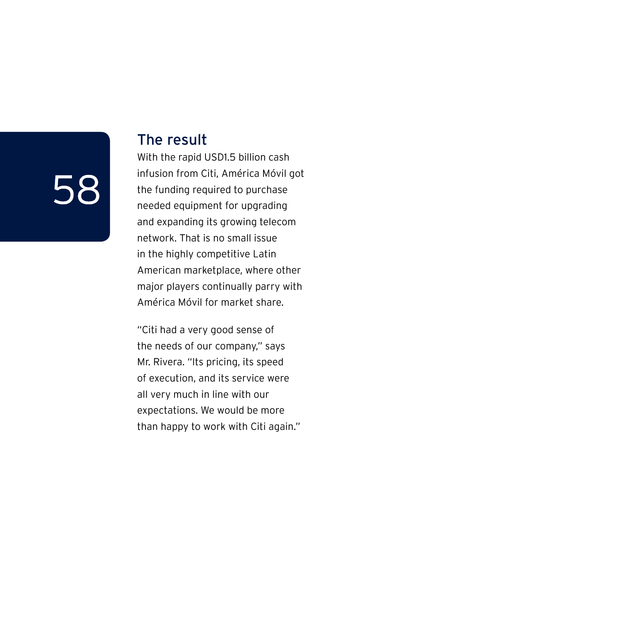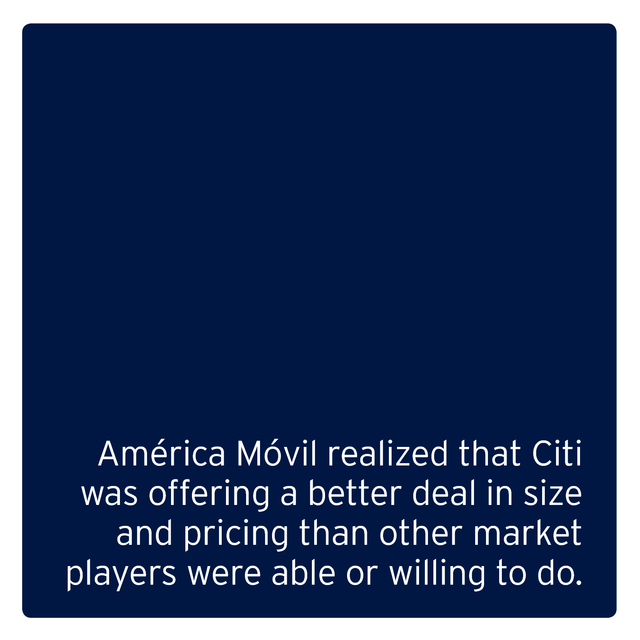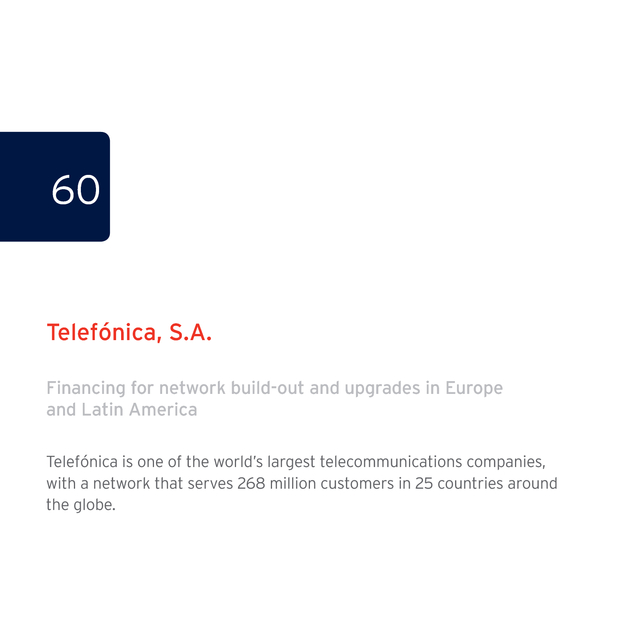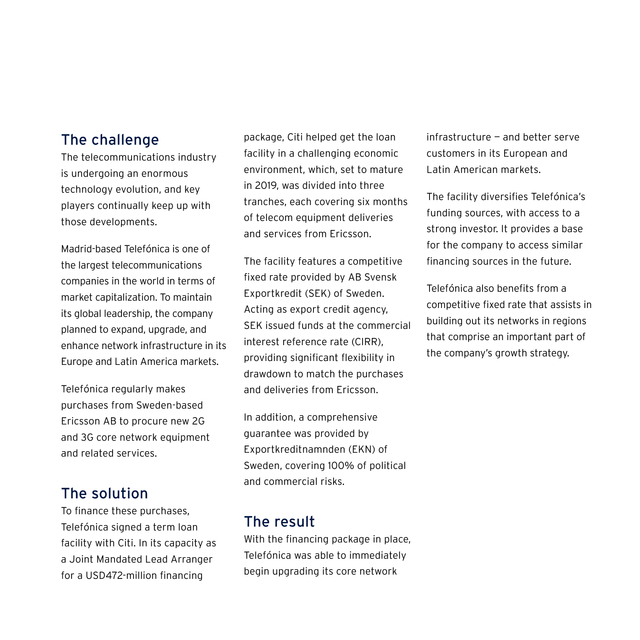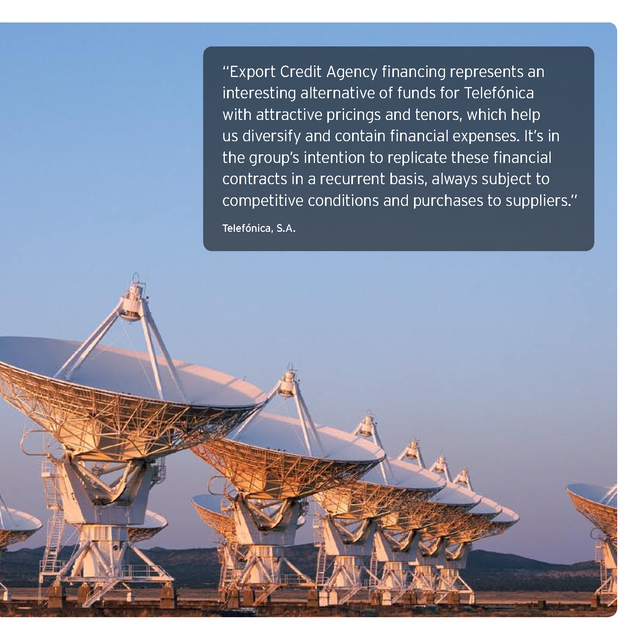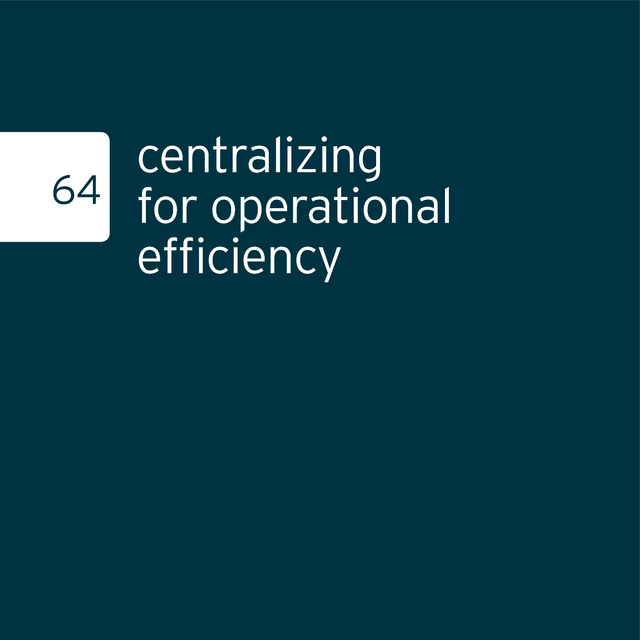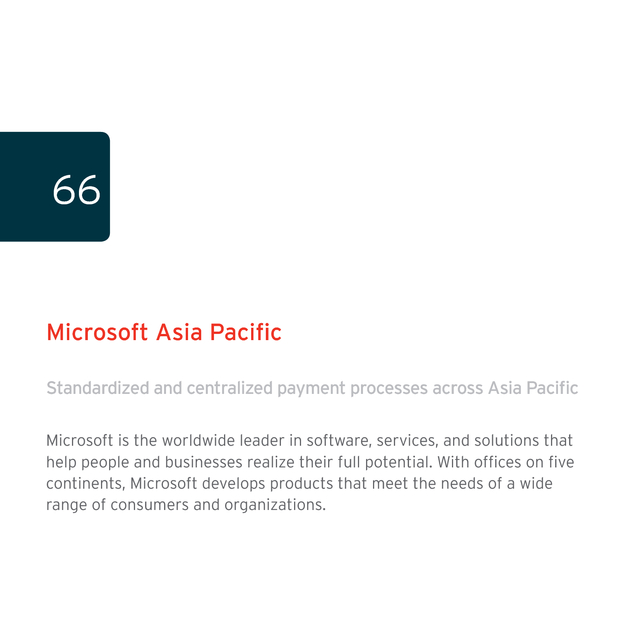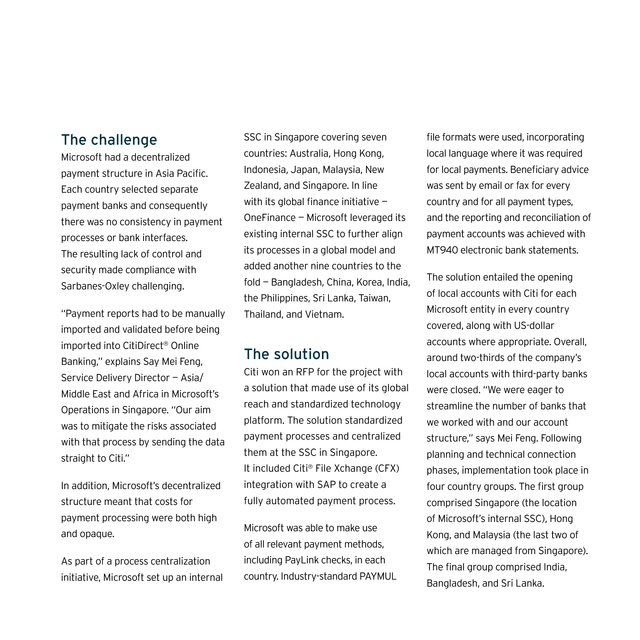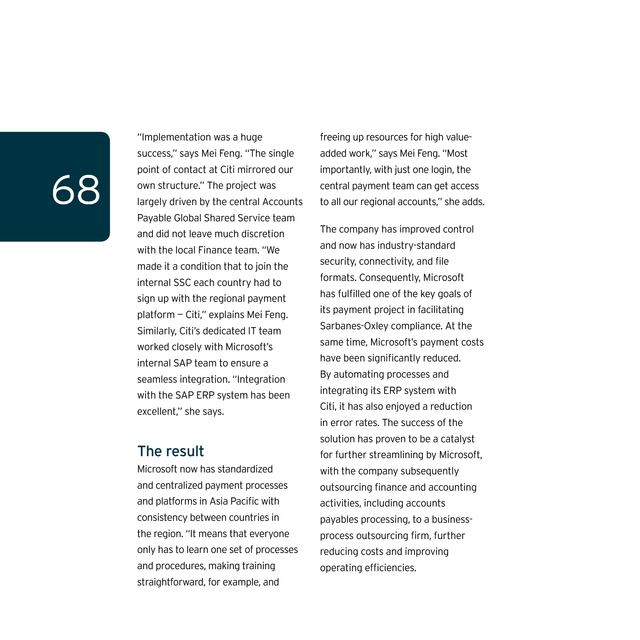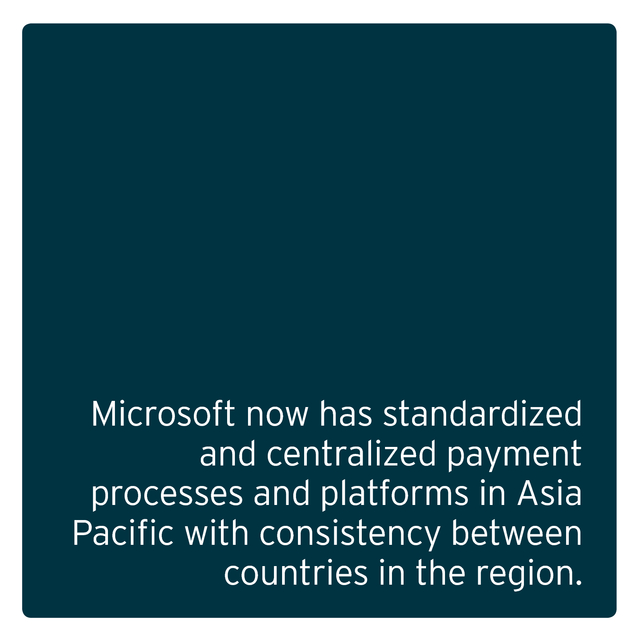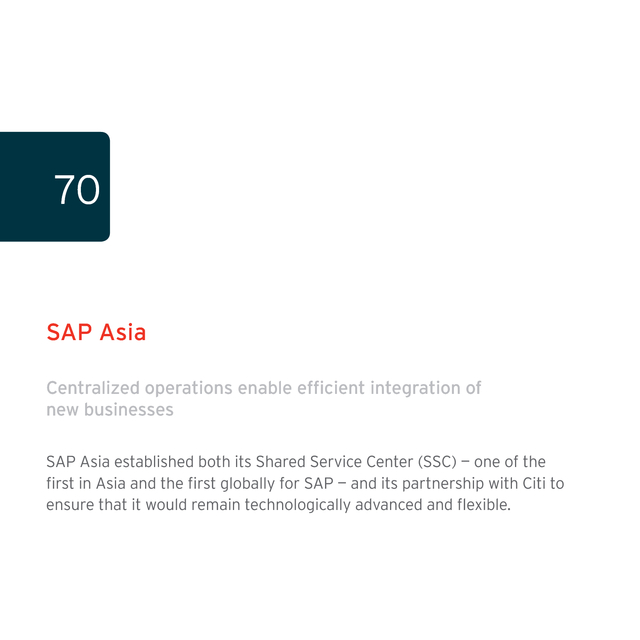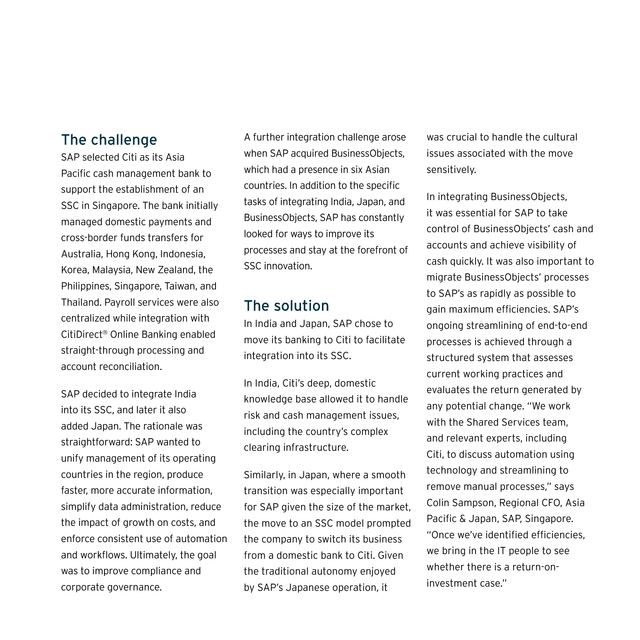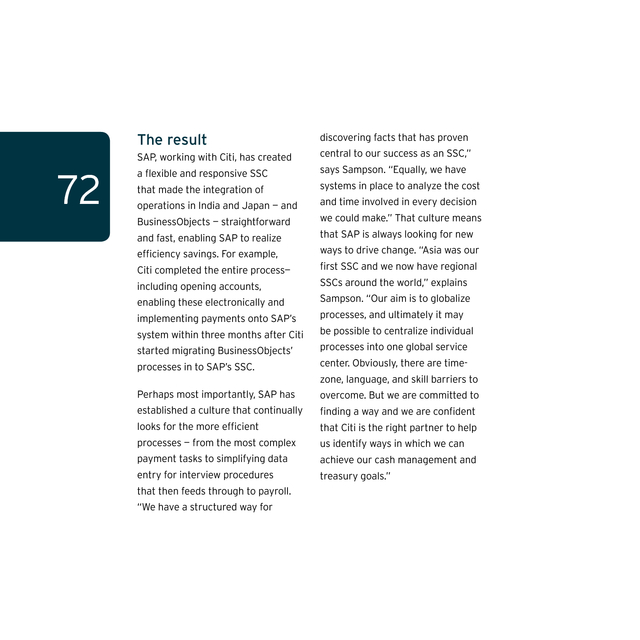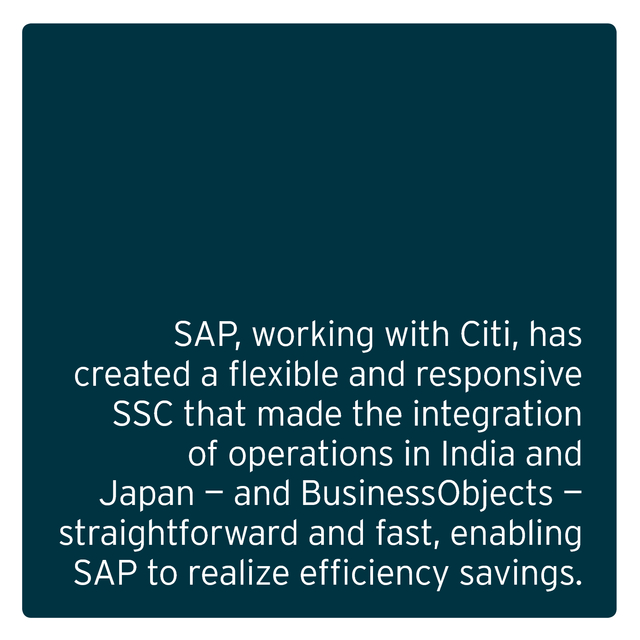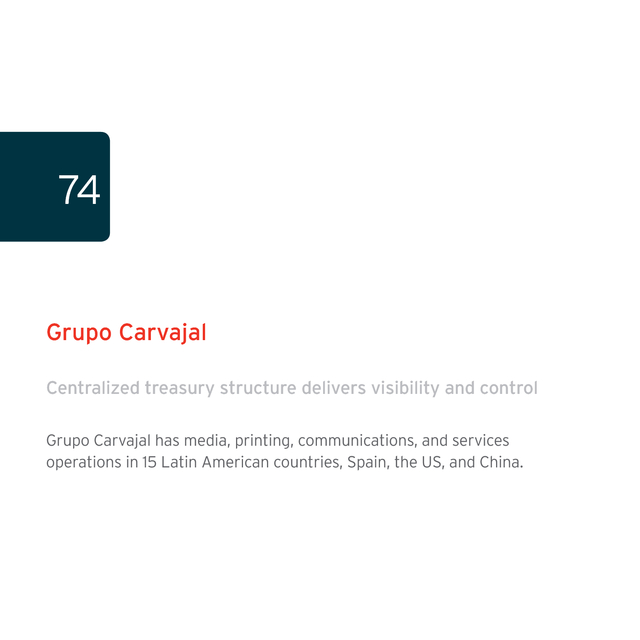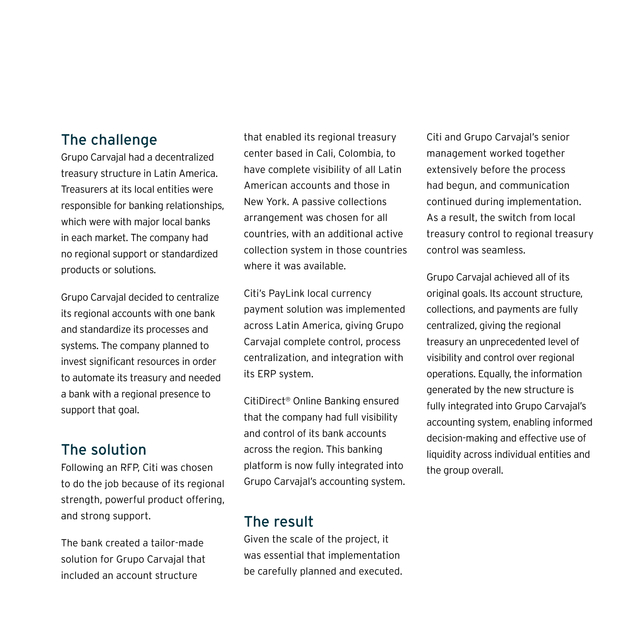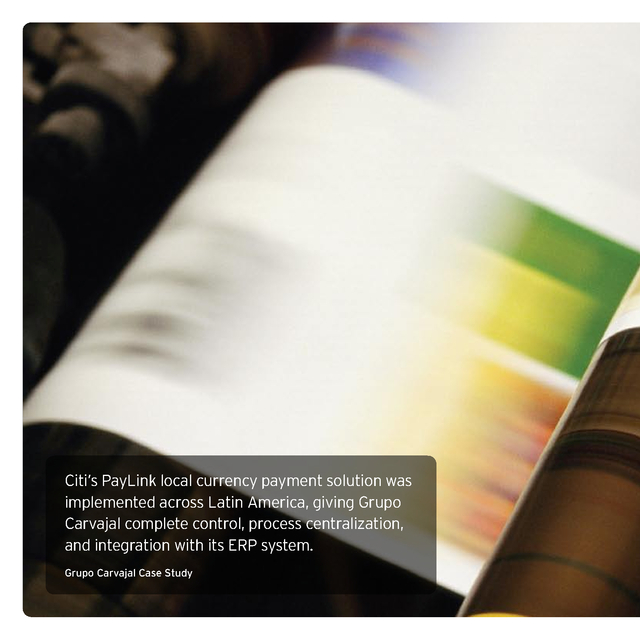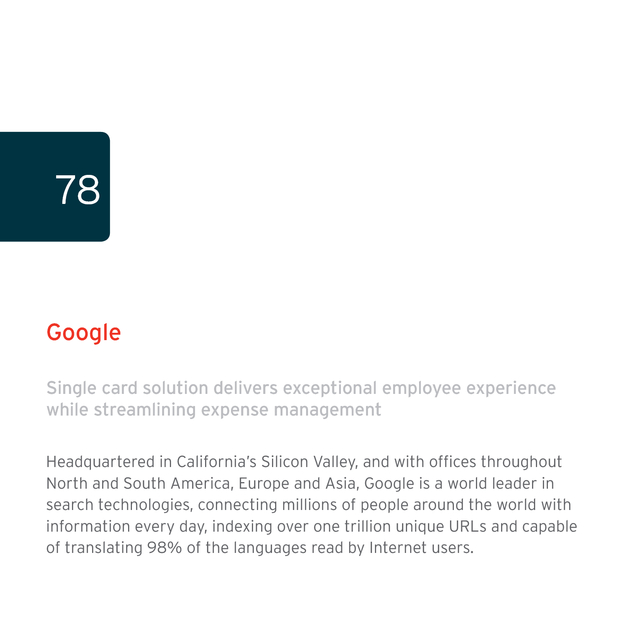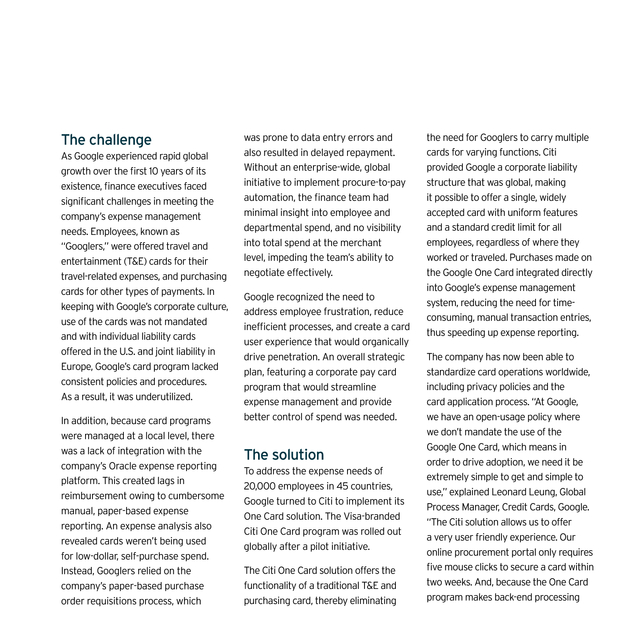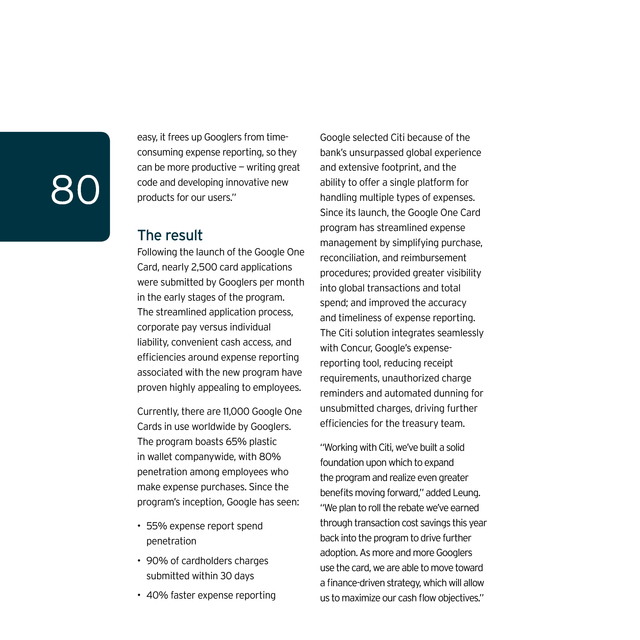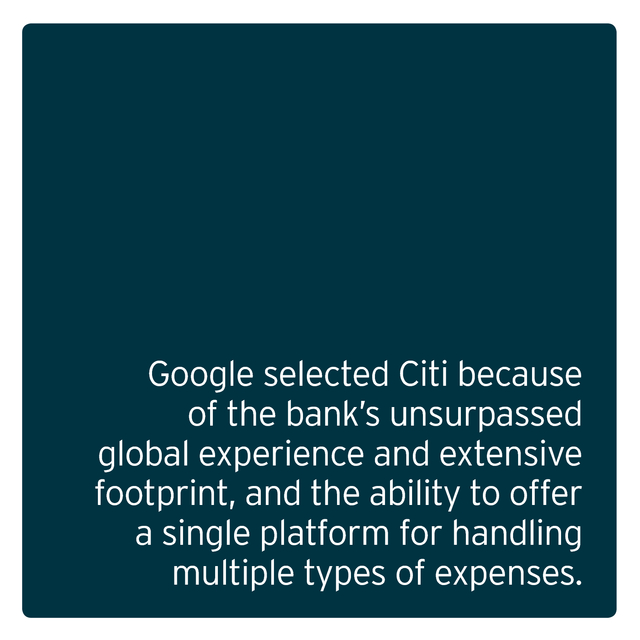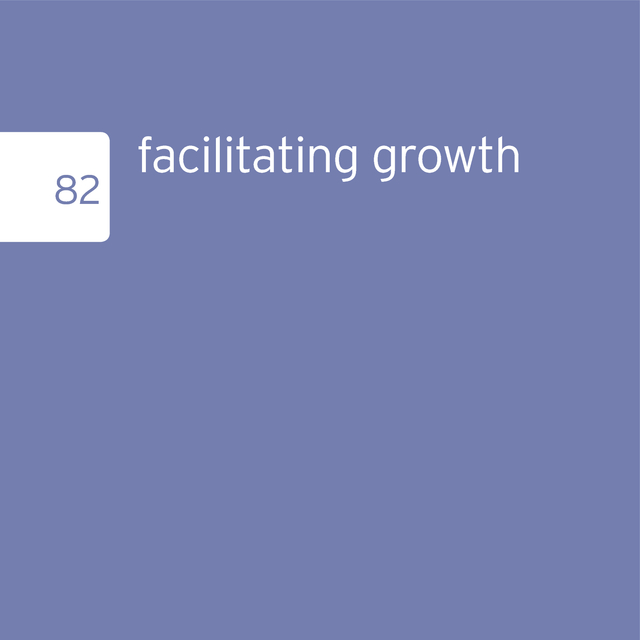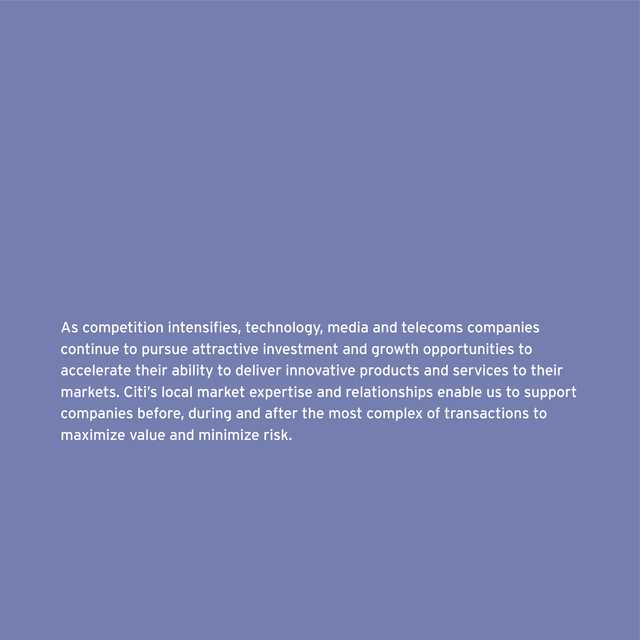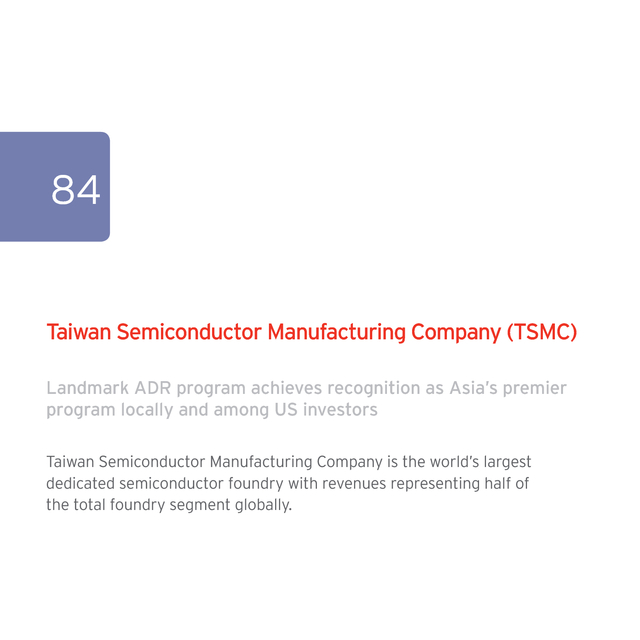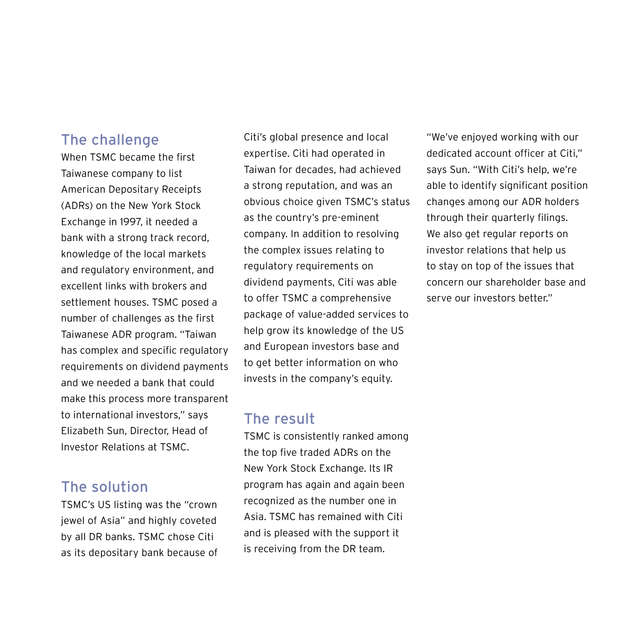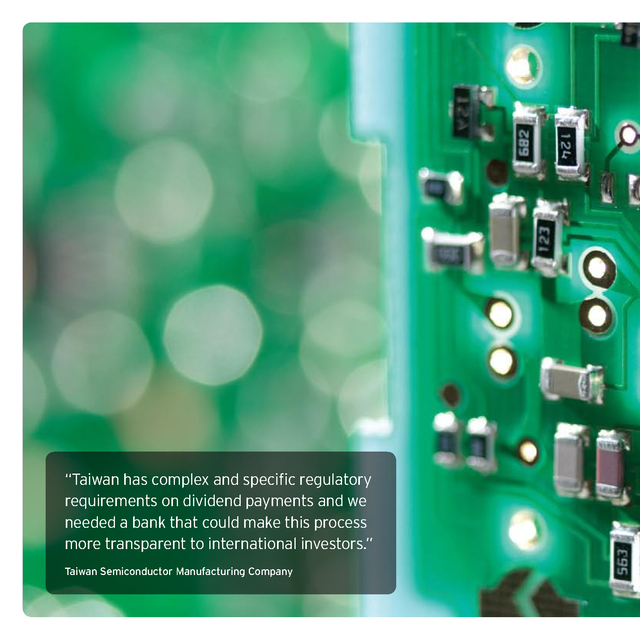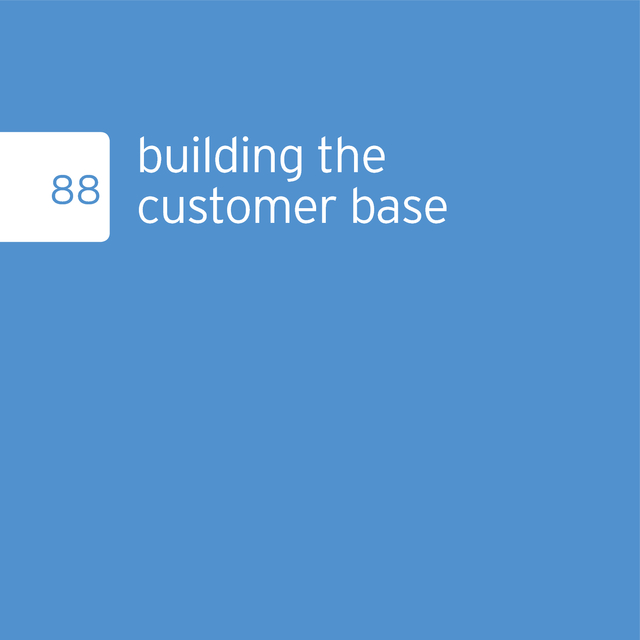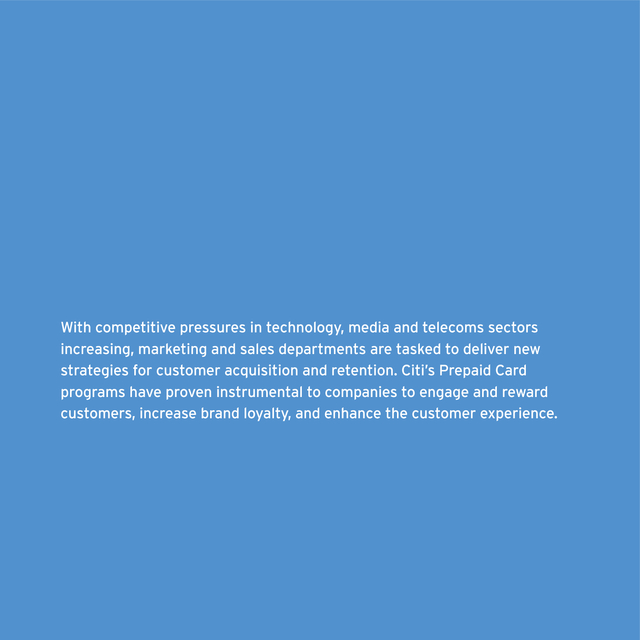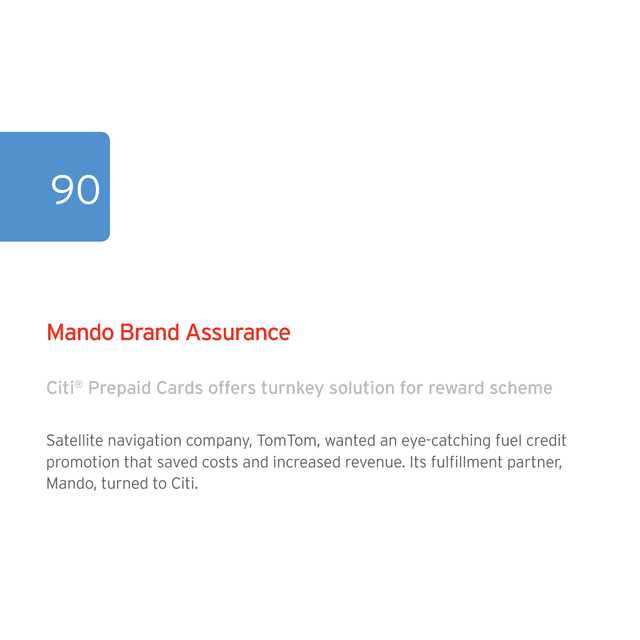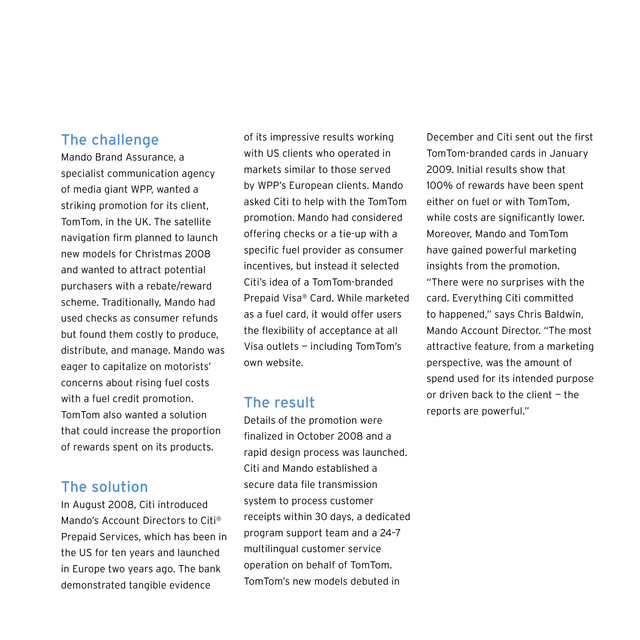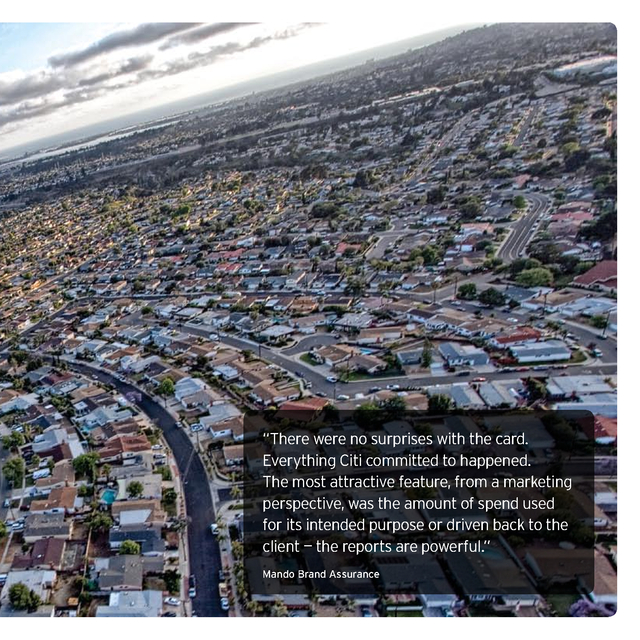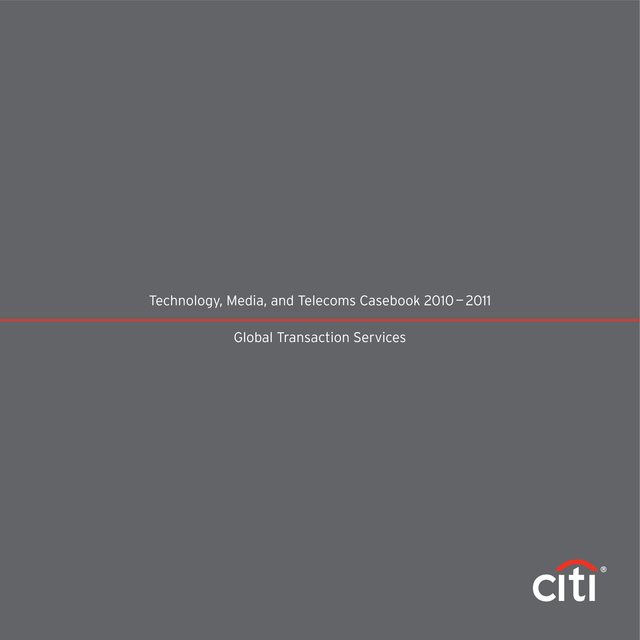Description
. Collaborate
Innovate
Technology, Media, and Telecoms Casebook
Global Transaction Services
.
. “This Casebook is a testimony to
the innovative and creative spirit
of our clients. It demonstrates
how we work in collaboration
with our clients to deliver new
solutions to challenges they
may not have faced before.”
Michael Guralnick
Global Head, Client Sales Management
Treasury and Trade Solutions
Global Transaction Services, Citi
. welcome
. It is my pleasure to present our
the world-class professionals
Citi Global Transaction Services
who staff our offices across more
Technology, Media & Telecoms
than 104 countries.
Casebook. This book of client case
studies is a compilation of the
innovative solutions that we have
designed, in partnership with our
clients, to help them achieve
excellence in meeting their key
working capital goals.
This Casebook is a testimony to the
innovative and creative spirit of our
clients. It demonstrates how we
work in collaboration with our
clients to deliver new solutions to
challenges they may not have faced
before. It is designed to share global
Against a backdrop of unrelenting
Michael Guralnick
Global Head
Client Sales Management
Treasury and Trade Solutions
Global Transaction Services, Citi
best practices, and to help our
economic challenges and a continued
clients accelerate the realization
move towards globalization, our
of their transaction services goals.
clients are focused on achieving
operational efficiencies across their
businesses and their increasingly
complex supply chains.
In this global business environment, our clients are also looking to mitigate a wide range of risks, such as operational risk, settlement risk, and transaction risk. At Citi, we are committed to helping our clients in the technology, media and telecoms sectors respond effectively to these challenging times. We are delighted to share with you the insights we have gained from working with businesses like yours. I look forward Citi’s Global Transaction Services to hearing from you and welcome business provides a global platform the opportunity to continue and of innovative solutions that fully expand our successful partnership. utilizes the creative leverage of .
contents facilitating a new era of creativity in the technology, media, and telecoms sectors 04 accelerating efficiency in payments and collections 18 Hutchison Essar APAC Large-scale collections solutions 20 McGraw Hill APAC Corporate card solutions 22 Mobitel APAC Ambitious collection and payment structure revolutionizes cash management 26 Reliance Communications APAC Electronic receivables management acts as sales enabler 30 Verisign NA Prepaid’s impact on employee rewards 34 achieving cash visibility and liquidity 38 Lenovo APAC Integrating global payments for simplicity and efficiency 40 Tata Communications APAC TreasuryVision® facilitates improved strategic decision-making 42 WPP EMEA Implementing a multicurrency notional pool 44 AT&T NA Single IBAN account breaks new ground for corporate receivables and enhances daily liquidity management 46 . financing through supply chain initiatives 52 LG Displays (LGD) APAC Assigning receivables helps LGD optimize its balance sheet 54 América Móvil S.A.B. de C.V. LATAM A USD1.5 billion equipment financing solution 56 Telefónica, S.A. LATAM Financing for network build-out and upgrades in Europe and Latin America 60 centralizing for operational efficiency 64 Microsoft Asia Pacific APAC Standardized and centralized payment processes across Asia Pacific 66 SAP Asia APAC Centralized operations enable efficient integration of new businesses 70 Grupo Carvajal LATAM Centralized treasury structure delivers visibility and control 74 Google GLOBAL Single card solution delivers exceptional employee experience while streamlining expense management facilitating growth Taiwan Semiconductor Manufacturing Company (TSMC) 82 APAC Landmark ADR program achieves recognition as Asia’s premier program locally and among US investors building the customer base Mando Brand Assurance 78 EMEA 84 88 Citi® Prepaid Cards offers turnkey solution for reward scheme 90 . facilitating a new era of creativity in the technology, media, and telecoms sectors . The technology, media, and telecoms sectors have experienced diverse and complex challenges over recent years, with each subject to different industry, consumer, and competitive trends. What characterizes the most successful companies in each of these industries is their ability to flex their business and revenue models, both in response to, and in anticipation of, these developments. Here we outline some of the challenges and opportunities for companies in these sectors, and how transaction banking solutions may enable them to finance their activities, optimize liquidity, mitigate risk, and maintain their competitive position. Addressing challenges, maximizing opportunities computing solutions, such as with growing acceptance of netbooks, while smartphones SAAS (software as a service). Technology consumers. Home entertainment During the latter part of 2008 and also remained a priority for into 2009, the technology sector consumers, despite becoming was badly hit as companies and more cost-conscious in other areas. consumers reduced their budgets, For example, global LCD television affecting semiconductor, consumer sales reached 107 million units in electronics, software, computing, 2008, an increase of 24% from and network infrastructure 2007.
High-definition TV ownership companies alike. For example, the in the United States grew from semiconductor industry, often a 11% in 2004 to 49% in 2009 and strong indicator of the wider is expected to reach 71% in 2014, technology industry, witnessed an a trend that is mirrored in other 11% fall in revenues during 2009. regions. Among the business However, there were some bright community, cloud computing, spots.
Consumer demand continued software, and infrastructure unabated for convenient mobile virtualization continued to expand, became ubiquitous among Technology companies have not been waiting idly for the recovery to come. Indeed, these companies are well positioned to take advantage of every growth signal. Many have diversified their functional offerings, invested in innovation, implemented costefficiencies, and increased their geographic footprint.
According to recent research by Gartner, technology purchases are likely to rise by 5.3% during 2010. In particular, we see continuing demand for consumer technology, both in established and emerging . markets. For example, in the BRIC countries, the number of personal 6 During this difficult period, media companies were tasked to streamline computer users is anticipated to costs and enhance efficiency, but also grow by more than 30% per year, to align their business models with the topping 500 million by 2012 in changing needs of their business and these countries alone. consumer markets. While these Media The media sector encompasses a broad and diverse reach of companies from advertising and marketing through to entertainment. These companies were experiencing a variety of business challenges even before the recent global financial crisis as business models for marketing and advertising changed to reflect the needs of an increasingly digital era.
In parallel, consumer entertainment demands became both more discerning and more fragmented. Already vulnerable media companies, particularly those engaged in advertising and marketing, were badly affected during the global financial crisis as clients reduced their discretionary spend. businesses were hit the hardest, conversely they are in many ways a ”litmus test” for recovery. Leaner and more competitive, media firms have been among the first to witness signs that the economic tide is turning as their patrons return to advertising as a means of accelerating business growth. “Media companies were tasked to streamline costs and enhance efficiency, but also to align their business models with the changing needs of their business and consumer markets.” .
Telecoms entering a period of significant innovative and competitive companies While handset and equipment change, with innovative operating within each of these industries are manufacturers experienced a models developing in established well positioned for recovery and are downturn in revenues, the telecoms markets, new service offerings, already leveraging new opportunities sector in aggregate was largely the effects of digital expansion, and creating competitive advantage. insulated from the global financial emerging-market growth, and As a partner bank of over 2,000 crisis. Mobile roaming revenues an evolving regulatory landscape. multinational companies in this and voice traffic among business Competition is likely to become sector, Citi has developed significant customers fell, but otherwise stronger still, with Asian players expertise in understanding and operators saw generally steady expanding globally and low-cost responding to changing business income. Even so, by embarking carriers challenging established needs and has invested in the on cost-efficiency programs, revenue models. To be successful, solutions that are helping to enable companies that were most affected companies are compelled to flex these companies achieve their could still remain profitable. their business models, expand their business strategies, maintain access The business-to-consumer (B2C) product and service offerings, and to liquidity, and manage their risk. market has continued to grow take advantage of investment strongly globally as mobile opportunities; those that lack the communications are increasingly necessary strategic and financial seen as essential services in the flexibility are likely to find Supply chain initiatives same way as utilities such as gas themselves eclipsed. For technology companies to or electricity. technology companies maximize opportunities for growth complacent, however.
While the Plugging into the new economy economic downturn may not have While there is clearly significant scarred them to the same extent as diversity across the technology, media, other industries, the sector is and telecoms sectors, the most Telecoms companies are not Facilitating growth in into new product and geographic markets, sales channels need to be robust and reliable. With many companies heavily reliant on distributors, many of whom have a weaker credit standing than the . manufacturers of the products they sell, supply chain techniques such as 8 rules of engagement. The need to innovate, embrace new technologies, distributor financing help to ensure and seize opportunities in new that companies’ sales strategies are markets means that companies are well supported. For example, by obliged to expand their trading enabling distributors to access network while managing their credit financing, multinational companies and currency risk and protecting their are realizing uninterrupted supply, financial supply chain. Consequently, a consistent brand presence, and there has been a growth in demand ongoing sales momentum. for trade instruments such as import At the other end of the supply chain, supplier financing helps enable companies to support their suppliers by offering invoice discounting at a competitive rate while maximizing their own days payable outstanding (DPO).
Such a solution brings working capital advantages to the buyer and its suppliers, increases the resilience of the supply chain, and strengthens relationships between partners. Managing risk As technology companies seek to expand both their geographic footprint and their portfolio of products and services, trading partners are changing, with new and export letters of credit (LCs) as the tools of choice for companies of all sizes and geographies to manage their counterparty risk. While open account trading became more “Banks such as Citi have supported clients’ trade finance processes by enhancing efficiency and automation, therefore helping to enable them to receive goods or payment more quickly.” . prevalent during the years preceding their banking partners to enable and reduce “trapped” cash. the global financial crisis, there has new financial flows, including Furthermore, with many upstream since been an evident increase in the consumer, business, and distributor technology companies collecting use of LCs. Banks such as Citi have flows. The development of these in US dollars but having local supported clients’ trade finance companies creates a new market currency payment requirements, processes by enhancing efficiency dynamic as they both compete and there needs to be an efficient and automation, therefore helping cooperate with ODMs (original means of pooling cash across to enable them to receive goods or design manufacturers). Technology borders, ensuring the availability payment more quickly. companies of all types, including of funds and managing currency OEMs and ODMs, need an effective, risk.
Working with a bank such integrated approach to cash as Citi, which has considerable management, including payables geographic reach and depth and receivables, to maximize and product versatility, can be liquidity available for investment essential to these efforts. With a in business growth and innovation presence in 104 markets, Citi has and to enhance financial flexibility. the scale and depth of offering This can be particularly complex for to meet the needs of the world’s multinational companies operating leading technology brands. Optimizing working capital While working capital has been a priority for many technology companies during a period of restricted financing, the return to economic growth should not mean that this focus should be reduced. Indeed, to maintain its competitive position, cash flow initiatives are critical for any company in this sector. For example, OEMs (original equipment manufacturers) in emerging markets have a variety of scale advantages and often large across a large number of currencies and countries with diverse regulatory constraints, and these issues are often exacerbated by fragmented banking relationships. Building customer base With the competitive pressures exacerbated by the emergence of competitive technologies such as netbooks, tablets, eReaders and the cash reserves.
As some of these Best-in-class technology companies next generation of smartphones, companies extend beyond assembly seek treasury optimization marketing departments are tasked and manufacturing to design and strategies such as overlay to deliver new strategies for customer innovation, they need support from structures to enhance liquidity acquisition. Prepaid card programs . have proven instrumental for technology companies wishing to 10 build strong relationships with new and existing customers, increase brand loyalty and spend, and enhance customers’ experience, without adding administrative effort. Furthermore, prepaid cards have proved a convenient and attractive means of compensating and incentivizing sales teams. Not only do prepaid card programs represent a crucial element of proactive marketing campaigns, but they also provide detailed management information and metrics for measuring the success of customer acquisition, “Prepaid card programs have proven instrumental for technology companies wishing to build strong relationships with new and existing customers, increase brand loyalty and spend, and enhance customers’ experience, without adding administrative effort.” ”churn”, and retention programs. Consequently, they can be influential Facilitating growth in developing greater intelligence As competition continues to about customer needs and behaviors strengthen, technology companies and in determining how marketing continue to pursue attractive efforts should be channeled or acquisition targets to accelerate refined, essential for any customer- their ability to deliver innovative oriented company. products and services to the . market. In particular, companies integrate acquired businesses more innovation and the design of with significant balance sheet quickly, increase visibility, reduce creative services specifically crafted strength are seeking to rebalance costs, and enhance value. for the needs of the local market. revenues in favor of services, which provide a more regular and predictable income stream, Monetizing the digital economy in the media industry However, as the economic landscape has changed, these companies are seeking to reduce debt/equity levels as margins on hardware are Media and entertainment and manage their counterparty risk compressed as the market companies facing the challenges of more effectively. These companies becomes more commoditized. declining advertising revenue and are therefore increasingly using Consolidators are seeking banking circulation of traditional news and tools such as Citi’s TreasuryVision®, partners to support them during entertainment media, such as the award-winning cash and data and post-acquisition to reduce newspapers, require an innovative aggregation solution, to achieve risk and maximize the value of approach to harnessing new digital visibility of cash across multiple these acquisitions. Accessing media and building new revenue banks and accounts globally. international escrow services streams, as opposed to simply and pledge accounts, to minimize transferring existing business risk and handle deferred models to a digital format. obligations, can be essential Marketing, public relations, during an acquisition process. research houses, and advertising Citi’s Agency and Trust group companies need to find enterprising specializes in providing these solutions for their clients. customized solutions.
Furthermore, In addition, as the fortunes of media companies improve, fueled by innovation and more flexible service offerings to their customers, they are looking to redeem debt and maximize investment returns by centralizing by leveraging a partner bank’s Establishing synergies in cash through regional and global experience in implementing decentralized companies liquidity structures. To achieve cash and liquidity management Media companies that have grown such a solution, it is important structures and in supporting through acquisition frequently to work with a bank experienced shared service centers, it is retain local autonomy among in optimizing cash flow in possible for companies to business units to encourage decentralized organizations, familiar with the objectives and . concerns of head office and local finance teams, and with 12 depth of material that consumers require. However, making regular the necessary geographic reach or one-off payments to these and functional depth. individuals or companies can be difficult when they are distributed “It is important to work with a bank experienced in optimizing cash flow in decentralized organizations, familiar with the objectives and concerns of head office and local finance teams, and with the necessary geographic reach and functional depth.” globally. Consequently, media companies can benefit significantly from tools such as Citi’s WorldLink® Payment Services, the foreigncurrency payments system that enables regular or one-off payments in 137 currencies. Additionally, the use of prepaid cards to compensate contributors or content developers can be a convenient means of making payments without the need to request or store payment instructions. Collecting cash Not only do media companies need Efficiency in distributed payments to make payments more efficiently, Media companies frequently work but they also require innovative with remote journalists, authors, collection solutions such as virtual correspondents, and content or accounts as used by leading mobile application contributors, companies in some of the world’s and this diversity of input is often most challenging markets, such as essential to maintain the variety and Russia and the Ukraine. . Enhancing competitive advantage assisted a number of mobile network Earnings and margins compression for telecoms companies operators, including many of the A highly competitive and demanding In a continually changing world’s leading telecoms companies, economic climate challenges environment where competing to access export agency financing telecoms companies to maintain firms are increasingly seeking as an attractive source of capital. earning levels and protect margins. to convert customers in mature markets and develop brand recognition and market share in emerging economies, there is constant pressure on telecoms companies to invest in geographic expansion and product innovation, whatever the economic conditions. In a new economic climate, therefore, while the need for capital expenditure has continued unabated, the models for funding it have changed substantially. Innovation and investment in its own activities is not enough for a telecoms company to be successful. Another key consideration is how to secure supplies to deliver on customer expectations. Companies are therefore implementing supply chain finance solutions that enable them to finance suppliers to ensure continuity of supply while maximizing DPO and preserving working capital. Given the inherent interconnectedness of the communications industry, Financing in a new economy a noticeable feature has been the As companies’ costs of financing ”catalyst effect” of implementing have increased, traditional routes to supply chain finance programs. financing, such as bank funding or This has seen the large suppliers capital markets issuance to support to the wireless and electronic infrastructure development, have companies that have previously become less financially attractive or benefited from these programs as feasible. However, companies have sellers, now equally considering the found favorable alternatives through merits of these programs as buyers. export agency financing. Citi has These challenges are exacerbated further by increased payment delinquency, tightening roaming and rate regulations and option fees.
Consequently, telecoms companies are tasked to find innovative and compelling ways of increasing revenues from each customer, reducing churn, and attracting new customers. At the same time, they are seeking to reduce costs and increase efficiency within the business. As discussed earlier in relation to the technology sector, prepaid card programs are becoming increasingly prevalent in the mobile and triple-play space to improve average revenue per user (ARPU), a key metric for the industry, and support customer acquisition programs such as refer-a-friend promotions and handset rebate alternatives. .
Pioneered by banks such as Citi, these programs have proved so 14 reduced, and counter-party risk minimized, telecoms companies successful for leading operators require efficient overlay solutions in the US that there is increasing and creative purchase-to-pay and demand in other regions. order-to-cash solutions on a local Telecoms companies are also becoming increasingly aware of the merits of commercial card solutions as a means of controlling travel and entertainment (T&E) expenses and ensuring that procurement spend is performed in line with corporate processes. There can be considerable economic benefits to be gained from the use of commercial cards, including rebates, workflow efficiencies, tighter control over costs, and increased buying power with key suppliers. These benefits may be further enhanced by the ability to provide a convenient corporate liability card to employees for expenses and purchasing. Managing cash and liquidity As with media companies, cash and treasury management is frequently decentralized in telecoms companies, partly due to the need to service large domestic client bases. To allow cash to be centralized, net borrowings and regional basis.
This may require different types of banking support across the company: for example, a bank may help an operator to centralize its payments processing while providing local business units with assistance with marketing campaigns and collections. “To allow cash to be centralized, net borrowings reduced, and counter-party risk minimized, telecoms companies require efficient overlay solutions and creative purchase-to-pay and order-to-cash solutions on a local and regional basis.” . Looking ahead help to maintain liquidity, provide We believe the challenges for access to cost-effective financing, technology, media, and telecoms and mitigate risk. Technology, companies will continue to be media, and telecoms companies diverse and subject to rapid are entering a new phase of change. Competition will continue innovation and change, in which to increase, with new market creative solutions and business entrants, particularly in emerging practices will flourish. Working markets.
These markets will bring with a bank that has the necessary the greatest number of new depth of understanding of these customers and subscribers, and sectors, that can support the entire will increasingly be core to every financial ecosystem for these company’s business strategy. companies, and that can share the New markets bring challenges same vision and creative energy as well as opportunities in terms is a powerful formula for success. of regulation, culture, and financial practices. Engaging a global banking partner with the geographic reach and product scope to support strategic objectives could be critical to meeting these challenges and achieving success. In addition to new markets, maintaining flexible business models that can be adapted to the evolving demands of business and retail customers will be vital to success, which, in turn, will require transaction banking services that . Technology, media, and telecoms companies are entering a new phase of innovation and change, in which creative solutions and business practices will flourish. . . accelerating 18 efficiency in payments and collections . Accelerating efficiency in payments and collections is critical to technology, media & telecoms (TMT) companies aiming to unlock trapped cash and drive efficiencies in the order-to-cash and procure-to-pay cycles. Citi’s technology platform, innovative solutions and global reach are key to helping TMT companies optimize working capital across their global and local operations. . 20 Hutchison Essar Ltd Large-scale collections solutions Hutchison Essar Ltd is the fourth-largest provider of wireless telecommunications services in India, with 25 million subscribers across the country. . The challenge Hutchison Essar Ltd (Hutch) needed innovative solutions to collect payments due from customers. It needed to be efficient and customer-friendly in the collection process. Hutch also needed to make available information about collections to its customer service/ billing units as soon as possible. India is a country in which many customers of telephone companies and utilities pay by check or cash for the services that they receive. About 56% of Hutch’s monthly collections are in cash.
However, when payment is made by check, the check must be returned to the relevant clearinghouse — of which there are around 1,000 across India — before Hutch’s account is credited. The solution Hutch engaged Citi to undertake the physical collection and banking of cash. In addition, Citi was tasked with collecting and expediting the processing of checks collected via drop boxes. There are over 6,500 drop boxes across 15 major cities. Some drop boxes have been installed on buses in Mumbai, so that customers can literally make payments while they travel to work. Although the drop boxes were convenient, they did not provide the paying customer with instant confirmation that he/she made a payment.
Citibank® Easy Payments was the receivables management solution to meet this challenge. Easy Payments accepted payments in checks and cash, and included a Management Information System (MIS). When a payment was made, Hutch was advised quickly and the customer got an instant acknowledgement. The Easy Payments solution includes: Automatic Self-Service kiosks Known as Citibank® Easy Payment Centers, these are independent collection centers at Hutch’s own facilities, and are available to customers 24/7 /365.
They accept both checks and cash and are linked directly to Hutch’s own central database. E-Box This is a portable check-only payment box. Unlike a conventional drop box, it can accept high-volume check payments. It periodically sends clients’ payments information to Hutch.
A Hutch spokesman says, “We needed to collect cash and checks and get amounts credited to our account as soon as possible. We wanted a reliable partner who could handle the physical collection of cash and checks and the MIS requirements. Citi has the technology, people, and processes to do this.” The result By working with Citi, Hutch got a solution that has enabled it to collect and process payments in the most efficient way.
Hutch also has a solution that is flexible in that it allows for the ongoing strong growth of its own business. The various kiosks attract customers away from the manned payment counters, and free up Hutch’s personnel to focus on service issues. One Hutch spokesperson notes: “In Citi, we have a long-term partner who is proactive in meeting our needs and amenable to our specific requirements.” . 22 McGraw-Hill Corporate card solutions The McGraw-Hill Companies are leaders in financial services, education and business information. Their brands include JD Powers, Standard & Poor’s, BusinessWeek, and McGraw-Hill Education. . The challenge In essence, McGraw-Hill wanted reporting, data integration, and Prior to 2005, McGraw-Hill a commercial card solution that overall best-in-class functionality. Companies (McGraw-Hill) had three characteristics. It had It therefore provided a single employees who were traveling in to be comprehensive in that it solution across Asia Pacific — and, Asia Pacific typically paid for Travel could handle all T&E transactions moreover, one that was integrated & Entertainment (T&E) expenses in the region. It had to operate with McGraw-Hill’s existing using their own personal cards. consistently in most (if not all) commercial card solutions in North They would provide details of the of the countries in the region. America and Europe. expenses that they had incurred to And it had to provide the highest the company. Accounting staff at levels of merchant acceptance McGraw-Hill would then manually worldwide, provide ad hoc reporting enter the details of the expenses in capabilities and enable McGraw-Hill spreadsheets to calculate what had to upload transactional card data been spent and where. into McGraw-Hill’s own corporate expense management system. McGraw-Hill wanted to increase the level of control over its substantial T&E expenses in Asia Pacific.
This, in turn, required greater data transparency regarding data generated via employee travel. McGraw-Hill also wanted to collect that data more efficiently and utilize a card management solution that provided enhanced functionality in terms of acceptance, reporting, and data integration. The solution Citi also provided specialized file formats that allowed McGraw-Hill to upload card data into its Concur corporate travel management system. McGraw-Hill has benefited from Citi’s ability to offer a single regional contact and support regardless of where cards were issued.
Says Joo Hock Lim, McGraw-Hill chose the Citi® Singapore-based Vice President Corporate Card as its regional and Asia Controller for McGraw- solution for T&E expenses in Hill: “Citi’s Corporate Card solution Japan, Hong Kong, Singapore, provides us with an online platform and Australia. The solution is and specialized reporting, which currently being expanded to enables us to understand where Taiwan, Korea, and India. The card we are incurring T&E expenses in met McGraw-Hill’s needs as it terms of countries and merchants.” provided a comprehensive solution for country coverage, acceptance, .
The result 24 million merchants worldwide. The Citi® Corporate Card enabled 24 It provides access to cash — if McGraw-Hill to monitor its T&E needed — at over 1 million ATMs expenses more efficiently. It has around the globe. It offers also reduced the costs of paying for cardholder travel insurance, T&E expenses. Joo Hock Lim says: travel and emergency assistance “Citi’s Corporate Card is widely services, and lost and stolen card accepted.
This means that there is reporting — as well as emergency far less need for our employees to card replacement and cash use cash for their expenses.” There disbursement. are also significant benefits for the employee cardholders. Finally, cardholders gained access to customer service 24 hours a day, Firstly, and perhaps most obviously, seven days a week, from anywhere it is no longer necessary for in the world, while using a product employees to use their own cards that provides unparalleled levels for T&E expenses. They do not have of functionality in terms of to use their own credit or funds acceptance and ease of use. for company business. The Citi® Corporate Card is accepted at over .
Citi’s Corporate Card is widely accepted. This means that there is far less need for our employees to use cash for their expenses. . 26 Mobitel Ambitious collection and payment structure revolutionizes cash management Mobitel is Sri Lanka’s second-largest and fastest-growing mobile telephone provider, with a market share of 25%. . The challenge The solution A few years ago, Mobitel began a Citi proposed a fully integrated and receive regular, customized five-year plan to expand its market accounts receivables and payables reports online. Mobitel now receives share in the Sri Lankan mobile solution to increase Mobitel’s visibility notification of large credits and debits telecommunications market. and control of funds and improve to ensure float maximization. Both The company recognized that in reconciliation. Every aspect of collections and payments are fully order to meet its sales goals, it needed Mobitel’s receivables structure was integrated into Mobitel’s ERP system to rationalize its cash management redesigned.
Daily collections of cash for auto-reconciliation. and improve the visibility of its funds. and checks from Mobitel’s collection To achieve this, Mobitel wanted to centers were outsourced to a single centralize its accounts receivables third-party entity, which used an and payables with a single cash armed pick-up courier, reducing costs management bank to improve its cash and minimizing risk. Funds were then cycle and maximize working capital. pooled into a concentration account Specifically, Mobitel needed a collections solution that distinguished between payments from its own 79 collection and service points across Sri Lanka and those of its franchisees. Moreover, structure.
This gave Mobitel insight into its cash generation and collection in different geographical areas and facilitated informed payment and investment decisions. see real-time collections and payments The accounts receivables and payables solution for Mobitel contained two innovations in the Sri Lankan market. As part of the receivables solution, Citi deployed an Easy Pay Kiosk Machine at Mobitel’s flagship store to provide a convenient payment alternative to its customers. The machine is capable of accepting cash, check, and credit card payments, and has instructions in three languages with the company needed to be able to use Payments that had previously been voice guidance. It is the first of its funds and information obtained on carried out manually in-house were type to be connected in real-time to the day of collection and sweep funds automated as part of the integrated Mobitel’s server in Sri Lanka. automatically between accounts. solution using CitiDirect® Online In addition, the company wanted to enhance its management reporting and integrate the solution with its ERP system for automatic reconciliation. Banking.
CitiDirect facilitated multiple payment types and offered online and offline authorization, providing flexibility for signatories. More generally, CitiDirect allowed Mobitel to A special feature of the accounts payable solution proposed by Citi was the outsourcing of Mobitel’s withholding tax (WHT) certificate issuance. In Sri Lanka, payments for .
services are liable for WHT. Part of every payment is returned to the 28 and its WHT certificate outsourcing, Mobitel has significantly improved the payer along with a certificate to visibility and control of its payments prove payment. The supplier uses and collections. By streamlining its the certificate to offset its tax bill. end-to-end collections, Mobitel can Traditionally, this process was manual, maximize its days-payable cycle time-consuming, and problematic and working capital needs while for reconciliation.
Citi’s solution to enhancing its returns on surplus this challenge was to issue corporate cash. Moreover, by fully integrating checks on Mobitel’s behalf and print collection, payments, and WHT WHT certificates from CitiDirect certificate issuance, the company in a single process. Checks could would require fewer resources for then be returned automatically to reconciliation, freeing-up staff for beneficiaries or Mobitel, according value-added activities. to the delivery instructions.
Mobitel was the first corporate in Sri Lanka to outsource the issuance of WHT certificates together with the related payments to a bank. Inland Revenue approval was required for this landmark outsourcing. The result The complete solution is now operationalized. As a result of Citi’s collection and payments solution “Citi’s solution to Mobitel is based on a complete understanding of our requirements and goals,” says Nishantha Weerakoon, Senior General Manager in Finance and Procurement at Mobitel.
“The Citi team was able to structure a solution that truly enhanced our processes. The benefits to Mobitel both in terms of process enhancements and value creation are significant.” . The Citi team was able to structure a solution that truly enhanced our processes. The benefits to Mobitel both in terms of process enhancements and value creation are significant. . 30 Reliance Communications Electronic receivables management acts as sales enabler India’s Reliance Communications is India’s second-largest wireless telecom operator with over 50 million subscribers and revenues of over USD2.68 billion. . The challenge accuracy of remitter information four-digit sales-related prefix. This Reliance Communications to ensure that reconciliation would system is user-friendly and limits operates a diverse distribution not be compromised. The company input errors by distributors because model encompassing over 1,500 also required more timely MIS the number of digits required to dealers across 22 circles (the based on accurate information and be entered for each transaction is geographic license areas into in a customizable format. Reliance minimized. which Indian mobile telecoms is Communications wanted a robust divided).
Historically, collections MIS platform in order to facilitate the and receivables management was quick release of purchased pre-paid handled by banks appointed by the mobile phone talk time — a potential local operators of each circle. sales advantage in the fiercely competitive Indian mobile market. Collections were almost entirely paper-based as electronic solutions had proven to be unreliable and prone to problems in reconciliation. As a result, the cost of managing receivables from distributors was high and reporting was cumbersome and significantly lagged sales. In addition, time after settlement was lengthy and had a negative impact on the company’s working capital. Reliance Communications wanted to move a large part of its receivables collection to an electronic system. It was essential for the company that any potential solution addressed its concerns about the The solution In addition, Citi performed length validation on the remitter dealer codes and rejected invalid transactions, which avoided reconciliation problems.
Importantly, the use of a prefix and suffix for collections linked to Reliance Communications’ mother account Citi India structured an E-Collect facilitated real-time credit, which solution that involved the was followed by intraday customized assignment of codes to distributors MIS at two-hourly intervals on and, crucially, the assignment of a working days. There were also unique four-digit prefix to each sales various other components included activity, such as airtime sales or in the second phase in October handset sales. Distributors initiating 2009, which included real-time remittances in favor of Reliance remitter notification through SMS Communications used the Real and email channels and online Time Gross Settlement (RTGS) and database validation.
These measures National Electronic Funds Transfer have further increased dealer (NEFT) payment systems. For each acceptability as it has enabled them transaction, they included their own to have real-time notification on the code in the form of a suffix and the status of transactions. . The result Reliance Communications now has Citi was appointed to the project 32 a receivables collection system and after a 15-day implementation that facilitates straightforward and period, which simply involved linking reliable reconciliation. The company various systems and codes, the has enjoyed a significant reduction in first phase of the E-Collect solution Days Sales Outstanding and a faster went live with a pilot project across release of talk time, which in turn has three circles (Mumbai, Karnataka, acted as a significant sales enabler. and Madhya Pradesh). They are currently live on E-Collect across 7 circles today. As a next step, Reliance Communications is also looking to automate the receivables Reliance Communications has reconciliation process by worked hard to convince dealers integrating its ERP with Citi to use the collection channel systems and ensuring a host- and expects that more than 70% to-host reconciliation process. of payments will be completed electronically, compared to just 12% before the first phase was launched. . Reliance Communications now has a receivables collection system that facilitates straightforward and reliable reconciliation. . 34 VeriSign Prepaid’s impact on employee rewards Billions of times a day, companies and consumers rely on VeriSign’s infrastructure to communicate and conduct e-commerce with confidence. With over 4,300 employees, VeriSign’s workforce protects over 900,000 servers worldwide. . The challenge gifts really had no bearing on electronic reward payments that can With over 4,300 employees, employees. We realized that cash be used everywhere Visa debit cards VeriSign places tremendous value was king and sought an effective way are accepted, and the card itself on maintaining and motivating its to deliver rewards and communicate provides tremendous trophy value workforce. For years, individual with employees. This is where Citi for recipients.” departments had been responsible Prepaid came in.” for their own rewards.
This resulted ® Enter the VeriSign Thrive program, The result powered by Citi Prepaid Services. Citi Prepaid’s Employee Reward This program allowed employees Program provided VeriSign with a to recognize colleagues at all levels solution that was easy to administer within the organization for their hard and manage. Every qualified, domestic work, dedication, and modeling of employee received a VeriSign Card. VeriSign’s values, all of which were When the employee participates in integral to encouraging top-quality activities “above and beyond” his/her work. The Thrive program was typical job function, he/she receives a created to centralize rewards and “spot” reward.
These rewards range create a more cohesive program from USD100 to USD1,000 and are and expectations. The solution was delivered to the cards twice weekly The solution complete with a VeriSign-branded within 24 hours of submission. “We “When we were looking to launch website, 24/7, toll-free, multilingual find tremendous value in being the ‘Thrive’ program, we looked at cardholder and client support, able to reward employees promptly a number of different options as to account alerts and a fully custom- for a job well done,” said Hallett. how to reward our employees,” said branded VeriSign Visa Reward Card. “Our employees love that they can Chad Hallett, VeriSign’s Compensation This provided a centralized reward for immediately go out and use their Analyst.
“Gift certificates had its large employee base that would reward any way they want. We love the historically gone unused, forcing be universally preferred and accepted fact that every time an employee uses someone to go to a place that they as easy-to-use and administer. The their branded reward card, they are would normally not frequent, and VeriSign Card also provides instant, reminded that VeriSign appreciates in a wide range of rewards for a wide range of events.
This approach provided significant challenges around inconsistent perceived value of different rewards, ineffective communication, and messaging channels, a lack of coordination to drive performance throughout the organization and visibility issues around cost containment of the programs. ® their effort and values them. . Citi Prepaid’s Employee Reward Program provided VeriSign with a solution that was easy to administer and manage. Verisign Case Study . . achieving cash 38 visibility and liquidity . As technology, media and telecoms companies operate in an increasingly global market, it has become essential for them to gain visibility of their operating cash and make it work harder for them. Citi’s liquidity tools and solutions help them get a better view of cash positions, improve strategic decision-making and better manage risk. . 40 Lenovo Integrating global payments for simplicity and efficiency Lenovo is a global company, which acquired IBM’s PC business in 2005. . The challenge The solution The result Following its acquisition of IBM’s To further enhance Lenovo’s Lenovo’s strikingly simple and PC business, Lenovo worked with liquidity management, the company almost uniform model is based Citi to deliver a cash and liquidity progressively implemented its on a centralized global treasury management structure for 66 country operations to its SAP in Singapore. It has also been countries in just four months. The system, while integrating and further improved in recent years by challenge was compounded by the automating in-country vendor leveraging the operational efficiency fact that Lenovo had no treasury payments to Citi. of integrating countries into its SAP staff outside China, no systems, and no banking relationships at this time. “While the situation was a challenge, it was also an amazing opportunity,” says Damian Glendinning, Vice President and Treasurer at Lenovo. “We got to design a cash and liquidity management structure on a blank piece of paper.” with Canada. A second project phase added Australia, Hong Kong, Japan, Korea, Malaysia, Mexico, New Zealand, Singapore, Taiwan, and Thailand. A further phase integrated Poland and Mexico to Citi File Xchange. Citi coordinated the global The centralized structure created in those four months utilized hostto-host connectivity to Citi File ® Xchange (CFX) payment channel, continuing to update Lenovo’s approach.
In recent years, the company has sought Citi’s help in integrating local-currency in-country payments as new countries continue to be added to its global SAP ERP system rollout. The first integration phase began implementation using a dedicated regional implementation manager, and local Citi solution specialists who addressed country-specific challenges, such as the complexities of the Polish clearing system, and providing Lenovo a single point of contact in Singapore for the global integration on SAP. Citi also provided Lenovo local country vendor payments implementation. system and automated integration to Citi for in-country vendor payments. By partnering with Citi and standardizing processes globally, Lenovo is continually improving its efficiency. The treasury’s unique “againstthe-sun” structure — where surplus funds are sent to Singapore at a rate determined by the scale of sales in a given country — continues to effectively meet Lenovo’s liquidity needs.
The structure requires no local funding as it is based on the sale of goods. Any funding element is on trade terms and therefore less affected by exchange controls. . 42 Tata Communications TreasuryVision® facilitates improved strategic decision-making Tata Communications is a leading global provider of a new world of communications. A forerunner in emerging markets, the company leverages its advanced solutions capabilities and domain expertise across its global and pan-Indian network to deliver managed solutions to multinational enterprises, service providers, and Indian consumers. . The challenge operation and reduce its dependence Tata Communications had made a on local teams for timely reporting of number of acquisitions over a four- liquidity positions. year period and had consequently gained numerous banking partners. The company had more than 40 legal entities across 20 countries, and 120 accounts with 10 banks spread over 20 countries. To gain an overview of the company’s positions, the company’s treasury team had to manually consolidate account balances — resulting in delays and potentially redundant information. This limited visibility hampered the company from optimizing its global resources and gave it limited insight into its liquidity positions, bank exposures, and country and currency exposures. The company wanted online access to consolidated information showing its treasury positions across different entities, with different banks and in different countries and currencies. The company also wanted to increase the centralization of its treasury The result Citi initially implemented TreasuryVision on Tata Communications’ Citi accounts before expanding its scope to include The solution Tata Communications chose Citi’s TreasuryVision® portal to achieve regional and global financial visibility on a daily basis. TreasuryVision facilitates the aggregation of financial information across currencies, countries, and bank accounts, increasing visibility and enabling better utilization of funds. TreasuryVision addressed the company’s requirements by giving it the ability to monitor cash positions and access transactional level information on accounts, reducing its administrative costs and time. It helped the company modulate its currency and bank exposures by appropriately managing funds. The company has also reduced the operational risk associated with manual data compilation. accounts in 20 countries across EMEA and the USA. Finally, all in-country accounts — where visibility had been less of a problem — were added to the solution.
With the exception of some delays caused by third-party banks in relation to SWIFT messages, implementation went smoothly. Tata Communications has gained visibility of its balances across its numerous entities around the world, which has facilitated improved strategic decision-making. Moreover, TreasuryVision has improved efficiency by allowing treasury staff formerly occupied with the manual consolidation of positions to focus on value-added tasks. In the words of Aroon Dasappa from Tata Communications’ Finance Division: “TreasuryVision is a perfect tool for a centralized treasury set-up to handle large-scale banking operations with ease.” .
44 WPP Implementing a multicurrency notional pool One of the world’s largest communications services groups with 2009 billings of over GBP37.9 billion and revenues of over GBP8.6 billion, WPP employs 138,000 people in over 2,400 offices in 107 countries, and has 100+ specialist agencies in advertising, media, investment management, public relations and public affairs, branding and identity, healthcare, and specialist communications. . The challenge parts of Asia. Citi recognized the avoiding the need to fund individual WPP is a company with many challenges that the company was accounts. Citi was one of the very few business units/agencies, with each experiencing, and suggested an banks globally with the geographic one maintaining its own distinctive innovative multicurrency notional footprint and experience required to culture and identity. Each agency pooling solution.
This meant balances offer such a solution. holds its own bank accounts, which in multiple currencies could be are financed by Group Treasury. notionally pooled for the purposes of It took a great deal of time to forecast interest calculation, without affecting cash flow accurately and perform the integrity of each account while the necessary FX swaps to fund each account in the right currency at the right time. For a small treasury team this meant little time was spent on more strategic activities. WPP’s Group Treasury was therefore seeking a solution that avoided the need to fund each account physically, with interest calculated on a net basis across the group.
This could not easily be achieved, as accounts were held in a wide range of currencies. The solution Citi is a long-standing banking partner of WPP, and provides cash management services in North America, Latin America, Central and Eastern Europe, and It was relatively straightforward to implement the multicurrency notional pool at WPP. Once the documentation was complete, business units transferred their “Working with balances to new accounts, which Citi to implement they continued to manage in the normal way. In addition, Group a multicurrency Treasury was provided with access notional pool has to sophisticated monitoring and made a significant reporting tools across the cash pool. difference to our day-to-day activities, The result by simplifying our The notional pool has reduced intercompany funding.
the workload required to finance group companies significantly. We can leverage our Unless there are huge balances cash surpluses across in non-core currencies that WPP wishes to convert to reduce group the group to finance currency exposures, no FX swaps deficits in others, need to be performed, which avoids without incurring the need to pay the FX spread and external funding costs.” reduces operational costs and risk. . 46 AT&T Single IBAN account breaks new ground for corporate receivables and enhances daily liquidity management AT&T, with annual revenues of USD123 billion, is the largest communications holding company in the world. . The challenge Historically, once the customer transactions a month. Plus, AT&T, a leading communications submitted his/her payment in because of forward contracts provider to thousands of euros, AT&T would transfer funds, sitting with AT&T’s third-party multinational corporations on six in the local operating currency, provider, it was difficult to transfer continents, offers its clients the to its subsidiaries for their portion a customer credit in one country flexibility to pay for their services of the payment, which involved to a debit in another country. in a single currency, whether they buying those currencies to do business with AT&T in one complete the transaction. What’s country or dozens of them. more, individual payments were issued to subsidiaries every time This popular, value-added a customer payment was received, offering, called Consolidated resulting in a multitude of FX Statement, provides an easy, forward transactions and funds convenient way for companies transfers each month. to pay for services provided by AT&T entities around the world In addition, the processing without having to issue multiple of customers’ payments and payments in multiple currencies. subsequent funds transfers was outsourced to a third-party To streamline and improve the processing of Consolidated Statement receivables, reduce the number of FX transactions and related costs, and better control FX risk, AT&T’s Treasury department proposed bringing everything in-house. “We wanted to find a way to have our customers, regardless of the currency they chose, make a payment into a single multi- With this service, a customer vendor. This provider handled all chooses to pay his/her bills in back-office processing support a given currency, say euros, and and managed the FX forward AT&T’s Consolidated Statement contracts and cross-border department converts all of the transactions associated with customer’s invoices from various country-specific reconciliations. to subsidiaries, we wanted to issues one euro-denominated The process was inefficient services and make a single invoice on top of all local invoices. and involved thousands of FX monthly payment to them,” AT&T subsidiaries to euros and currency account, where we could have access to the money. In addition, instead of paying thousands of payments a month aggregate receivables for their .
said Tom Clemens, AT&T’s former Director of Financial Analysis. 48 In addition, the subaccounts are notionally pooled to a US-dollar account that is zero balanced on The solution To achieve its goals, AT&T turned to Citi. “We had an existing relationship with Citi and a daily basis, providing AT&T’s Treasury department with access to the funds until monthly payments are made to its subsidiaries. recognized that it possesses the FX translation is executed global capability to handle the automatically and BAI files are type of request we were making,” sent directly from Citi to AT&T’s Clemens said. systems, something that has both Citi responded with a solution that is typically reserved for financial institutions: a single IBAN redirection account. In fact, AT&T is the first corporation to take advantage of a single IBAN account structure. automated and simplified account reconciliations and provides AT&T with ready access to information about its funds. Treasury and cash management staff can view funds movements and availability around the clock using the CitiDirect® Online Banking system. AT&T’s account is set up in the UK and is used to receive all Consolidated Statement customer payments in all currencies.
From this depository account, funds are redirected to underlying subaccounts denominated in various foreign currencies. The result AT&T’s funds are no longer tied up in a vendor’s systems. The company has more control over and visibility into its funds on a daily basis. Manual processes and .
large volumes of FX transactions Referring to the daily, drain-the- payment instructions was needed — and associated fees — have been pool structure, Elaine Lou, for all customers, regardless of the eliminated. What’s more, all of this Director of Financial Analysis, payment currency of their choice. was achieved without increasing adds: “The multi-currency notional the workload of AT&T’s cash is really key. It provides a cost- managers. effective means of moving and deploying funds and makes it The company has more control over and visibility into its funds on a daily basis. Manual processes and large volumes of FX transactions — and associated fees — have been eliminated. easier for us to manage liquidity on a day-to-day basis. Equally important, it frees up funds to pay down commercial paper or put to other corporate uses. “Plus, our cash management people can access CitiDirect and see how much money they’re going to get that day or how much money is going to be taken from their US account to cover pool needs,” Clemens added.
“It’s a very clean system that provides consolidation “We wanted to bring everything with a minimal amount of in house, but we also wanted to additional work for our FX and minimize the impact on both our FX cash management team.” traders and cash management staff,” Clemens said. “The single IBAN account, combined with the daily sweeps, has done that. And more.” It was also easy to transition customers to the new payment process, since only one set of Lastly, another notable payoff from bringing the Consolidated Statement process in-house is substantial cost savings. .
. “The multi-currency notional is really key. It provides a cost-effective means of moving and deploying funds and makes it easier for us to manage liquidity on a day-to-day basis.” AT&T . financing 52 through supply chain initiatives . As the cost of credit and financing remains high, technology, media and telecoms companies have been looking to solutions to build robustness and reliability across their supply chains and extract greater value. Citi’s supply chain solutions offer companies, their suppliers and distributors access to working capital and the ability to better optimize their balance sheets to fund growth initiatives. . 54 LG Displays (LGD) Assigning receivables helps LGD optimize its balance sheet Part of the massive Korean electronics group, LGD is the world’s second-ranked maker of liquid crystal displays (LCDs). . The challenge The solution LG Displays is a subsidiary of the Citi Korea devised a pioneering assets now frees up working capital Korean electronics giant LG. LGD structure, in consultation with in the supply chain: instead of waiting wanted to improve its balance sheet LGD’s auditors, which allowed 60 or 75 days for the payment, this management in the light of Korean LGD to sell its receivables to Citi. liquidity can be applied immediately accounting standards converging with In this way LGD’s outstanding sales to funding new sales. international reporting standards. The were converted into cash and the changes meant that it would cease receivables removed from LGD’s to benefit from structures that had balance sheet. previously given balance sheet relief. cycle. The monetization of these Releasing this liquidity also reduces the need to seek short-term working capital from banks that, in the past, The issue of using short-term had used up the credit facilities that Under the Korea Accounting loans as a source of funding was had been allocated to LGD for other Standards Board rules, account also resolved.
Citi’s structure applications. receivables provided by a financial represented a form of indirect institution had to be booked as lending that helped LGD increase a loan on balance sheets. LGD its borrowing capacity without using wanted a solution that would avoid its existing credit facilities. this for receivables from LGD Germany because of the new way loans were being treated under the accounting rules changes. (LGD Germany provides LCDs for the European market through two Polish subsidiaries of LG Electronics). By enhancing LGD’s working capital position and accelerating sales, the company has improved key metrics analysts look at when assessing large corporates. The result The innovative structure created by Citi has removed receivables from LGD’s books to meet the new accounting standards while simultaneously achieving the Citi Korea is going to offer similar streamlined and customer-friendly financing solutions for other Korean corporations adopting the new accounting rules. LGD also wanted to diversify its objective of optimizing the A great advantage of the structure sources of funding, as the frequent management of LGD’s balance sheet. is that it is highly replicable within use of short-term loans tended to use up its existing credit facilities. In selling its receivables, LGD has accelerated the cash conversion LG’s portfolio of receivables and at other firms. .
56 América Móvil S.A.B. de C.V. A USD1.5 billion equipment financing solution América Móvil is Latin America’s leading wireless telecommunications provider, with operations in 18 countries and providing telecommunications services for more than 800 million people. . The challenge Serving more than 182 million mobile customers and providing nearly 4 million fixed lines in Central America and the Caribbean, América Móvil didn’t rise to such a dominant position by sitting on its hands. To provide top-notch service to its customers, the company is in continual innovation mode, investing in leading-edge technologies to enhance and expand its network. Fortunately, the company also had The financing was granted on an existing relationship with Citi. the basis of procurement, the “We had done ECA financing deals with Citi in the past for equipment purchases,” says América Móvil’s Ricardo Rivera, Deputy Director of Treasury and Finance. In fact, the company had worked with Citi on a 2005 syndication loan, which was subsequently converted into a Citi revolving line of credit two years later. equipment makers’ headquarters in Scandinavia, and their local subsidiaries as well. Beyond supporting goods sourced from Nokia Siemens and Ericsson, both agencies support a larger volume of local cost financing. The agencies can support 85% of goods exported from Finland and Sweden, plus local costs of up to 30% of the value of exported goods. Recently, the company was ready to purchase new network equipment from suppliers in Finland and Sweden, but by the second half of 2008, global credit markets suffered tremendous shocks.
This tightened América Móvil’s traditional The solution A conversation was initiated and before long América Móvil realized that Citi was offering a better deal in size and pricing than other market players were able or willing to do. One of the key attributes of the transaction was speed. Because Citi utilized a proprietary set of investors to fund the transaction, it offered “single-bank” execution that obviated the need for broad financing options — public debt América Móvil appointed Citi as market syndication. As a result, markets — and once again Export its mandated arranger for a unique the deal closed in record time; the Credit Agency financing became an ECA-supported financing package. first tranche of debt was closed in interesting opportunity.
An additional The total volume of financing, just four weeks. Another benefit of complication was that the company spread across three charges, this single-bank execution included needed to move quickly to secure was just over USD1.5 billion — significantly lower pricing and this financing as markets were very a considerable, and welcome, execution risk than a multi-player rapidly tightening. source of liquidity in an otherwise transaction would have entailed. highly illiquid environment. . The result With the rapid USD1.5 billion cash 58 infusion from Citi, América Móvil got the funding required to purchase needed equipment for upgrading and expanding its growing telecom network. That is no small issue in the highly competitive Latin American marketplace, where other major players continually parry with América Móvil for market share. “Citi had a very good sense of the needs of our company,” says Mr. Rivera. “Its pricing, its speed of execution, and its service were all very much in line with our expectations.
We would be more than happy to work with Citi again.” . América Móvil realized that Citi was offering a better deal in size and pricing than other market players were able or willing to do. . 60 Telefónica, S.A. Financing for network build-out and upgrades in Europe and Latin America Telefónica is one of the world’s largest telecommunications companies, with a network that serves 268 million customers in 25 countries around the globe. . The challenge package, Citi helped get the loan infrastructure — and better serve The telecommunications industry facility in a challenging economic customers in its European and is undergoing an enormous environment, which, set to mature Latin American markets. technology evolution, and key in 2019, was divided into three players continually keep up with tranches, each covering six months those developments. of telecom equipment deliveries The facility diversifies Telefónica’s funding sources, with access to a and services from Ericsson. strong investor. It provides a base the largest telecommunications The facility features a competitive financing sources in the future. companies in the world in terms of fixed rate provided by AB Svensk market capitalization. To maintain Exportkredit (SEK) of Sweden. its global leadership, the company Acting as export credit agency, planned to expand, upgrade, and SEK issued funds at the commercial enhance network infrastructure in its interest reference rate (CIRR), Europe and Latin America markets. providing significant flexibility in Madrid-based Telefónica is one of drawdown to match the purchases Telefónica regularly makes and deliveries from Ericsson. purchases from Sweden-based Ericsson AB to procure new 2G In addition, a comprehensive and 3G core network equipment guarantee was provided by and related services. Exportkreditnamnden (EKN) of Sweden, covering 100% of political The solution To finance these purchases, and commercial risks. Telefónica signed a term loan The result facility with Citi. In its capacity as With the financing package in place, a Joint Mandated Lead Arranger Telefónica was able to immediately for a USD472-million financing begin upgrading its core network for the company to access similar Telefónica also benefits from a competitive fixed rate that assists in building out its networks in regions that comprise an important part of the company’s growth strategy. .
. “Export Credit Agency financing represents an interesting alternative of funds for Telefónica with attractive pricings and tenors, which help us diversify and contain financial expenses. It’s in the group’s intention to replicate these financial contracts in a recurrent basis, always subject to competitive conditions and purchases to suppliers.” Telefónica, S.A. . centralizing 64 for operational efficiency . The rapid growth in the technology, media and telecoms sectors is resulting in an increased focus on the need to consolidate and centralize operations to enhance efficiency, better manage risk, and unlock liquidity. Citi has the network technology and connectivity capabilities that offer companies the ability to automate, standardize and centralize their operations for greater efficiency. . 66 Microsoft Asia Pacific Standardized and centralized payment processes across Asia Pacific Microsoft is the worldwide leader in software, services, and solutions that help people and businesses realize their full potential. With offices on five continents, Microsoft develops products that meet the needs of a wide range of consumers and organizations. . The challenge SSC in Singapore covering seven file formats were used, incorporating Microsoft had a decentralized countries: Australia, Hong Kong, local language where it was required payment structure in Asia Pacific. Indonesia, Japan, Malaysia, New for local payments. Beneficiary advice Each country selected separate Zealand, and Singapore. In line was sent by email or fax for every payment banks and consequently with its global finance initiative — country and for all payment types, there was no consistency in payment OneFinance — Microsoft leveraged its and the reporting and reconciliation of processes or bank interfaces. existing internal SSC to further align payment accounts was achieved with The resulting lack of control and its processes in a global model and MT940 electronic bank statements. security made compliance with added another nine countries to the Sarbanes-Oxley challenging. fold — Bangladesh, China, Korea, India, the Philippines, Sri Lanka, Taiwan, “Payment reports had to be manually Thailand, and Vietnam. imported and validated before being imported into CitiDirect® Online Banking,” explains Say Mei Feng, The solution The solution entailed the opening of local accounts with Citi for each Microsoft entity in every country covered, along with US-dollar accounts where appropriate. Overall, around two-thirds of the company’s Citi won an RFP for the project with local accounts with third-party banks a solution that made use of its global were closed.
“We were eager to reach and standardized technology streamline the number of banks that platform. The solution standardized we worked with and our account payment processes and centralized structure,” says Mei Feng. Following them at the SSC in Singapore. planning and technical connection It included Citi® File Xchange (CFX) phases, implementation took place in In addition, Microsoft’s decentralized integration with SAP to create a four country groups.
The first group structure meant that costs for fully automated payment process. comprised Singapore (the location Service Delivery Director — Asia/ Middle East and Africa in Microsoft’s Operations in Singapore. “Our aim was to mitigate the risks associated with that process by sending the data straight to Citi.” payment processing were both high and opaque. Microsoft was able to make use of all relevant payment methods, As part of a process centralization including PayLink checks, in each initiative, Microsoft set up an internal country. Industry-standard PAYMUL of Microsoft’s internal SSC), Hong Kong, and Malaysia (the last two of which are managed from Singapore). The final group comprised India, Bangladesh, and Sri Lanka. .
“Implementation was a huge success,” says Mei Feng. “The single 68 freeing up resources for high valueadded work,” says Mei Feng. “Most point of contact at Citi mirrored our importantly, with just one login, the own structure.” The project was central payment team can get access largely driven by the central Accounts to all our regional accounts,” she adds. Payable Global Shared Service team and did not leave much discretion with the local Finance team. “We made it a condition that to join the internal SSC each country had to sign up with the regional payment platform — Citi,” explains Mei Feng. Similarly, Citi’s dedicated IT team worked closely with Microsoft’s internal SAP team to ensure a seamless integration.
“Integration with the SAP ERP system has been excellent,” she says. The result The company has improved control and now has industry-standard security, connectivity, and file formats. Consequently, Microsoft has fulfilled one of the key goals of its payment project in facilitating Sarbanes-Oxley compliance. At the same time, Microsoft’s payment costs have been significantly reduced. By automating processes and integrating its ERP system with Citi, it has also enjoyed a reduction in error rates.
The success of the solution has proven to be a catalyst for further streamlining by Microsoft, Microsoft now has standardized with the company subsequently and centralized payment processes outsourcing finance and accounting and platforms in Asia Pacific with activities, including accounts consistency between countries in payables processing, to a business- the region. “It means that everyone process outsourcing firm, further only has to learn one set of processes reducing costs and improving and procedures, making training operating efficiencies. straightforward, for example, and . Microsoft now has standardized and centralized payment processes and platforms in Asia Pacific with consistency between countries in the region. . 70 SAP Asia Centralized operations enable efficient integration of new businesses SAP Asia established both its Shared Service Center (SSC) — one of the first in Asia and the first globally for SAP — and its partnership with Citi to ensure that it would remain technologically advanced and flexible. . The challenge A further integration challenge arose was crucial to handle the cultural SAP selected Citi as its Asia when SAP acquired BusinessObjects, issues associated with the move Pacific cash management bank to which had a presence in six Asian sensitively. support the establishment of an countries. In addition to the specific SSC in Singapore. The bank initially tasks of integrating India, Japan, and managed domestic payments and BusinessObjects, SAP has constantly cross-border funds transfers for looked for ways to improve its Australia, Hong Kong, Indonesia, processes and stay at the forefront of Korea, Malaysia, New Zealand, the SSC innovation. Philippines, Singapore, Taiwan, and Thailand. Payroll services were also centralized while integration with CitiDirect® Online Banking enabled straight-through processing and account reconciliation. SAP decided to integrate India into its SSC, and later it also added Japan.
The rationale was straightforward: SAP wanted to unify management of its operating The solution In integrating BusinessObjects, it was essential for SAP to take control of BusinessObjects’ cash and accounts and achieve visibility of cash quickly. It was also important to migrate BusinessObjects’ processes to SAP’s as rapidly as possible to gain maximum efficiencies. SAP’s In India and Japan, SAP chose to ongoing streamlining of end-to-end move its banking to Citi to facilitate processes is achieved through a integration into its SSC. structured system that assesses In India, Citi’s deep, domestic knowledge base allowed it to handle risk and cash management issues, including the country’s complex clearing infrastructure. current working practices and evaluates the return generated by any potential change.
“We work with the Shared Services team, and relevant experts, including Citi, to discuss automation using countries in the region, produce Similarly, in Japan, where a smooth technology and streamlining to faster, more accurate information, transition was especially important remove manual processes,” says simplify data administration, reduce for SAP given the size of the market, Colin Sampson, Regional CFO, Asia the impact of growth on costs, and the move to an SSC model prompted Pacific & Japan, SAP, Singapore. enforce consistent use of automation the company to switch its business “Once we’ve identified efficiencies, and workflows. Ultimately, the goal from a domestic bank to Citi. Given we bring in the IT people to see was to improve compliance and the traditional autonomy enjoyed whether there is a return-on- corporate governance. by SAP’s Japanese operation, it investment case.” .
The result discovering facts that has proven SAP, working with Citi, has created 72 central to our success as an SSC,” a flexible and responsive SSC says Sampson. “Equally, we have that made the integration of systems in place to analyze the cost operations in India and Japan — and and time involved in every decision BusinessObjects — straightforward we could make.” That culture means and fast, enabling SAP to realize that SAP is always looking for new efficiency savings. For example, ways to drive change. “Asia was our Citi completed the entire process— first SSC and we now have regional including opening accounts, SSCs around the world,” explains enabling these electronically and Sampson.
“Our aim is to globalize implementing payments onto SAP’s processes, and ultimately it may system within three months after Citi be possible to centralize individual started migrating BusinessObjects’ processes into one global service processes in to SAP’s SSC. center. Obviously, there are timezone, language, and skill barriers to Perhaps most importantly, SAP has overcome. But we are committed to established a culture that continually finding a way and we are confident looks for the more efficient that Citi is the right partner to help processes — from the most complex us identify ways in which we can payment tasks to simplifying data achieve our cash management and entry for interview procedures treasury goals.” that then feeds through to payroll. “We have a structured way for .
SAP, working with Citi, has created a flexible and responsive SSC that made the integration of operations in India and Japan — and BusinessObjects — straightforward and fast, enabling SAP to realize efficiency savings. . 74 Grupo Carvajal Centralized treasury structure delivers visibility and control Grupo Carvajal has media, printing, communications, and services operations in 15 Latin American countries, Spain, the US, and China. . The challenge that enabled its regional treasury Citi and Grupo Carvajal’s senior Grupo Carvajal had a decentralized center based in Cali, Colombia, to management worked together treasury structure in Latin America. have complete visibility of all Latin extensively before the process Treasurers at its local entities were American accounts and those in had begun, and communication responsible for banking relationships, New York. A passive collections continued during implementation. which were with major local banks arrangement was chosen for all As a result, the switch from local in each market. The company had countries, with an additional active treasury control to regional treasury no regional support or standardized collection system in those countries control was seamless. products or solutions. where it was available. Grupo Carvajal decided to centralize Citi’s PayLink local currency original goals. Its account structure, its regional accounts with one bank payment solution was implemented collections, and payments are fully and standardize its processes and across Latin America, giving Grupo centralized, giving the regional systems.
The company planned to Carvajal complete control, process treasury an unprecedented level of invest significant resources in order centralization, and integration with visibility and control over regional to automate its treasury and needed its ERP system. operations. Equally, the information a bank with a regional presence to support that goal. CitiDirect® Online Banking ensured that the company had full visibility and control of its bank accounts The solution across the region. This banking Following an RFP, Citi was chosen platform is now fully integrated into to do the job because of its regional Grupo Carvajal’s accounting system. strength, powerful product offering, and strong support. The result The bank created a tailor-made Given the scale of the project, it solution for Grupo Carvajal that was essential that implementation included an account structure be carefully planned and executed. Grupo Carvajal achieved all of its generated by the new structure is fully integrated into Grupo Carvajal’s accounting system, enabling informed decision-making and effective use of liquidity across individual entities and the group overall. .
Citi’s PayLink local currency payment solution was implemented across Latin America, giving Grupo Carvajal complete control, process centralization, and integration with its ERP system. Grupo Carvajal Case Study . . 78 Google Single card solution delivers exceptional employee experience while streamlining expense management Headquartered in California’s Silicon Valley, and with offices throughout North and South America, Europe and Asia, Google is a world leader in search technologies, connecting millions of people around the world with information every day, indexing over one trillion unique URLs and capable of translating 98% of the languages read by Internet users. . The challenge As Google experienced rapid global growth over the first 10 years of its existence, finance executives faced significant challenges in meeting the company’s expense management needs. Employees, known as “Googlers,” were offered travel and entertainment (T&E) cards for their travel-related expenses, and purchasing cards for other types of payments. In keeping with Google’s corporate culture, use of the cards was not mandated and with individual liability cards offered in the U.S. and joint liability in Europe, Google’s card program lacked consistent policies and procedures. As a result, it was underutilized. In addition, because card programs were managed at a local level, there was a lack of integration with the company’s Oracle expense reporting platform.
This created lags in reimbursement owing to cumbersome manual, paper-based expense reporting. An expense analysis also revealed cards weren’t being used for low-dollar, self-purchase spend. Instead, Googlers relied on the company’s paper-based purchase order requisitions process, which was prone to data entry errors and also resulted in delayed repayment. Without an enterprise-wide, global initiative to implement procure-to-pay automation, the finance team had minimal insight into employee and departmental spend, and no visibility into total spend at the merchant level, impeding the team’s ability to negotiate effectively. Google recognized the need to address employee frustration, reduce inefficient processes, and create a card user experience that would organically drive penetration. An overall strategic plan, featuring a corporate pay card program that would streamline expense management and provide better control of spend was needed. The solution To address the expense needs of 20,000 employees in 45 countries, Google turned to Citi to implement its One Card solution.
The Visa-branded Citi One Card program was rolled out globally after a pilot initiative. The Citi One Card solution offers the functionality of a traditional T&E and purchasing card, thereby eliminating the need for Googlers to carry multiple cards for varying functions. Citi provided Google a corporate liability structure that was global, making it possible to offer a single, widely accepted card with uniform features and a standard credit limit for all employees, regardless of where they worked or traveled. Purchases made on the Google One Card integrated directly into Google’s expense management system, reducing the need for timeconsuming, manual transaction entries, thus speeding up expense reporting. The company has now been able to standardize card operations worldwide, including privacy policies and the card application process.
“At Google, we have an open-usage policy where we don’t mandate the use of the Google One Card, which means in order to drive adoption, we need it be extremely simple to get and simple to use,” explained Leonard Leung, Global Process Manager, Credit Cards, Google. “The Citi solution allows us to offer a very user friendly experience. Our online procurement portal only requires five mouse clicks to secure a card within two weeks. And, because the One Card program makes back-end processing .
80 easy, it frees up Googlers from timeconsuming expense reporting, so they can be more productive — writing great code and developing innovative new products for our users.” The result Following the launch of the Google One Card, nearly 2,500 card applications were submitted by Googlers per month in the early stages of the program. The streamlined application process, corporate pay versus individual liability, convenient cash access, and efficiencies around expense reporting associated with the new program have proven highly appealing to employees. Currently, there are 11,000 Google One Cards in use worldwide by Googlers. The program boasts 65% plastic in wallet companywide, with 80% penetration among employees who make expense purchases. Since the program’s inception, Google has seen: • 55% expense report spend penetration • 90% of cardholders charges submitted within 30 days • 40% faster expense reporting Google selected Citi because of the bank’s unsurpassed global experience and extensive footprint, and the ability to offer a single platform for handling multiple types of expenses. Since its launch, the Google One Card program has streamlined expense management by simplifying purchase, reconciliation, and reimbursement procedures; provided greater visibility into global transactions and total spend; and improved the accuracy and timeliness of expense reporting. The Citi solution integrates seamlessly with Concur, Google’s expensereporting tool, reducing receipt requirements, unauthorized charge reminders and automated dunning for unsubmitted charges, driving further efficiencies for the treasury team. “Working with Citi, we’ve built a solid foundation upon which to expand the program and realize even greater benefits moving forward,” added Leung. “We plan to roll the rebate we’ve earned through transaction cost savings this year back into the program to drive further adoption. As more and more Googlers use the card, we are able to move toward a finance-driven strategy, which will allow us to maximize our cash flow objectives.” . Google selected Citi because of the bank’s unsurpassed global experience and extensive footprint, and the ability to offer a single platform for handling multiple types of expenses. . 82 facilitating growth . As competition intensifies, technology, media and telecoms companies continue to pursue attractive investment and growth opportunities to accelerate their ability to deliver innovative products and services to their markets. Citi’s local market expertise and relationships enable us to support companies before, during and after the most complex of transactions to maximize value and minimize risk. . 84 Taiwan Semiconductor Manufacturing Company (TSMC) Landmark ADR program achieves recognition as Asia’s premier program locally and among US investors Taiwan Semiconductor Manufacturing Company is the world’s largest dedicated semiconductor foundry with revenues representing half of the total foundry segment globally. . The challenge Citi’s global presence and local “We’ve enjoyed working with our When TSMC became the first expertise. Citi had operated in dedicated account officer at Citi,” Taiwanese company to list Taiwan for decades, had achieved says Sun. “With Citi’s help, we’re American Depositary Receipts a strong reputation, and was an able to identify significant position (ADRs) on the New York Stock obvious choice given TSMC’s status changes among our ADR holders Exchange in 1997, it needed a as the country’s pre-eminent through their quarterly filings. bank with a strong track record, company. In addition to resolving We also get regular reports on knowledge of the local markets the complex issues relating to investor relations that help us and regulatory environment, and regulatory requirements on to stay on top of the issues that excellent links with brokers and dividend payments, Citi was able concern our shareholder base and settlement houses.
TSMC posed a to offer TSMC a comprehensive serve our investors better.” number of challenges as the first package of value-added services to Taiwanese ADR program. “Taiwan help grow its knowledge of the US has complex and specific regulatory and European investors base and requirements on dividend payments to get better information on who and we needed a bank that could invests in the company’s equity. make this process more transparent to international investors,” says Elizabeth Sun, Director, Head of Investor Relations at TSMC. The result TSMC is consistently ranked among the top five traded ADRs on the New York Stock Exchange. Its IR The solution program has again and again been TSMC’s US listing was the “crown recognized as the number one in jewel of Asia” and highly coveted Asia.
TSMC has remained with Citi by all DR banks. TSMC chose Citi and is pleased with the support it as its depositary bank because of is receiving from the DR team. . “Taiwan has complex and specific regulatory requirements on dividend payments and we needed a bank that could make this process more transparent to international investors.” Taiwan Semiconductor Manufacturing Company . . building the 88 customer base . With competitive pressures in technology, media and telecoms sectors increasing, marketing and sales departments are tasked to deliver new strategies for customer acquisition and retention. Citi’s Prepaid Card programs have proven instrumental to companies to engage and reward customers, increase brand loyalty, and enhance the customer experience. . 90 Mando Brand Assurance Citi® Prepaid Cards offers turnkey solution for reward scheme Satellite navigation company, TomTom, wanted an eye-catching fuel credit promotion that saved costs and increased revenue. Its fulfillment partner, Mando, turned to Citi. . The challenge of its impressive results working December and Citi sent out the first Mando Brand Assurance, a with US clients who operated in TomTom-branded cards in January specialist communication agency markets similar to those served 2009. Initial results show that of media giant WPP, wanted a by WPP’s European clients. Mando 100% of rewards have been spent striking promotion for its client, asked Citi to help with the TomTom either on fuel or with TomTom, TomTom, in the UK. The satellite promotion.
Mando had considered while costs are significantly lower. navigation firm planned to launch offering checks or a tie-up with a Moreover, Mando and TomTom new models for Christmas 2008 specific fuel provider as consumer have gained powerful marketing and wanted to attract potential incentives, but instead it selected insights from the promotion. purchasers with a rebate/reward Citi’s idea of a TomTom-branded “There were no surprises with the scheme. Traditionally, Mando had Prepaid Visa Card. While marketed card.
Everything Citi committed used checks as consumer refunds as a fuel card, it would offer users to happened,” says Chris Baldwin, but found them costly to produce, the flexibility of acceptance at all Mando Account Director. “The most distribute, and manage. Mando was Visa outlets — including TomTom’s attractive feature, from a marketing eager to capitalize on motorists’ own website. perspective, was the amount of ® spend used for its intended purpose concerns about rising fuel costs with a fuel credit promotion. TomTom also wanted a solution that could increase the proportion of rewards spent on its products. The result Details of the promotion were finalized in October 2008 and a rapid design process was launched. Citi and Mando established a The solution secure data file transmission In August 2008, Citi introduced system to process customer Mando’s Account Directors to Citi® receipts within 30 days, a dedicated Prepaid Services, which has been in program support team and a 24–7 the US for ten years and launched multilingual customer service in Europe two years ago.
The bank operation on behalf of TomTom. demonstrated tangible evidence TomTom’s new models debuted in or driven back to the client — the reports are powerful.” . . “There were no surprises with the card. Everything Citi committed to happened. The most attractive feature, from a marketing perspective, was the amount of spend used for its intended purpose or driven back to the client — the reports are powerful.” Mando Brand Assurance . Global Transaction Services www.transactionservices.citi.com © 2010 Citibank, N.A. All rights reserved. Citi and Arc Design, CitiConnect and CitiDirect are trademarks and service marks of Citigroup Inc. or its affiliates, used and registered throughout the world.
The information and materials contained in these pages, and the terms, conditions, and descriptions that appear, are subject to change. Not all products and services are available in all geographic areas. Your eligibility for particular products and services is subject to final determination by Citi and/or its affiliates.
Any unauthorized use, duplication or disclosure is prohibited by law and may result in prosecution. Citibank, N.A. is incorporated with limited liability under the National Bank Act of the U.S.A.
and has its head office at 399 Park Avenue, New York, NY 10043, U.S.A. Citibank, N.A. London branch is registered in the U.K.
at Citigroup Centre, Canada Square, Canary Wharf, London E14 5LB, under No. BR001018, and is authorized and regulated by the Financial Services Authority. VAT No.
GB 429 6256 29. Ultimately owned by Citi Inc., New York, U.S.A. GRA21090 09/10 . . Technology, Media, and Telecoms Casebook 2010 — 2011 Global Transaction Services .
In this global business environment, our clients are also looking to mitigate a wide range of risks, such as operational risk, settlement risk, and transaction risk. At Citi, we are committed to helping our clients in the technology, media and telecoms sectors respond effectively to these challenging times. We are delighted to share with you the insights we have gained from working with businesses like yours. I look forward Citi’s Global Transaction Services to hearing from you and welcome business provides a global platform the opportunity to continue and of innovative solutions that fully expand our successful partnership. utilizes the creative leverage of .
contents facilitating a new era of creativity in the technology, media, and telecoms sectors 04 accelerating efficiency in payments and collections 18 Hutchison Essar APAC Large-scale collections solutions 20 McGraw Hill APAC Corporate card solutions 22 Mobitel APAC Ambitious collection and payment structure revolutionizes cash management 26 Reliance Communications APAC Electronic receivables management acts as sales enabler 30 Verisign NA Prepaid’s impact on employee rewards 34 achieving cash visibility and liquidity 38 Lenovo APAC Integrating global payments for simplicity and efficiency 40 Tata Communications APAC TreasuryVision® facilitates improved strategic decision-making 42 WPP EMEA Implementing a multicurrency notional pool 44 AT&T NA Single IBAN account breaks new ground for corporate receivables and enhances daily liquidity management 46 . financing through supply chain initiatives 52 LG Displays (LGD) APAC Assigning receivables helps LGD optimize its balance sheet 54 América Móvil S.A.B. de C.V. LATAM A USD1.5 billion equipment financing solution 56 Telefónica, S.A. LATAM Financing for network build-out and upgrades in Europe and Latin America 60 centralizing for operational efficiency 64 Microsoft Asia Pacific APAC Standardized and centralized payment processes across Asia Pacific 66 SAP Asia APAC Centralized operations enable efficient integration of new businesses 70 Grupo Carvajal LATAM Centralized treasury structure delivers visibility and control 74 Google GLOBAL Single card solution delivers exceptional employee experience while streamlining expense management facilitating growth Taiwan Semiconductor Manufacturing Company (TSMC) 82 APAC Landmark ADR program achieves recognition as Asia’s premier program locally and among US investors building the customer base Mando Brand Assurance 78 EMEA 84 88 Citi® Prepaid Cards offers turnkey solution for reward scheme 90 . facilitating a new era of creativity in the technology, media, and telecoms sectors . The technology, media, and telecoms sectors have experienced diverse and complex challenges over recent years, with each subject to different industry, consumer, and competitive trends. What characterizes the most successful companies in each of these industries is their ability to flex their business and revenue models, both in response to, and in anticipation of, these developments. Here we outline some of the challenges and opportunities for companies in these sectors, and how transaction banking solutions may enable them to finance their activities, optimize liquidity, mitigate risk, and maintain their competitive position. Addressing challenges, maximizing opportunities computing solutions, such as with growing acceptance of netbooks, while smartphones SAAS (software as a service). Technology consumers. Home entertainment During the latter part of 2008 and also remained a priority for into 2009, the technology sector consumers, despite becoming was badly hit as companies and more cost-conscious in other areas. consumers reduced their budgets, For example, global LCD television affecting semiconductor, consumer sales reached 107 million units in electronics, software, computing, 2008, an increase of 24% from and network infrastructure 2007.
High-definition TV ownership companies alike. For example, the in the United States grew from semiconductor industry, often a 11% in 2004 to 49% in 2009 and strong indicator of the wider is expected to reach 71% in 2014, technology industry, witnessed an a trend that is mirrored in other 11% fall in revenues during 2009. regions. Among the business However, there were some bright community, cloud computing, spots.
Consumer demand continued software, and infrastructure unabated for convenient mobile virtualization continued to expand, became ubiquitous among Technology companies have not been waiting idly for the recovery to come. Indeed, these companies are well positioned to take advantage of every growth signal. Many have diversified their functional offerings, invested in innovation, implemented costefficiencies, and increased their geographic footprint.
According to recent research by Gartner, technology purchases are likely to rise by 5.3% during 2010. In particular, we see continuing demand for consumer technology, both in established and emerging . markets. For example, in the BRIC countries, the number of personal 6 During this difficult period, media companies were tasked to streamline computer users is anticipated to costs and enhance efficiency, but also grow by more than 30% per year, to align their business models with the topping 500 million by 2012 in changing needs of their business and these countries alone. consumer markets. While these Media The media sector encompasses a broad and diverse reach of companies from advertising and marketing through to entertainment. These companies were experiencing a variety of business challenges even before the recent global financial crisis as business models for marketing and advertising changed to reflect the needs of an increasingly digital era.
In parallel, consumer entertainment demands became both more discerning and more fragmented. Already vulnerable media companies, particularly those engaged in advertising and marketing, were badly affected during the global financial crisis as clients reduced their discretionary spend. businesses were hit the hardest, conversely they are in many ways a ”litmus test” for recovery. Leaner and more competitive, media firms have been among the first to witness signs that the economic tide is turning as their patrons return to advertising as a means of accelerating business growth. “Media companies were tasked to streamline costs and enhance efficiency, but also to align their business models with the changing needs of their business and consumer markets.” .
Telecoms entering a period of significant innovative and competitive companies While handset and equipment change, with innovative operating within each of these industries are manufacturers experienced a models developing in established well positioned for recovery and are downturn in revenues, the telecoms markets, new service offerings, already leveraging new opportunities sector in aggregate was largely the effects of digital expansion, and creating competitive advantage. insulated from the global financial emerging-market growth, and As a partner bank of over 2,000 crisis. Mobile roaming revenues an evolving regulatory landscape. multinational companies in this and voice traffic among business Competition is likely to become sector, Citi has developed significant customers fell, but otherwise stronger still, with Asian players expertise in understanding and operators saw generally steady expanding globally and low-cost responding to changing business income. Even so, by embarking carriers challenging established needs and has invested in the on cost-efficiency programs, revenue models. To be successful, solutions that are helping to enable companies that were most affected companies are compelled to flex these companies achieve their could still remain profitable. their business models, expand their business strategies, maintain access The business-to-consumer (B2C) product and service offerings, and to liquidity, and manage their risk. market has continued to grow take advantage of investment strongly globally as mobile opportunities; those that lack the communications are increasingly necessary strategic and financial seen as essential services in the flexibility are likely to find Supply chain initiatives same way as utilities such as gas themselves eclipsed. For technology companies to or electricity. technology companies maximize opportunities for growth complacent, however.
While the Plugging into the new economy economic downturn may not have While there is clearly significant scarred them to the same extent as diversity across the technology, media, other industries, the sector is and telecoms sectors, the most Telecoms companies are not Facilitating growth in into new product and geographic markets, sales channels need to be robust and reliable. With many companies heavily reliant on distributors, many of whom have a weaker credit standing than the . manufacturers of the products they sell, supply chain techniques such as 8 rules of engagement. The need to innovate, embrace new technologies, distributor financing help to ensure and seize opportunities in new that companies’ sales strategies are markets means that companies are well supported. For example, by obliged to expand their trading enabling distributors to access network while managing their credit financing, multinational companies and currency risk and protecting their are realizing uninterrupted supply, financial supply chain. Consequently, a consistent brand presence, and there has been a growth in demand ongoing sales momentum. for trade instruments such as import At the other end of the supply chain, supplier financing helps enable companies to support their suppliers by offering invoice discounting at a competitive rate while maximizing their own days payable outstanding (DPO).
Such a solution brings working capital advantages to the buyer and its suppliers, increases the resilience of the supply chain, and strengthens relationships between partners. Managing risk As technology companies seek to expand both their geographic footprint and their portfolio of products and services, trading partners are changing, with new and export letters of credit (LCs) as the tools of choice for companies of all sizes and geographies to manage their counterparty risk. While open account trading became more “Banks such as Citi have supported clients’ trade finance processes by enhancing efficiency and automation, therefore helping to enable them to receive goods or payment more quickly.” . prevalent during the years preceding their banking partners to enable and reduce “trapped” cash. the global financial crisis, there has new financial flows, including Furthermore, with many upstream since been an evident increase in the consumer, business, and distributor technology companies collecting use of LCs. Banks such as Citi have flows. The development of these in US dollars but having local supported clients’ trade finance companies creates a new market currency payment requirements, processes by enhancing efficiency dynamic as they both compete and there needs to be an efficient and automation, therefore helping cooperate with ODMs (original means of pooling cash across to enable them to receive goods or design manufacturers). Technology borders, ensuring the availability payment more quickly. companies of all types, including of funds and managing currency OEMs and ODMs, need an effective, risk.
Working with a bank such integrated approach to cash as Citi, which has considerable management, including payables geographic reach and depth and receivables, to maximize and product versatility, can be liquidity available for investment essential to these efforts. With a in business growth and innovation presence in 104 markets, Citi has and to enhance financial flexibility. the scale and depth of offering This can be particularly complex for to meet the needs of the world’s multinational companies operating leading technology brands. Optimizing working capital While working capital has been a priority for many technology companies during a period of restricted financing, the return to economic growth should not mean that this focus should be reduced. Indeed, to maintain its competitive position, cash flow initiatives are critical for any company in this sector. For example, OEMs (original equipment manufacturers) in emerging markets have a variety of scale advantages and often large across a large number of currencies and countries with diverse regulatory constraints, and these issues are often exacerbated by fragmented banking relationships. Building customer base With the competitive pressures exacerbated by the emergence of competitive technologies such as netbooks, tablets, eReaders and the cash reserves.
As some of these Best-in-class technology companies next generation of smartphones, companies extend beyond assembly seek treasury optimization marketing departments are tasked and manufacturing to design and strategies such as overlay to deliver new strategies for customer innovation, they need support from structures to enhance liquidity acquisition. Prepaid card programs . have proven instrumental for technology companies wishing to 10 build strong relationships with new and existing customers, increase brand loyalty and spend, and enhance customers’ experience, without adding administrative effort. Furthermore, prepaid cards have proved a convenient and attractive means of compensating and incentivizing sales teams. Not only do prepaid card programs represent a crucial element of proactive marketing campaigns, but they also provide detailed management information and metrics for measuring the success of customer acquisition, “Prepaid card programs have proven instrumental for technology companies wishing to build strong relationships with new and existing customers, increase brand loyalty and spend, and enhance customers’ experience, without adding administrative effort.” ”churn”, and retention programs. Consequently, they can be influential Facilitating growth in developing greater intelligence As competition continues to about customer needs and behaviors strengthen, technology companies and in determining how marketing continue to pursue attractive efforts should be channeled or acquisition targets to accelerate refined, essential for any customer- their ability to deliver innovative oriented company. products and services to the . market. In particular, companies integrate acquired businesses more innovation and the design of with significant balance sheet quickly, increase visibility, reduce creative services specifically crafted strength are seeking to rebalance costs, and enhance value. for the needs of the local market. revenues in favor of services, which provide a more regular and predictable income stream, Monetizing the digital economy in the media industry However, as the economic landscape has changed, these companies are seeking to reduce debt/equity levels as margins on hardware are Media and entertainment and manage their counterparty risk compressed as the market companies facing the challenges of more effectively. These companies becomes more commoditized. declining advertising revenue and are therefore increasingly using Consolidators are seeking banking circulation of traditional news and tools such as Citi’s TreasuryVision®, partners to support them during entertainment media, such as the award-winning cash and data and post-acquisition to reduce newspapers, require an innovative aggregation solution, to achieve risk and maximize the value of approach to harnessing new digital visibility of cash across multiple these acquisitions. Accessing media and building new revenue banks and accounts globally. international escrow services streams, as opposed to simply and pledge accounts, to minimize transferring existing business risk and handle deferred models to a digital format. obligations, can be essential Marketing, public relations, during an acquisition process. research houses, and advertising Citi’s Agency and Trust group companies need to find enterprising specializes in providing these solutions for their clients. customized solutions.
Furthermore, In addition, as the fortunes of media companies improve, fueled by innovation and more flexible service offerings to their customers, they are looking to redeem debt and maximize investment returns by centralizing by leveraging a partner bank’s Establishing synergies in cash through regional and global experience in implementing decentralized companies liquidity structures. To achieve cash and liquidity management Media companies that have grown such a solution, it is important structures and in supporting through acquisition frequently to work with a bank experienced shared service centers, it is retain local autonomy among in optimizing cash flow in possible for companies to business units to encourage decentralized organizations, familiar with the objectives and . concerns of head office and local finance teams, and with 12 depth of material that consumers require. However, making regular the necessary geographic reach or one-off payments to these and functional depth. individuals or companies can be difficult when they are distributed “It is important to work with a bank experienced in optimizing cash flow in decentralized organizations, familiar with the objectives and concerns of head office and local finance teams, and with the necessary geographic reach and functional depth.” globally. Consequently, media companies can benefit significantly from tools such as Citi’s WorldLink® Payment Services, the foreigncurrency payments system that enables regular or one-off payments in 137 currencies. Additionally, the use of prepaid cards to compensate contributors or content developers can be a convenient means of making payments without the need to request or store payment instructions. Collecting cash Not only do media companies need Efficiency in distributed payments to make payments more efficiently, Media companies frequently work but they also require innovative with remote journalists, authors, collection solutions such as virtual correspondents, and content or accounts as used by leading mobile application contributors, companies in some of the world’s and this diversity of input is often most challenging markets, such as essential to maintain the variety and Russia and the Ukraine. . Enhancing competitive advantage assisted a number of mobile network Earnings and margins compression for telecoms companies operators, including many of the A highly competitive and demanding In a continually changing world’s leading telecoms companies, economic climate challenges environment where competing to access export agency financing telecoms companies to maintain firms are increasingly seeking as an attractive source of capital. earning levels and protect margins. to convert customers in mature markets and develop brand recognition and market share in emerging economies, there is constant pressure on telecoms companies to invest in geographic expansion and product innovation, whatever the economic conditions. In a new economic climate, therefore, while the need for capital expenditure has continued unabated, the models for funding it have changed substantially. Innovation and investment in its own activities is not enough for a telecoms company to be successful. Another key consideration is how to secure supplies to deliver on customer expectations. Companies are therefore implementing supply chain finance solutions that enable them to finance suppliers to ensure continuity of supply while maximizing DPO and preserving working capital. Given the inherent interconnectedness of the communications industry, Financing in a new economy a noticeable feature has been the As companies’ costs of financing ”catalyst effect” of implementing have increased, traditional routes to supply chain finance programs. financing, such as bank funding or This has seen the large suppliers capital markets issuance to support to the wireless and electronic infrastructure development, have companies that have previously become less financially attractive or benefited from these programs as feasible. However, companies have sellers, now equally considering the found favorable alternatives through merits of these programs as buyers. export agency financing. Citi has These challenges are exacerbated further by increased payment delinquency, tightening roaming and rate regulations and option fees.
Consequently, telecoms companies are tasked to find innovative and compelling ways of increasing revenues from each customer, reducing churn, and attracting new customers. At the same time, they are seeking to reduce costs and increase efficiency within the business. As discussed earlier in relation to the technology sector, prepaid card programs are becoming increasingly prevalent in the mobile and triple-play space to improve average revenue per user (ARPU), a key metric for the industry, and support customer acquisition programs such as refer-a-friend promotions and handset rebate alternatives. .
Pioneered by banks such as Citi, these programs have proved so 14 reduced, and counter-party risk minimized, telecoms companies successful for leading operators require efficient overlay solutions in the US that there is increasing and creative purchase-to-pay and demand in other regions. order-to-cash solutions on a local Telecoms companies are also becoming increasingly aware of the merits of commercial card solutions as a means of controlling travel and entertainment (T&E) expenses and ensuring that procurement spend is performed in line with corporate processes. There can be considerable economic benefits to be gained from the use of commercial cards, including rebates, workflow efficiencies, tighter control over costs, and increased buying power with key suppliers. These benefits may be further enhanced by the ability to provide a convenient corporate liability card to employees for expenses and purchasing. Managing cash and liquidity As with media companies, cash and treasury management is frequently decentralized in telecoms companies, partly due to the need to service large domestic client bases. To allow cash to be centralized, net borrowings and regional basis.
This may require different types of banking support across the company: for example, a bank may help an operator to centralize its payments processing while providing local business units with assistance with marketing campaigns and collections. “To allow cash to be centralized, net borrowings reduced, and counter-party risk minimized, telecoms companies require efficient overlay solutions and creative purchase-to-pay and order-to-cash solutions on a local and regional basis.” . Looking ahead help to maintain liquidity, provide We believe the challenges for access to cost-effective financing, technology, media, and telecoms and mitigate risk. Technology, companies will continue to be media, and telecoms companies diverse and subject to rapid are entering a new phase of change. Competition will continue innovation and change, in which to increase, with new market creative solutions and business entrants, particularly in emerging practices will flourish. Working markets.
These markets will bring with a bank that has the necessary the greatest number of new depth of understanding of these customers and subscribers, and sectors, that can support the entire will increasingly be core to every financial ecosystem for these company’s business strategy. companies, and that can share the New markets bring challenges same vision and creative energy as well as opportunities in terms is a powerful formula for success. of regulation, culture, and financial practices. Engaging a global banking partner with the geographic reach and product scope to support strategic objectives could be critical to meeting these challenges and achieving success. In addition to new markets, maintaining flexible business models that can be adapted to the evolving demands of business and retail customers will be vital to success, which, in turn, will require transaction banking services that . Technology, media, and telecoms companies are entering a new phase of innovation and change, in which creative solutions and business practices will flourish. . . accelerating 18 efficiency in payments and collections . Accelerating efficiency in payments and collections is critical to technology, media & telecoms (TMT) companies aiming to unlock trapped cash and drive efficiencies in the order-to-cash and procure-to-pay cycles. Citi’s technology platform, innovative solutions and global reach are key to helping TMT companies optimize working capital across their global and local operations. . 20 Hutchison Essar Ltd Large-scale collections solutions Hutchison Essar Ltd is the fourth-largest provider of wireless telecommunications services in India, with 25 million subscribers across the country. . The challenge Hutchison Essar Ltd (Hutch) needed innovative solutions to collect payments due from customers. It needed to be efficient and customer-friendly in the collection process. Hutch also needed to make available information about collections to its customer service/ billing units as soon as possible. India is a country in which many customers of telephone companies and utilities pay by check or cash for the services that they receive. About 56% of Hutch’s monthly collections are in cash.
However, when payment is made by check, the check must be returned to the relevant clearinghouse — of which there are around 1,000 across India — before Hutch’s account is credited. The solution Hutch engaged Citi to undertake the physical collection and banking of cash. In addition, Citi was tasked with collecting and expediting the processing of checks collected via drop boxes. There are over 6,500 drop boxes across 15 major cities. Some drop boxes have been installed on buses in Mumbai, so that customers can literally make payments while they travel to work. Although the drop boxes were convenient, they did not provide the paying customer with instant confirmation that he/she made a payment.
Citibank® Easy Payments was the receivables management solution to meet this challenge. Easy Payments accepted payments in checks and cash, and included a Management Information System (MIS). When a payment was made, Hutch was advised quickly and the customer got an instant acknowledgement. The Easy Payments solution includes: Automatic Self-Service kiosks Known as Citibank® Easy Payment Centers, these are independent collection centers at Hutch’s own facilities, and are available to customers 24/7 /365.
They accept both checks and cash and are linked directly to Hutch’s own central database. E-Box This is a portable check-only payment box. Unlike a conventional drop box, it can accept high-volume check payments. It periodically sends clients’ payments information to Hutch.
A Hutch spokesman says, “We needed to collect cash and checks and get amounts credited to our account as soon as possible. We wanted a reliable partner who could handle the physical collection of cash and checks and the MIS requirements. Citi has the technology, people, and processes to do this.” The result By working with Citi, Hutch got a solution that has enabled it to collect and process payments in the most efficient way.
Hutch also has a solution that is flexible in that it allows for the ongoing strong growth of its own business. The various kiosks attract customers away from the manned payment counters, and free up Hutch’s personnel to focus on service issues. One Hutch spokesperson notes: “In Citi, we have a long-term partner who is proactive in meeting our needs and amenable to our specific requirements.” . 22 McGraw-Hill Corporate card solutions The McGraw-Hill Companies are leaders in financial services, education and business information. Their brands include JD Powers, Standard & Poor’s, BusinessWeek, and McGraw-Hill Education. . The challenge In essence, McGraw-Hill wanted reporting, data integration, and Prior to 2005, McGraw-Hill a commercial card solution that overall best-in-class functionality. Companies (McGraw-Hill) had three characteristics. It had It therefore provided a single employees who were traveling in to be comprehensive in that it solution across Asia Pacific — and, Asia Pacific typically paid for Travel could handle all T&E transactions moreover, one that was integrated & Entertainment (T&E) expenses in the region. It had to operate with McGraw-Hill’s existing using their own personal cards. consistently in most (if not all) commercial card solutions in North They would provide details of the of the countries in the region. America and Europe. expenses that they had incurred to And it had to provide the highest the company. Accounting staff at levels of merchant acceptance McGraw-Hill would then manually worldwide, provide ad hoc reporting enter the details of the expenses in capabilities and enable McGraw-Hill spreadsheets to calculate what had to upload transactional card data been spent and where. into McGraw-Hill’s own corporate expense management system. McGraw-Hill wanted to increase the level of control over its substantial T&E expenses in Asia Pacific.
This, in turn, required greater data transparency regarding data generated via employee travel. McGraw-Hill also wanted to collect that data more efficiently and utilize a card management solution that provided enhanced functionality in terms of acceptance, reporting, and data integration. The solution Citi also provided specialized file formats that allowed McGraw-Hill to upload card data into its Concur corporate travel management system. McGraw-Hill has benefited from Citi’s ability to offer a single regional contact and support regardless of where cards were issued.
Says Joo Hock Lim, McGraw-Hill chose the Citi® Singapore-based Vice President Corporate Card as its regional and Asia Controller for McGraw- solution for T&E expenses in Hill: “Citi’s Corporate Card solution Japan, Hong Kong, Singapore, provides us with an online platform and Australia. The solution is and specialized reporting, which currently being expanded to enables us to understand where Taiwan, Korea, and India. The card we are incurring T&E expenses in met McGraw-Hill’s needs as it terms of countries and merchants.” provided a comprehensive solution for country coverage, acceptance, .
The result 24 million merchants worldwide. The Citi® Corporate Card enabled 24 It provides access to cash — if McGraw-Hill to monitor its T&E needed — at over 1 million ATMs expenses more efficiently. It has around the globe. It offers also reduced the costs of paying for cardholder travel insurance, T&E expenses. Joo Hock Lim says: travel and emergency assistance “Citi’s Corporate Card is widely services, and lost and stolen card accepted.
This means that there is reporting — as well as emergency far less need for our employees to card replacement and cash use cash for their expenses.” There disbursement. are also significant benefits for the employee cardholders. Finally, cardholders gained access to customer service 24 hours a day, Firstly, and perhaps most obviously, seven days a week, from anywhere it is no longer necessary for in the world, while using a product employees to use their own cards that provides unparalleled levels for T&E expenses. They do not have of functionality in terms of to use their own credit or funds acceptance and ease of use. for company business. The Citi® Corporate Card is accepted at over .
Citi’s Corporate Card is widely accepted. This means that there is far less need for our employees to use cash for their expenses. . 26 Mobitel Ambitious collection and payment structure revolutionizes cash management Mobitel is Sri Lanka’s second-largest and fastest-growing mobile telephone provider, with a market share of 25%. . The challenge The solution A few years ago, Mobitel began a Citi proposed a fully integrated and receive regular, customized five-year plan to expand its market accounts receivables and payables reports online. Mobitel now receives share in the Sri Lankan mobile solution to increase Mobitel’s visibility notification of large credits and debits telecommunications market. and control of funds and improve to ensure float maximization. Both The company recognized that in reconciliation. Every aspect of collections and payments are fully order to meet its sales goals, it needed Mobitel’s receivables structure was integrated into Mobitel’s ERP system to rationalize its cash management redesigned.
Daily collections of cash for auto-reconciliation. and improve the visibility of its funds. and checks from Mobitel’s collection To achieve this, Mobitel wanted to centers were outsourced to a single centralize its accounts receivables third-party entity, which used an and payables with a single cash armed pick-up courier, reducing costs management bank to improve its cash and minimizing risk. Funds were then cycle and maximize working capital. pooled into a concentration account Specifically, Mobitel needed a collections solution that distinguished between payments from its own 79 collection and service points across Sri Lanka and those of its franchisees. Moreover, structure.
This gave Mobitel insight into its cash generation and collection in different geographical areas and facilitated informed payment and investment decisions. see real-time collections and payments The accounts receivables and payables solution for Mobitel contained two innovations in the Sri Lankan market. As part of the receivables solution, Citi deployed an Easy Pay Kiosk Machine at Mobitel’s flagship store to provide a convenient payment alternative to its customers. The machine is capable of accepting cash, check, and credit card payments, and has instructions in three languages with the company needed to be able to use Payments that had previously been voice guidance. It is the first of its funds and information obtained on carried out manually in-house were type to be connected in real-time to the day of collection and sweep funds automated as part of the integrated Mobitel’s server in Sri Lanka. automatically between accounts. solution using CitiDirect® Online In addition, the company wanted to enhance its management reporting and integrate the solution with its ERP system for automatic reconciliation. Banking.
CitiDirect facilitated multiple payment types and offered online and offline authorization, providing flexibility for signatories. More generally, CitiDirect allowed Mobitel to A special feature of the accounts payable solution proposed by Citi was the outsourcing of Mobitel’s withholding tax (WHT) certificate issuance. In Sri Lanka, payments for .
services are liable for WHT. Part of every payment is returned to the 28 and its WHT certificate outsourcing, Mobitel has significantly improved the payer along with a certificate to visibility and control of its payments prove payment. The supplier uses and collections. By streamlining its the certificate to offset its tax bill. end-to-end collections, Mobitel can Traditionally, this process was manual, maximize its days-payable cycle time-consuming, and problematic and working capital needs while for reconciliation.
Citi’s solution to enhancing its returns on surplus this challenge was to issue corporate cash. Moreover, by fully integrating checks on Mobitel’s behalf and print collection, payments, and WHT WHT certificates from CitiDirect certificate issuance, the company in a single process. Checks could would require fewer resources for then be returned automatically to reconciliation, freeing-up staff for beneficiaries or Mobitel, according value-added activities. to the delivery instructions.
Mobitel was the first corporate in Sri Lanka to outsource the issuance of WHT certificates together with the related payments to a bank. Inland Revenue approval was required for this landmark outsourcing. The result The complete solution is now operationalized. As a result of Citi’s collection and payments solution “Citi’s solution to Mobitel is based on a complete understanding of our requirements and goals,” says Nishantha Weerakoon, Senior General Manager in Finance and Procurement at Mobitel.
“The Citi team was able to structure a solution that truly enhanced our processes. The benefits to Mobitel both in terms of process enhancements and value creation are significant.” . The Citi team was able to structure a solution that truly enhanced our processes. The benefits to Mobitel both in terms of process enhancements and value creation are significant. . 30 Reliance Communications Electronic receivables management acts as sales enabler India’s Reliance Communications is India’s second-largest wireless telecom operator with over 50 million subscribers and revenues of over USD2.68 billion. . The challenge accuracy of remitter information four-digit sales-related prefix. This Reliance Communications to ensure that reconciliation would system is user-friendly and limits operates a diverse distribution not be compromised. The company input errors by distributors because model encompassing over 1,500 also required more timely MIS the number of digits required to dealers across 22 circles (the based on accurate information and be entered for each transaction is geographic license areas into in a customizable format. Reliance minimized. which Indian mobile telecoms is Communications wanted a robust divided).
Historically, collections MIS platform in order to facilitate the and receivables management was quick release of purchased pre-paid handled by banks appointed by the mobile phone talk time — a potential local operators of each circle. sales advantage in the fiercely competitive Indian mobile market. Collections were almost entirely paper-based as electronic solutions had proven to be unreliable and prone to problems in reconciliation. As a result, the cost of managing receivables from distributors was high and reporting was cumbersome and significantly lagged sales. In addition, time after settlement was lengthy and had a negative impact on the company’s working capital. Reliance Communications wanted to move a large part of its receivables collection to an electronic system. It was essential for the company that any potential solution addressed its concerns about the The solution In addition, Citi performed length validation on the remitter dealer codes and rejected invalid transactions, which avoided reconciliation problems.
Importantly, the use of a prefix and suffix for collections linked to Reliance Communications’ mother account Citi India structured an E-Collect facilitated real-time credit, which solution that involved the was followed by intraday customized assignment of codes to distributors MIS at two-hourly intervals on and, crucially, the assignment of a working days. There were also unique four-digit prefix to each sales various other components included activity, such as airtime sales or in the second phase in October handset sales. Distributors initiating 2009, which included real-time remittances in favor of Reliance remitter notification through SMS Communications used the Real and email channels and online Time Gross Settlement (RTGS) and database validation.
These measures National Electronic Funds Transfer have further increased dealer (NEFT) payment systems. For each acceptability as it has enabled them transaction, they included their own to have real-time notification on the code in the form of a suffix and the status of transactions. . The result Reliance Communications now has Citi was appointed to the project 32 a receivables collection system and after a 15-day implementation that facilitates straightforward and period, which simply involved linking reliable reconciliation. The company various systems and codes, the has enjoyed a significant reduction in first phase of the E-Collect solution Days Sales Outstanding and a faster went live with a pilot project across release of talk time, which in turn has three circles (Mumbai, Karnataka, acted as a significant sales enabler. and Madhya Pradesh). They are currently live on E-Collect across 7 circles today. As a next step, Reliance Communications is also looking to automate the receivables Reliance Communications has reconciliation process by worked hard to convince dealers integrating its ERP with Citi to use the collection channel systems and ensuring a host- and expects that more than 70% to-host reconciliation process. of payments will be completed electronically, compared to just 12% before the first phase was launched. . Reliance Communications now has a receivables collection system that facilitates straightforward and reliable reconciliation. . 34 VeriSign Prepaid’s impact on employee rewards Billions of times a day, companies and consumers rely on VeriSign’s infrastructure to communicate and conduct e-commerce with confidence. With over 4,300 employees, VeriSign’s workforce protects over 900,000 servers worldwide. . The challenge gifts really had no bearing on electronic reward payments that can With over 4,300 employees, employees. We realized that cash be used everywhere Visa debit cards VeriSign places tremendous value was king and sought an effective way are accepted, and the card itself on maintaining and motivating its to deliver rewards and communicate provides tremendous trophy value workforce. For years, individual with employees. This is where Citi for recipients.” departments had been responsible Prepaid came in.” for their own rewards.
This resulted ® Enter the VeriSign Thrive program, The result powered by Citi Prepaid Services. Citi Prepaid’s Employee Reward This program allowed employees Program provided VeriSign with a to recognize colleagues at all levels solution that was easy to administer within the organization for their hard and manage. Every qualified, domestic work, dedication, and modeling of employee received a VeriSign Card. VeriSign’s values, all of which were When the employee participates in integral to encouraging top-quality activities “above and beyond” his/her work. The Thrive program was typical job function, he/she receives a created to centralize rewards and “spot” reward.
These rewards range create a more cohesive program from USD100 to USD1,000 and are and expectations. The solution was delivered to the cards twice weekly The solution complete with a VeriSign-branded within 24 hours of submission. “We “When we were looking to launch website, 24/7, toll-free, multilingual find tremendous value in being the ‘Thrive’ program, we looked at cardholder and client support, able to reward employees promptly a number of different options as to account alerts and a fully custom- for a job well done,” said Hallett. how to reward our employees,” said branded VeriSign Visa Reward Card. “Our employees love that they can Chad Hallett, VeriSign’s Compensation This provided a centralized reward for immediately go out and use their Analyst.
“Gift certificates had its large employee base that would reward any way they want. We love the historically gone unused, forcing be universally preferred and accepted fact that every time an employee uses someone to go to a place that they as easy-to-use and administer. The their branded reward card, they are would normally not frequent, and VeriSign Card also provides instant, reminded that VeriSign appreciates in a wide range of rewards for a wide range of events.
This approach provided significant challenges around inconsistent perceived value of different rewards, ineffective communication, and messaging channels, a lack of coordination to drive performance throughout the organization and visibility issues around cost containment of the programs. ® their effort and values them. . Citi Prepaid’s Employee Reward Program provided VeriSign with a solution that was easy to administer and manage. Verisign Case Study . . achieving cash 38 visibility and liquidity . As technology, media and telecoms companies operate in an increasingly global market, it has become essential for them to gain visibility of their operating cash and make it work harder for them. Citi’s liquidity tools and solutions help them get a better view of cash positions, improve strategic decision-making and better manage risk. . 40 Lenovo Integrating global payments for simplicity and efficiency Lenovo is a global company, which acquired IBM’s PC business in 2005. . The challenge The solution The result Following its acquisition of IBM’s To further enhance Lenovo’s Lenovo’s strikingly simple and PC business, Lenovo worked with liquidity management, the company almost uniform model is based Citi to deliver a cash and liquidity progressively implemented its on a centralized global treasury management structure for 66 country operations to its SAP in Singapore. It has also been countries in just four months. The system, while integrating and further improved in recent years by challenge was compounded by the automating in-country vendor leveraging the operational efficiency fact that Lenovo had no treasury payments to Citi. of integrating countries into its SAP staff outside China, no systems, and no banking relationships at this time. “While the situation was a challenge, it was also an amazing opportunity,” says Damian Glendinning, Vice President and Treasurer at Lenovo. “We got to design a cash and liquidity management structure on a blank piece of paper.” with Canada. A second project phase added Australia, Hong Kong, Japan, Korea, Malaysia, Mexico, New Zealand, Singapore, Taiwan, and Thailand. A further phase integrated Poland and Mexico to Citi File Xchange. Citi coordinated the global The centralized structure created in those four months utilized hostto-host connectivity to Citi File ® Xchange (CFX) payment channel, continuing to update Lenovo’s approach.
In recent years, the company has sought Citi’s help in integrating local-currency in-country payments as new countries continue to be added to its global SAP ERP system rollout. The first integration phase began implementation using a dedicated regional implementation manager, and local Citi solution specialists who addressed country-specific challenges, such as the complexities of the Polish clearing system, and providing Lenovo a single point of contact in Singapore for the global integration on SAP. Citi also provided Lenovo local country vendor payments implementation. system and automated integration to Citi for in-country vendor payments. By partnering with Citi and standardizing processes globally, Lenovo is continually improving its efficiency. The treasury’s unique “againstthe-sun” structure — where surplus funds are sent to Singapore at a rate determined by the scale of sales in a given country — continues to effectively meet Lenovo’s liquidity needs.
The structure requires no local funding as it is based on the sale of goods. Any funding element is on trade terms and therefore less affected by exchange controls. . 42 Tata Communications TreasuryVision® facilitates improved strategic decision-making Tata Communications is a leading global provider of a new world of communications. A forerunner in emerging markets, the company leverages its advanced solutions capabilities and domain expertise across its global and pan-Indian network to deliver managed solutions to multinational enterprises, service providers, and Indian consumers. . The challenge operation and reduce its dependence Tata Communications had made a on local teams for timely reporting of number of acquisitions over a four- liquidity positions. year period and had consequently gained numerous banking partners. The company had more than 40 legal entities across 20 countries, and 120 accounts with 10 banks spread over 20 countries. To gain an overview of the company’s positions, the company’s treasury team had to manually consolidate account balances — resulting in delays and potentially redundant information. This limited visibility hampered the company from optimizing its global resources and gave it limited insight into its liquidity positions, bank exposures, and country and currency exposures. The company wanted online access to consolidated information showing its treasury positions across different entities, with different banks and in different countries and currencies. The company also wanted to increase the centralization of its treasury The result Citi initially implemented TreasuryVision on Tata Communications’ Citi accounts before expanding its scope to include The solution Tata Communications chose Citi’s TreasuryVision® portal to achieve regional and global financial visibility on a daily basis. TreasuryVision facilitates the aggregation of financial information across currencies, countries, and bank accounts, increasing visibility and enabling better utilization of funds. TreasuryVision addressed the company’s requirements by giving it the ability to monitor cash positions and access transactional level information on accounts, reducing its administrative costs and time. It helped the company modulate its currency and bank exposures by appropriately managing funds. The company has also reduced the operational risk associated with manual data compilation. accounts in 20 countries across EMEA and the USA. Finally, all in-country accounts — where visibility had been less of a problem — were added to the solution.
With the exception of some delays caused by third-party banks in relation to SWIFT messages, implementation went smoothly. Tata Communications has gained visibility of its balances across its numerous entities around the world, which has facilitated improved strategic decision-making. Moreover, TreasuryVision has improved efficiency by allowing treasury staff formerly occupied with the manual consolidation of positions to focus on value-added tasks. In the words of Aroon Dasappa from Tata Communications’ Finance Division: “TreasuryVision is a perfect tool for a centralized treasury set-up to handle large-scale banking operations with ease.” .
44 WPP Implementing a multicurrency notional pool One of the world’s largest communications services groups with 2009 billings of over GBP37.9 billion and revenues of over GBP8.6 billion, WPP employs 138,000 people in over 2,400 offices in 107 countries, and has 100+ specialist agencies in advertising, media, investment management, public relations and public affairs, branding and identity, healthcare, and specialist communications. . The challenge parts of Asia. Citi recognized the avoiding the need to fund individual WPP is a company with many challenges that the company was accounts. Citi was one of the very few business units/agencies, with each experiencing, and suggested an banks globally with the geographic one maintaining its own distinctive innovative multicurrency notional footprint and experience required to culture and identity. Each agency pooling solution.
This meant balances offer such a solution. holds its own bank accounts, which in multiple currencies could be are financed by Group Treasury. notionally pooled for the purposes of It took a great deal of time to forecast interest calculation, without affecting cash flow accurately and perform the integrity of each account while the necessary FX swaps to fund each account in the right currency at the right time. For a small treasury team this meant little time was spent on more strategic activities. WPP’s Group Treasury was therefore seeking a solution that avoided the need to fund each account physically, with interest calculated on a net basis across the group.
This could not easily be achieved, as accounts were held in a wide range of currencies. The solution Citi is a long-standing banking partner of WPP, and provides cash management services in North America, Latin America, Central and Eastern Europe, and It was relatively straightforward to implement the multicurrency notional pool at WPP. Once the documentation was complete, business units transferred their “Working with balances to new accounts, which Citi to implement they continued to manage in the normal way. In addition, Group a multicurrency Treasury was provided with access notional pool has to sophisticated monitoring and made a significant reporting tools across the cash pool. difference to our day-to-day activities, The result by simplifying our The notional pool has reduced intercompany funding.
the workload required to finance group companies significantly. We can leverage our Unless there are huge balances cash surpluses across in non-core currencies that WPP wishes to convert to reduce group the group to finance currency exposures, no FX swaps deficits in others, need to be performed, which avoids without incurring the need to pay the FX spread and external funding costs.” reduces operational costs and risk. . 46 AT&T Single IBAN account breaks new ground for corporate receivables and enhances daily liquidity management AT&T, with annual revenues of USD123 billion, is the largest communications holding company in the world. . The challenge Historically, once the customer transactions a month. Plus, AT&T, a leading communications submitted his/her payment in because of forward contracts provider to thousands of euros, AT&T would transfer funds, sitting with AT&T’s third-party multinational corporations on six in the local operating currency, provider, it was difficult to transfer continents, offers its clients the to its subsidiaries for their portion a customer credit in one country flexibility to pay for their services of the payment, which involved to a debit in another country. in a single currency, whether they buying those currencies to do business with AT&T in one complete the transaction. What’s country or dozens of them. more, individual payments were issued to subsidiaries every time This popular, value-added a customer payment was received, offering, called Consolidated resulting in a multitude of FX Statement, provides an easy, forward transactions and funds convenient way for companies transfers each month. to pay for services provided by AT&T entities around the world In addition, the processing without having to issue multiple of customers’ payments and payments in multiple currencies. subsequent funds transfers was outsourced to a third-party To streamline and improve the processing of Consolidated Statement receivables, reduce the number of FX transactions and related costs, and better control FX risk, AT&T’s Treasury department proposed bringing everything in-house. “We wanted to find a way to have our customers, regardless of the currency they chose, make a payment into a single multi- With this service, a customer vendor. This provider handled all chooses to pay his/her bills in back-office processing support a given currency, say euros, and and managed the FX forward AT&T’s Consolidated Statement contracts and cross-border department converts all of the transactions associated with customer’s invoices from various country-specific reconciliations. to subsidiaries, we wanted to issues one euro-denominated The process was inefficient services and make a single invoice on top of all local invoices. and involved thousands of FX monthly payment to them,” AT&T subsidiaries to euros and currency account, where we could have access to the money. In addition, instead of paying thousands of payments a month aggregate receivables for their .
said Tom Clemens, AT&T’s former Director of Financial Analysis. 48 In addition, the subaccounts are notionally pooled to a US-dollar account that is zero balanced on The solution To achieve its goals, AT&T turned to Citi. “We had an existing relationship with Citi and a daily basis, providing AT&T’s Treasury department with access to the funds until monthly payments are made to its subsidiaries. recognized that it possesses the FX translation is executed global capability to handle the automatically and BAI files are type of request we were making,” sent directly from Citi to AT&T’s Clemens said. systems, something that has both Citi responded with a solution that is typically reserved for financial institutions: a single IBAN redirection account. In fact, AT&T is the first corporation to take advantage of a single IBAN account structure. automated and simplified account reconciliations and provides AT&T with ready access to information about its funds. Treasury and cash management staff can view funds movements and availability around the clock using the CitiDirect® Online Banking system. AT&T’s account is set up in the UK and is used to receive all Consolidated Statement customer payments in all currencies.
From this depository account, funds are redirected to underlying subaccounts denominated in various foreign currencies. The result AT&T’s funds are no longer tied up in a vendor’s systems. The company has more control over and visibility into its funds on a daily basis. Manual processes and .
large volumes of FX transactions Referring to the daily, drain-the- payment instructions was needed — and associated fees — have been pool structure, Elaine Lou, for all customers, regardless of the eliminated. What’s more, all of this Director of Financial Analysis, payment currency of their choice. was achieved without increasing adds: “The multi-currency notional the workload of AT&T’s cash is really key. It provides a cost- managers. effective means of moving and deploying funds and makes it The company has more control over and visibility into its funds on a daily basis. Manual processes and large volumes of FX transactions — and associated fees — have been eliminated. easier for us to manage liquidity on a day-to-day basis. Equally important, it frees up funds to pay down commercial paper or put to other corporate uses. “Plus, our cash management people can access CitiDirect and see how much money they’re going to get that day or how much money is going to be taken from their US account to cover pool needs,” Clemens added.
“It’s a very clean system that provides consolidation “We wanted to bring everything with a minimal amount of in house, but we also wanted to additional work for our FX and minimize the impact on both our FX cash management team.” traders and cash management staff,” Clemens said. “The single IBAN account, combined with the daily sweeps, has done that. And more.” It was also easy to transition customers to the new payment process, since only one set of Lastly, another notable payoff from bringing the Consolidated Statement process in-house is substantial cost savings. .
. “The multi-currency notional is really key. It provides a cost-effective means of moving and deploying funds and makes it easier for us to manage liquidity on a day-to-day basis.” AT&T . financing 52 through supply chain initiatives . As the cost of credit and financing remains high, technology, media and telecoms companies have been looking to solutions to build robustness and reliability across their supply chains and extract greater value. Citi’s supply chain solutions offer companies, their suppliers and distributors access to working capital and the ability to better optimize their balance sheets to fund growth initiatives. . 54 LG Displays (LGD) Assigning receivables helps LGD optimize its balance sheet Part of the massive Korean electronics group, LGD is the world’s second-ranked maker of liquid crystal displays (LCDs). . The challenge The solution LG Displays is a subsidiary of the Citi Korea devised a pioneering assets now frees up working capital Korean electronics giant LG. LGD structure, in consultation with in the supply chain: instead of waiting wanted to improve its balance sheet LGD’s auditors, which allowed 60 or 75 days for the payment, this management in the light of Korean LGD to sell its receivables to Citi. liquidity can be applied immediately accounting standards converging with In this way LGD’s outstanding sales to funding new sales. international reporting standards. The were converted into cash and the changes meant that it would cease receivables removed from LGD’s to benefit from structures that had balance sheet. previously given balance sheet relief. cycle. The monetization of these Releasing this liquidity also reduces the need to seek short-term working capital from banks that, in the past, The issue of using short-term had used up the credit facilities that Under the Korea Accounting loans as a source of funding was had been allocated to LGD for other Standards Board rules, account also resolved.
Citi’s structure applications. receivables provided by a financial represented a form of indirect institution had to be booked as lending that helped LGD increase a loan on balance sheets. LGD its borrowing capacity without using wanted a solution that would avoid its existing credit facilities. this for receivables from LGD Germany because of the new way loans were being treated under the accounting rules changes. (LGD Germany provides LCDs for the European market through two Polish subsidiaries of LG Electronics). By enhancing LGD’s working capital position and accelerating sales, the company has improved key metrics analysts look at when assessing large corporates. The result The innovative structure created by Citi has removed receivables from LGD’s books to meet the new accounting standards while simultaneously achieving the Citi Korea is going to offer similar streamlined and customer-friendly financing solutions for other Korean corporations adopting the new accounting rules. LGD also wanted to diversify its objective of optimizing the A great advantage of the structure sources of funding, as the frequent management of LGD’s balance sheet. is that it is highly replicable within use of short-term loans tended to use up its existing credit facilities. In selling its receivables, LGD has accelerated the cash conversion LG’s portfolio of receivables and at other firms. .
56 América Móvil S.A.B. de C.V. A USD1.5 billion equipment financing solution América Móvil is Latin America’s leading wireless telecommunications provider, with operations in 18 countries and providing telecommunications services for more than 800 million people. . The challenge Serving more than 182 million mobile customers and providing nearly 4 million fixed lines in Central America and the Caribbean, América Móvil didn’t rise to such a dominant position by sitting on its hands. To provide top-notch service to its customers, the company is in continual innovation mode, investing in leading-edge technologies to enhance and expand its network. Fortunately, the company also had The financing was granted on an existing relationship with Citi. the basis of procurement, the “We had done ECA financing deals with Citi in the past for equipment purchases,” says América Móvil’s Ricardo Rivera, Deputy Director of Treasury and Finance. In fact, the company had worked with Citi on a 2005 syndication loan, which was subsequently converted into a Citi revolving line of credit two years later. equipment makers’ headquarters in Scandinavia, and their local subsidiaries as well. Beyond supporting goods sourced from Nokia Siemens and Ericsson, both agencies support a larger volume of local cost financing. The agencies can support 85% of goods exported from Finland and Sweden, plus local costs of up to 30% of the value of exported goods. Recently, the company was ready to purchase new network equipment from suppliers in Finland and Sweden, but by the second half of 2008, global credit markets suffered tremendous shocks.
This tightened América Móvil’s traditional The solution A conversation was initiated and before long América Móvil realized that Citi was offering a better deal in size and pricing than other market players were able or willing to do. One of the key attributes of the transaction was speed. Because Citi utilized a proprietary set of investors to fund the transaction, it offered “single-bank” execution that obviated the need for broad financing options — public debt América Móvil appointed Citi as market syndication. As a result, markets — and once again Export its mandated arranger for a unique the deal closed in record time; the Credit Agency financing became an ECA-supported financing package. first tranche of debt was closed in interesting opportunity.
An additional The total volume of financing, just four weeks. Another benefit of complication was that the company spread across three charges, this single-bank execution included needed to move quickly to secure was just over USD1.5 billion — significantly lower pricing and this financing as markets were very a considerable, and welcome, execution risk than a multi-player rapidly tightening. source of liquidity in an otherwise transaction would have entailed. highly illiquid environment. . The result With the rapid USD1.5 billion cash 58 infusion from Citi, América Móvil got the funding required to purchase needed equipment for upgrading and expanding its growing telecom network. That is no small issue in the highly competitive Latin American marketplace, where other major players continually parry with América Móvil for market share. “Citi had a very good sense of the needs of our company,” says Mr. Rivera. “Its pricing, its speed of execution, and its service were all very much in line with our expectations.
We would be more than happy to work with Citi again.” . América Móvil realized that Citi was offering a better deal in size and pricing than other market players were able or willing to do. . 60 Telefónica, S.A. Financing for network build-out and upgrades in Europe and Latin America Telefónica is one of the world’s largest telecommunications companies, with a network that serves 268 million customers in 25 countries around the globe. . The challenge package, Citi helped get the loan infrastructure — and better serve The telecommunications industry facility in a challenging economic customers in its European and is undergoing an enormous environment, which, set to mature Latin American markets. technology evolution, and key in 2019, was divided into three players continually keep up with tranches, each covering six months those developments. of telecom equipment deliveries The facility diversifies Telefónica’s funding sources, with access to a and services from Ericsson. strong investor. It provides a base the largest telecommunications The facility features a competitive financing sources in the future. companies in the world in terms of fixed rate provided by AB Svensk market capitalization. To maintain Exportkredit (SEK) of Sweden. its global leadership, the company Acting as export credit agency, planned to expand, upgrade, and SEK issued funds at the commercial enhance network infrastructure in its interest reference rate (CIRR), Europe and Latin America markets. providing significant flexibility in Madrid-based Telefónica is one of drawdown to match the purchases Telefónica regularly makes and deliveries from Ericsson. purchases from Sweden-based Ericsson AB to procure new 2G In addition, a comprehensive and 3G core network equipment guarantee was provided by and related services. Exportkreditnamnden (EKN) of Sweden, covering 100% of political The solution To finance these purchases, and commercial risks. Telefónica signed a term loan The result facility with Citi. In its capacity as With the financing package in place, a Joint Mandated Lead Arranger Telefónica was able to immediately for a USD472-million financing begin upgrading its core network for the company to access similar Telefónica also benefits from a competitive fixed rate that assists in building out its networks in regions that comprise an important part of the company’s growth strategy. .
. “Export Credit Agency financing represents an interesting alternative of funds for Telefónica with attractive pricings and tenors, which help us diversify and contain financial expenses. It’s in the group’s intention to replicate these financial contracts in a recurrent basis, always subject to competitive conditions and purchases to suppliers.” Telefónica, S.A. . centralizing 64 for operational efficiency . The rapid growth in the technology, media and telecoms sectors is resulting in an increased focus on the need to consolidate and centralize operations to enhance efficiency, better manage risk, and unlock liquidity. Citi has the network technology and connectivity capabilities that offer companies the ability to automate, standardize and centralize their operations for greater efficiency. . 66 Microsoft Asia Pacific Standardized and centralized payment processes across Asia Pacific Microsoft is the worldwide leader in software, services, and solutions that help people and businesses realize their full potential. With offices on five continents, Microsoft develops products that meet the needs of a wide range of consumers and organizations. . The challenge SSC in Singapore covering seven file formats were used, incorporating Microsoft had a decentralized countries: Australia, Hong Kong, local language where it was required payment structure in Asia Pacific. Indonesia, Japan, Malaysia, New for local payments. Beneficiary advice Each country selected separate Zealand, and Singapore. In line was sent by email or fax for every payment banks and consequently with its global finance initiative — country and for all payment types, there was no consistency in payment OneFinance — Microsoft leveraged its and the reporting and reconciliation of processes or bank interfaces. existing internal SSC to further align payment accounts was achieved with The resulting lack of control and its processes in a global model and MT940 electronic bank statements. security made compliance with added another nine countries to the Sarbanes-Oxley challenging. fold — Bangladesh, China, Korea, India, the Philippines, Sri Lanka, Taiwan, “Payment reports had to be manually Thailand, and Vietnam. imported and validated before being imported into CitiDirect® Online Banking,” explains Say Mei Feng, The solution The solution entailed the opening of local accounts with Citi for each Microsoft entity in every country covered, along with US-dollar accounts where appropriate. Overall, around two-thirds of the company’s Citi won an RFP for the project with local accounts with third-party banks a solution that made use of its global were closed.
“We were eager to reach and standardized technology streamline the number of banks that platform. The solution standardized we worked with and our account payment processes and centralized structure,” says Mei Feng. Following them at the SSC in Singapore. planning and technical connection It included Citi® File Xchange (CFX) phases, implementation took place in In addition, Microsoft’s decentralized integration with SAP to create a four country groups.
The first group structure meant that costs for fully automated payment process. comprised Singapore (the location Service Delivery Director — Asia/ Middle East and Africa in Microsoft’s Operations in Singapore. “Our aim was to mitigate the risks associated with that process by sending the data straight to Citi.” payment processing were both high and opaque. Microsoft was able to make use of all relevant payment methods, As part of a process centralization including PayLink checks, in each initiative, Microsoft set up an internal country. Industry-standard PAYMUL of Microsoft’s internal SSC), Hong Kong, and Malaysia (the last two of which are managed from Singapore). The final group comprised India, Bangladesh, and Sri Lanka. .
“Implementation was a huge success,” says Mei Feng. “The single 68 freeing up resources for high valueadded work,” says Mei Feng. “Most point of contact at Citi mirrored our importantly, with just one login, the own structure.” The project was central payment team can get access largely driven by the central Accounts to all our regional accounts,” she adds. Payable Global Shared Service team and did not leave much discretion with the local Finance team. “We made it a condition that to join the internal SSC each country had to sign up with the regional payment platform — Citi,” explains Mei Feng. Similarly, Citi’s dedicated IT team worked closely with Microsoft’s internal SAP team to ensure a seamless integration.
“Integration with the SAP ERP system has been excellent,” she says. The result The company has improved control and now has industry-standard security, connectivity, and file formats. Consequently, Microsoft has fulfilled one of the key goals of its payment project in facilitating Sarbanes-Oxley compliance. At the same time, Microsoft’s payment costs have been significantly reduced. By automating processes and integrating its ERP system with Citi, it has also enjoyed a reduction in error rates.
The success of the solution has proven to be a catalyst for further streamlining by Microsoft, Microsoft now has standardized with the company subsequently and centralized payment processes outsourcing finance and accounting and platforms in Asia Pacific with activities, including accounts consistency between countries in payables processing, to a business- the region. “It means that everyone process outsourcing firm, further only has to learn one set of processes reducing costs and improving and procedures, making training operating efficiencies. straightforward, for example, and . Microsoft now has standardized and centralized payment processes and platforms in Asia Pacific with consistency between countries in the region. . 70 SAP Asia Centralized operations enable efficient integration of new businesses SAP Asia established both its Shared Service Center (SSC) — one of the first in Asia and the first globally for SAP — and its partnership with Citi to ensure that it would remain technologically advanced and flexible. . The challenge A further integration challenge arose was crucial to handle the cultural SAP selected Citi as its Asia when SAP acquired BusinessObjects, issues associated with the move Pacific cash management bank to which had a presence in six Asian sensitively. support the establishment of an countries. In addition to the specific SSC in Singapore. The bank initially tasks of integrating India, Japan, and managed domestic payments and BusinessObjects, SAP has constantly cross-border funds transfers for looked for ways to improve its Australia, Hong Kong, Indonesia, processes and stay at the forefront of Korea, Malaysia, New Zealand, the SSC innovation. Philippines, Singapore, Taiwan, and Thailand. Payroll services were also centralized while integration with CitiDirect® Online Banking enabled straight-through processing and account reconciliation. SAP decided to integrate India into its SSC, and later it also added Japan.
The rationale was straightforward: SAP wanted to unify management of its operating The solution In integrating BusinessObjects, it was essential for SAP to take control of BusinessObjects’ cash and accounts and achieve visibility of cash quickly. It was also important to migrate BusinessObjects’ processes to SAP’s as rapidly as possible to gain maximum efficiencies. SAP’s In India and Japan, SAP chose to ongoing streamlining of end-to-end move its banking to Citi to facilitate processes is achieved through a integration into its SSC. structured system that assesses In India, Citi’s deep, domestic knowledge base allowed it to handle risk and cash management issues, including the country’s complex clearing infrastructure. current working practices and evaluates the return generated by any potential change.
“We work with the Shared Services team, and relevant experts, including Citi, to discuss automation using countries in the region, produce Similarly, in Japan, where a smooth technology and streamlining to faster, more accurate information, transition was especially important remove manual processes,” says simplify data administration, reduce for SAP given the size of the market, Colin Sampson, Regional CFO, Asia the impact of growth on costs, and the move to an SSC model prompted Pacific & Japan, SAP, Singapore. enforce consistent use of automation the company to switch its business “Once we’ve identified efficiencies, and workflows. Ultimately, the goal from a domestic bank to Citi. Given we bring in the IT people to see was to improve compliance and the traditional autonomy enjoyed whether there is a return-on- corporate governance. by SAP’s Japanese operation, it investment case.” .
The result discovering facts that has proven SAP, working with Citi, has created 72 central to our success as an SSC,” a flexible and responsive SSC says Sampson. “Equally, we have that made the integration of systems in place to analyze the cost operations in India and Japan — and and time involved in every decision BusinessObjects — straightforward we could make.” That culture means and fast, enabling SAP to realize that SAP is always looking for new efficiency savings. For example, ways to drive change. “Asia was our Citi completed the entire process— first SSC and we now have regional including opening accounts, SSCs around the world,” explains enabling these electronically and Sampson.
“Our aim is to globalize implementing payments onto SAP’s processes, and ultimately it may system within three months after Citi be possible to centralize individual started migrating BusinessObjects’ processes into one global service processes in to SAP’s SSC. center. Obviously, there are timezone, language, and skill barriers to Perhaps most importantly, SAP has overcome. But we are committed to established a culture that continually finding a way and we are confident looks for the more efficient that Citi is the right partner to help processes — from the most complex us identify ways in which we can payment tasks to simplifying data achieve our cash management and entry for interview procedures treasury goals.” that then feeds through to payroll. “We have a structured way for .
SAP, working with Citi, has created a flexible and responsive SSC that made the integration of operations in India and Japan — and BusinessObjects — straightforward and fast, enabling SAP to realize efficiency savings. . 74 Grupo Carvajal Centralized treasury structure delivers visibility and control Grupo Carvajal has media, printing, communications, and services operations in 15 Latin American countries, Spain, the US, and China. . The challenge that enabled its regional treasury Citi and Grupo Carvajal’s senior Grupo Carvajal had a decentralized center based in Cali, Colombia, to management worked together treasury structure in Latin America. have complete visibility of all Latin extensively before the process Treasurers at its local entities were American accounts and those in had begun, and communication responsible for banking relationships, New York. A passive collections continued during implementation. which were with major local banks arrangement was chosen for all As a result, the switch from local in each market. The company had countries, with an additional active treasury control to regional treasury no regional support or standardized collection system in those countries control was seamless. products or solutions. where it was available. Grupo Carvajal decided to centralize Citi’s PayLink local currency original goals. Its account structure, its regional accounts with one bank payment solution was implemented collections, and payments are fully and standardize its processes and across Latin America, giving Grupo centralized, giving the regional systems.
The company planned to Carvajal complete control, process treasury an unprecedented level of invest significant resources in order centralization, and integration with visibility and control over regional to automate its treasury and needed its ERP system. operations. Equally, the information a bank with a regional presence to support that goal. CitiDirect® Online Banking ensured that the company had full visibility and control of its bank accounts The solution across the region. This banking Following an RFP, Citi was chosen platform is now fully integrated into to do the job because of its regional Grupo Carvajal’s accounting system. strength, powerful product offering, and strong support. The result The bank created a tailor-made Given the scale of the project, it solution for Grupo Carvajal that was essential that implementation included an account structure be carefully planned and executed. Grupo Carvajal achieved all of its generated by the new structure is fully integrated into Grupo Carvajal’s accounting system, enabling informed decision-making and effective use of liquidity across individual entities and the group overall. .
Citi’s PayLink local currency payment solution was implemented across Latin America, giving Grupo Carvajal complete control, process centralization, and integration with its ERP system. Grupo Carvajal Case Study . . 78 Google Single card solution delivers exceptional employee experience while streamlining expense management Headquartered in California’s Silicon Valley, and with offices throughout North and South America, Europe and Asia, Google is a world leader in search technologies, connecting millions of people around the world with information every day, indexing over one trillion unique URLs and capable of translating 98% of the languages read by Internet users. . The challenge As Google experienced rapid global growth over the first 10 years of its existence, finance executives faced significant challenges in meeting the company’s expense management needs. Employees, known as “Googlers,” were offered travel and entertainment (T&E) cards for their travel-related expenses, and purchasing cards for other types of payments. In keeping with Google’s corporate culture, use of the cards was not mandated and with individual liability cards offered in the U.S. and joint liability in Europe, Google’s card program lacked consistent policies and procedures. As a result, it was underutilized. In addition, because card programs were managed at a local level, there was a lack of integration with the company’s Oracle expense reporting platform.
This created lags in reimbursement owing to cumbersome manual, paper-based expense reporting. An expense analysis also revealed cards weren’t being used for low-dollar, self-purchase spend. Instead, Googlers relied on the company’s paper-based purchase order requisitions process, which was prone to data entry errors and also resulted in delayed repayment. Without an enterprise-wide, global initiative to implement procure-to-pay automation, the finance team had minimal insight into employee and departmental spend, and no visibility into total spend at the merchant level, impeding the team’s ability to negotiate effectively. Google recognized the need to address employee frustration, reduce inefficient processes, and create a card user experience that would organically drive penetration. An overall strategic plan, featuring a corporate pay card program that would streamline expense management and provide better control of spend was needed. The solution To address the expense needs of 20,000 employees in 45 countries, Google turned to Citi to implement its One Card solution.
The Visa-branded Citi One Card program was rolled out globally after a pilot initiative. The Citi One Card solution offers the functionality of a traditional T&E and purchasing card, thereby eliminating the need for Googlers to carry multiple cards for varying functions. Citi provided Google a corporate liability structure that was global, making it possible to offer a single, widely accepted card with uniform features and a standard credit limit for all employees, regardless of where they worked or traveled. Purchases made on the Google One Card integrated directly into Google’s expense management system, reducing the need for timeconsuming, manual transaction entries, thus speeding up expense reporting. The company has now been able to standardize card operations worldwide, including privacy policies and the card application process.
“At Google, we have an open-usage policy where we don’t mandate the use of the Google One Card, which means in order to drive adoption, we need it be extremely simple to get and simple to use,” explained Leonard Leung, Global Process Manager, Credit Cards, Google. “The Citi solution allows us to offer a very user friendly experience. Our online procurement portal only requires five mouse clicks to secure a card within two weeks. And, because the One Card program makes back-end processing .
80 easy, it frees up Googlers from timeconsuming expense reporting, so they can be more productive — writing great code and developing innovative new products for our users.” The result Following the launch of the Google One Card, nearly 2,500 card applications were submitted by Googlers per month in the early stages of the program. The streamlined application process, corporate pay versus individual liability, convenient cash access, and efficiencies around expense reporting associated with the new program have proven highly appealing to employees. Currently, there are 11,000 Google One Cards in use worldwide by Googlers. The program boasts 65% plastic in wallet companywide, with 80% penetration among employees who make expense purchases. Since the program’s inception, Google has seen: • 55% expense report spend penetration • 90% of cardholders charges submitted within 30 days • 40% faster expense reporting Google selected Citi because of the bank’s unsurpassed global experience and extensive footprint, and the ability to offer a single platform for handling multiple types of expenses. Since its launch, the Google One Card program has streamlined expense management by simplifying purchase, reconciliation, and reimbursement procedures; provided greater visibility into global transactions and total spend; and improved the accuracy and timeliness of expense reporting. The Citi solution integrates seamlessly with Concur, Google’s expensereporting tool, reducing receipt requirements, unauthorized charge reminders and automated dunning for unsubmitted charges, driving further efficiencies for the treasury team. “Working with Citi, we’ve built a solid foundation upon which to expand the program and realize even greater benefits moving forward,” added Leung. “We plan to roll the rebate we’ve earned through transaction cost savings this year back into the program to drive further adoption. As more and more Googlers use the card, we are able to move toward a finance-driven strategy, which will allow us to maximize our cash flow objectives.” . Google selected Citi because of the bank’s unsurpassed global experience and extensive footprint, and the ability to offer a single platform for handling multiple types of expenses. . 82 facilitating growth . As competition intensifies, technology, media and telecoms companies continue to pursue attractive investment and growth opportunities to accelerate their ability to deliver innovative products and services to their markets. Citi’s local market expertise and relationships enable us to support companies before, during and after the most complex of transactions to maximize value and minimize risk. . 84 Taiwan Semiconductor Manufacturing Company (TSMC) Landmark ADR program achieves recognition as Asia’s premier program locally and among US investors Taiwan Semiconductor Manufacturing Company is the world’s largest dedicated semiconductor foundry with revenues representing half of the total foundry segment globally. . The challenge Citi’s global presence and local “We’ve enjoyed working with our When TSMC became the first expertise. Citi had operated in dedicated account officer at Citi,” Taiwanese company to list Taiwan for decades, had achieved says Sun. “With Citi’s help, we’re American Depositary Receipts a strong reputation, and was an able to identify significant position (ADRs) on the New York Stock obvious choice given TSMC’s status changes among our ADR holders Exchange in 1997, it needed a as the country’s pre-eminent through their quarterly filings. bank with a strong track record, company. In addition to resolving We also get regular reports on knowledge of the local markets the complex issues relating to investor relations that help us and regulatory environment, and regulatory requirements on to stay on top of the issues that excellent links with brokers and dividend payments, Citi was able concern our shareholder base and settlement houses.
TSMC posed a to offer TSMC a comprehensive serve our investors better.” number of challenges as the first package of value-added services to Taiwanese ADR program. “Taiwan help grow its knowledge of the US has complex and specific regulatory and European investors base and requirements on dividend payments to get better information on who and we needed a bank that could invests in the company’s equity. make this process more transparent to international investors,” says Elizabeth Sun, Director, Head of Investor Relations at TSMC. The result TSMC is consistently ranked among the top five traded ADRs on the New York Stock Exchange. Its IR The solution program has again and again been TSMC’s US listing was the “crown recognized as the number one in jewel of Asia” and highly coveted Asia.
TSMC has remained with Citi by all DR banks. TSMC chose Citi and is pleased with the support it as its depositary bank because of is receiving from the DR team. . “Taiwan has complex and specific regulatory requirements on dividend payments and we needed a bank that could make this process more transparent to international investors.” Taiwan Semiconductor Manufacturing Company . . building the 88 customer base . With competitive pressures in technology, media and telecoms sectors increasing, marketing and sales departments are tasked to deliver new strategies for customer acquisition and retention. Citi’s Prepaid Card programs have proven instrumental to companies to engage and reward customers, increase brand loyalty, and enhance the customer experience. . 90 Mando Brand Assurance Citi® Prepaid Cards offers turnkey solution for reward scheme Satellite navigation company, TomTom, wanted an eye-catching fuel credit promotion that saved costs and increased revenue. Its fulfillment partner, Mando, turned to Citi. . The challenge of its impressive results working December and Citi sent out the first Mando Brand Assurance, a with US clients who operated in TomTom-branded cards in January specialist communication agency markets similar to those served 2009. Initial results show that of media giant WPP, wanted a by WPP’s European clients. Mando 100% of rewards have been spent striking promotion for its client, asked Citi to help with the TomTom either on fuel or with TomTom, TomTom, in the UK. The satellite promotion.
Mando had considered while costs are significantly lower. navigation firm planned to launch offering checks or a tie-up with a Moreover, Mando and TomTom new models for Christmas 2008 specific fuel provider as consumer have gained powerful marketing and wanted to attract potential incentives, but instead it selected insights from the promotion. purchasers with a rebate/reward Citi’s idea of a TomTom-branded “There were no surprises with the scheme. Traditionally, Mando had Prepaid Visa Card. While marketed card.
Everything Citi committed used checks as consumer refunds as a fuel card, it would offer users to happened,” says Chris Baldwin, but found them costly to produce, the flexibility of acceptance at all Mando Account Director. “The most distribute, and manage. Mando was Visa outlets — including TomTom’s attractive feature, from a marketing eager to capitalize on motorists’ own website. perspective, was the amount of ® spend used for its intended purpose concerns about rising fuel costs with a fuel credit promotion. TomTom also wanted a solution that could increase the proportion of rewards spent on its products. The result Details of the promotion were finalized in October 2008 and a rapid design process was launched. Citi and Mando established a The solution secure data file transmission In August 2008, Citi introduced system to process customer Mando’s Account Directors to Citi® receipts within 30 days, a dedicated Prepaid Services, which has been in program support team and a 24–7 the US for ten years and launched multilingual customer service in Europe two years ago.
The bank operation on behalf of TomTom. demonstrated tangible evidence TomTom’s new models debuted in or driven back to the client — the reports are powerful.” . . “There were no surprises with the card. Everything Citi committed to happened. The most attractive feature, from a marketing perspective, was the amount of spend used for its intended purpose or driven back to the client — the reports are powerful.” Mando Brand Assurance . Global Transaction Services www.transactionservices.citi.com © 2010 Citibank, N.A. All rights reserved. Citi and Arc Design, CitiConnect and CitiDirect are trademarks and service marks of Citigroup Inc. or its affiliates, used and registered throughout the world.
The information and materials contained in these pages, and the terms, conditions, and descriptions that appear, are subject to change. Not all products and services are available in all geographic areas. Your eligibility for particular products and services is subject to final determination by Citi and/or its affiliates.
Any unauthorized use, duplication or disclosure is prohibited by law and may result in prosecution. Citibank, N.A. is incorporated with limited liability under the National Bank Act of the U.S.A.
and has its head office at 399 Park Avenue, New York, NY 10043, U.S.A. Citibank, N.A. London branch is registered in the U.K.
at Citigroup Centre, Canada Square, Canary Wharf, London E14 5LB, under No. BR001018, and is authorized and regulated by the Financial Services Authority. VAT No.
GB 429 6256 29. Ultimately owned by Citi Inc., New York, U.S.A. GRA21090 09/10 . . Technology, Media, and Telecoms Casebook 2010 — 2011 Global Transaction Services .




